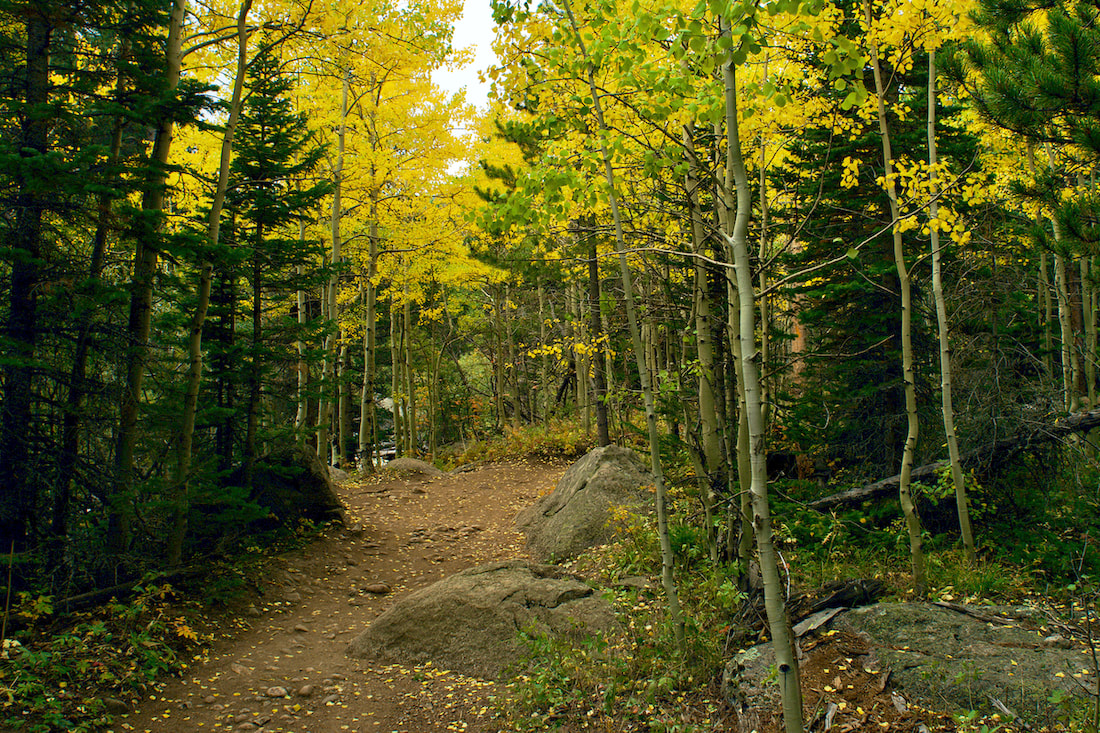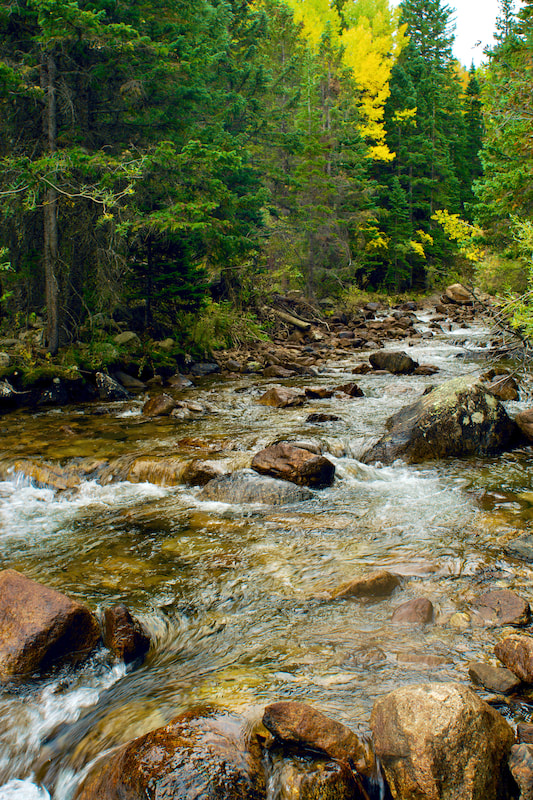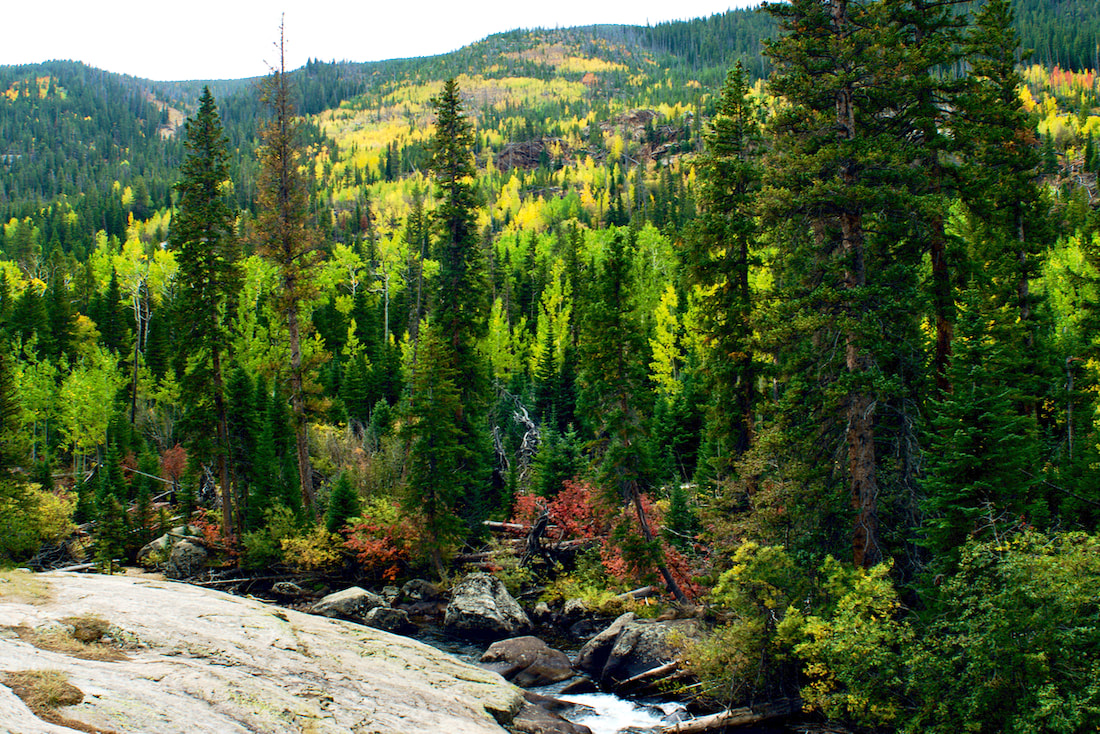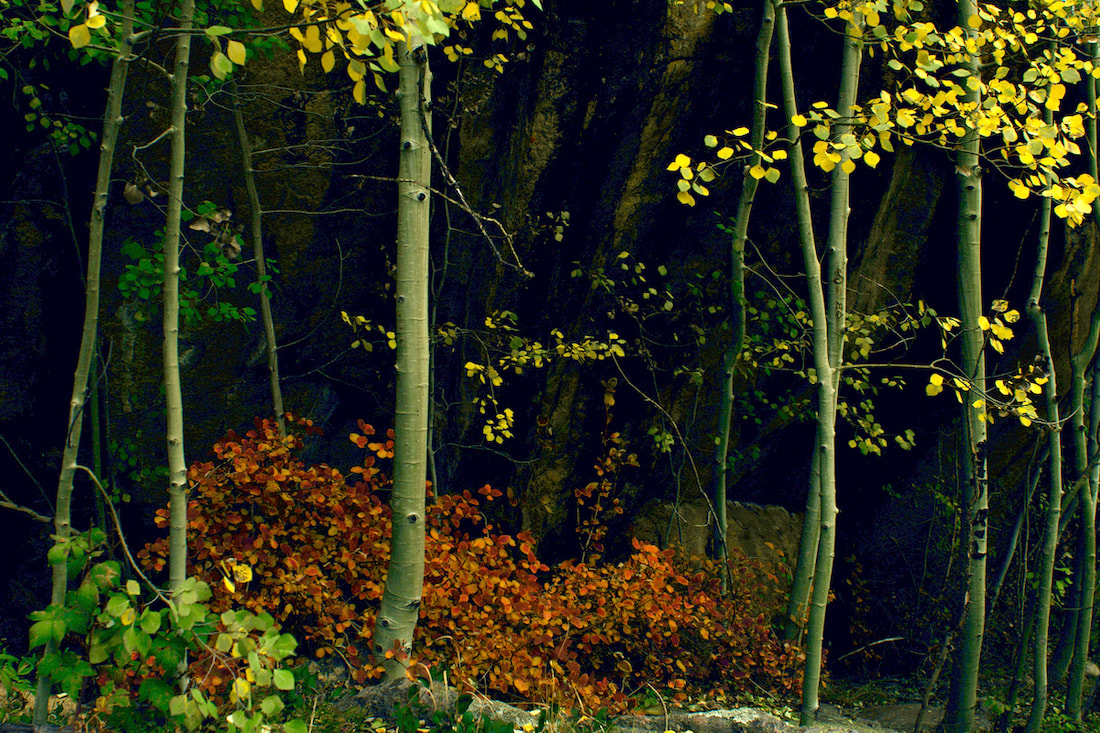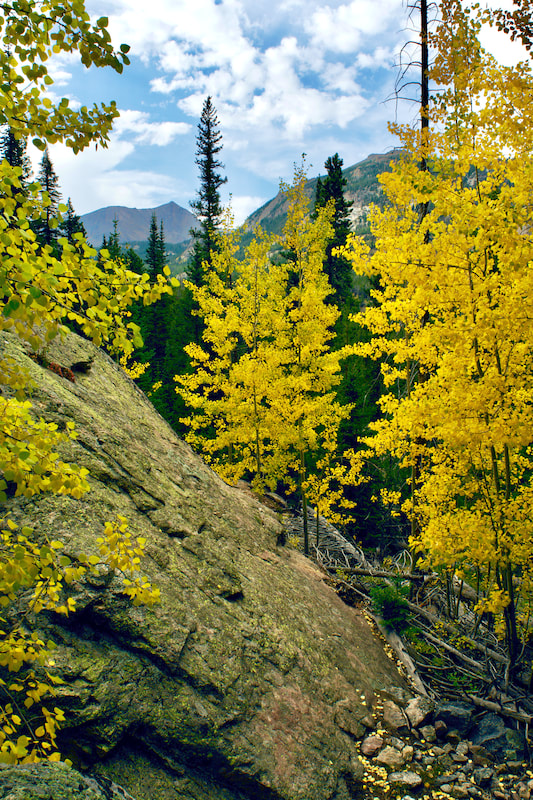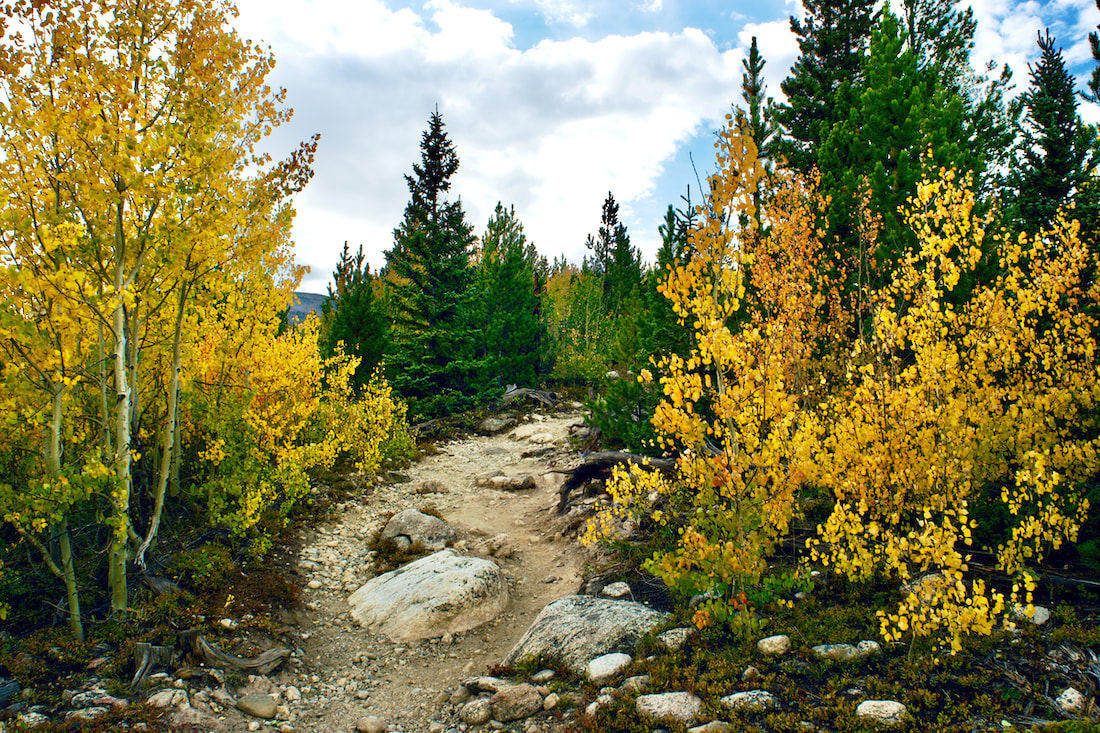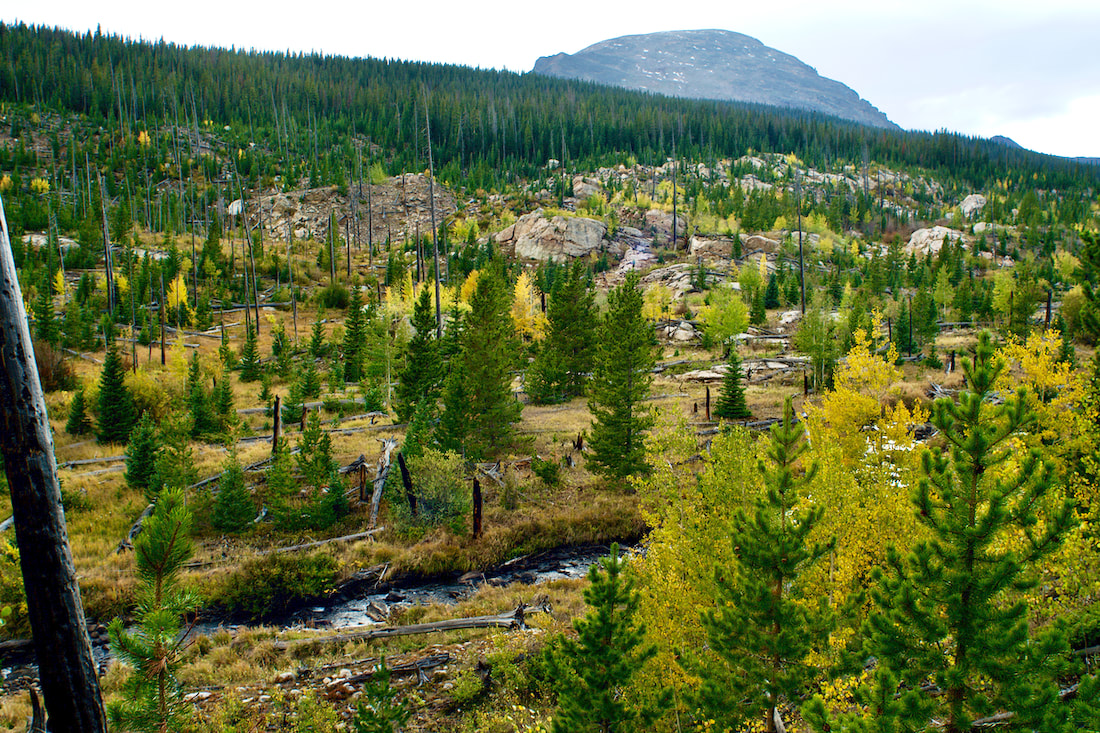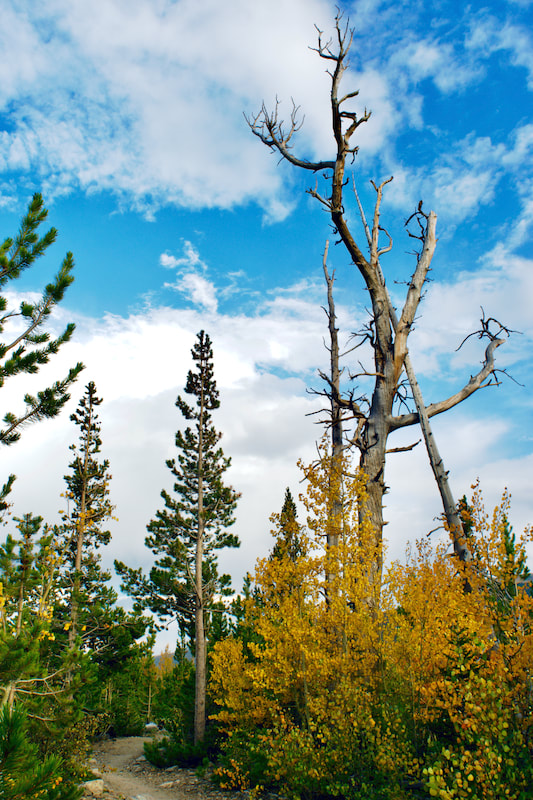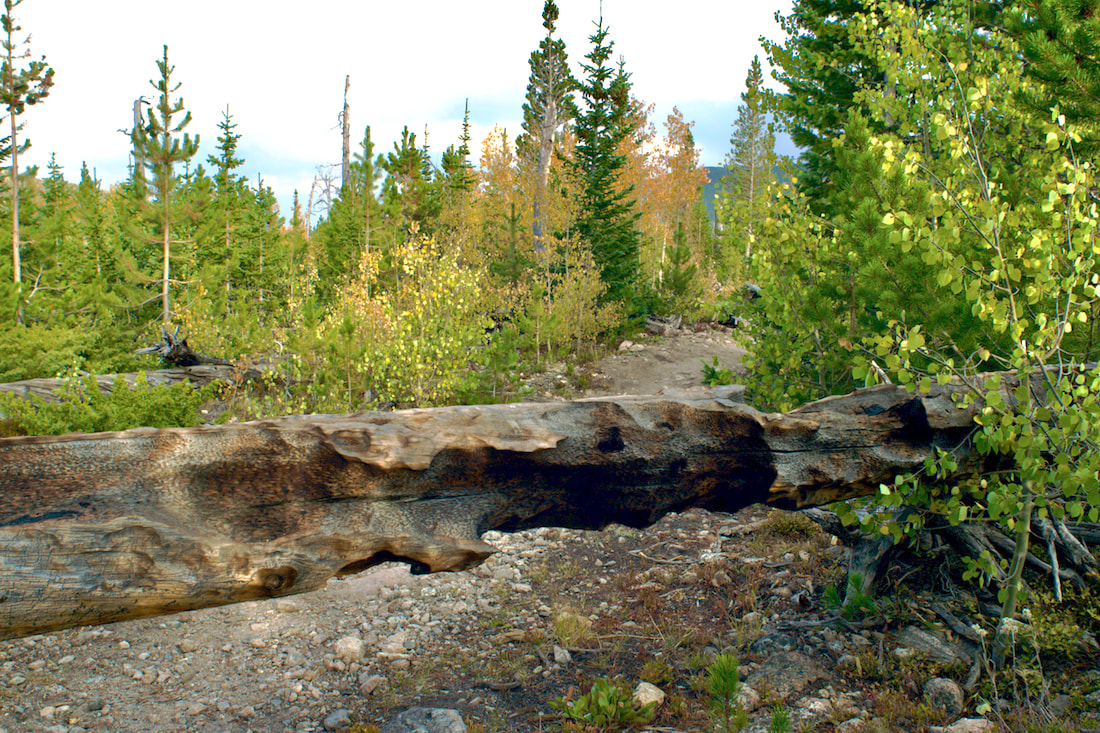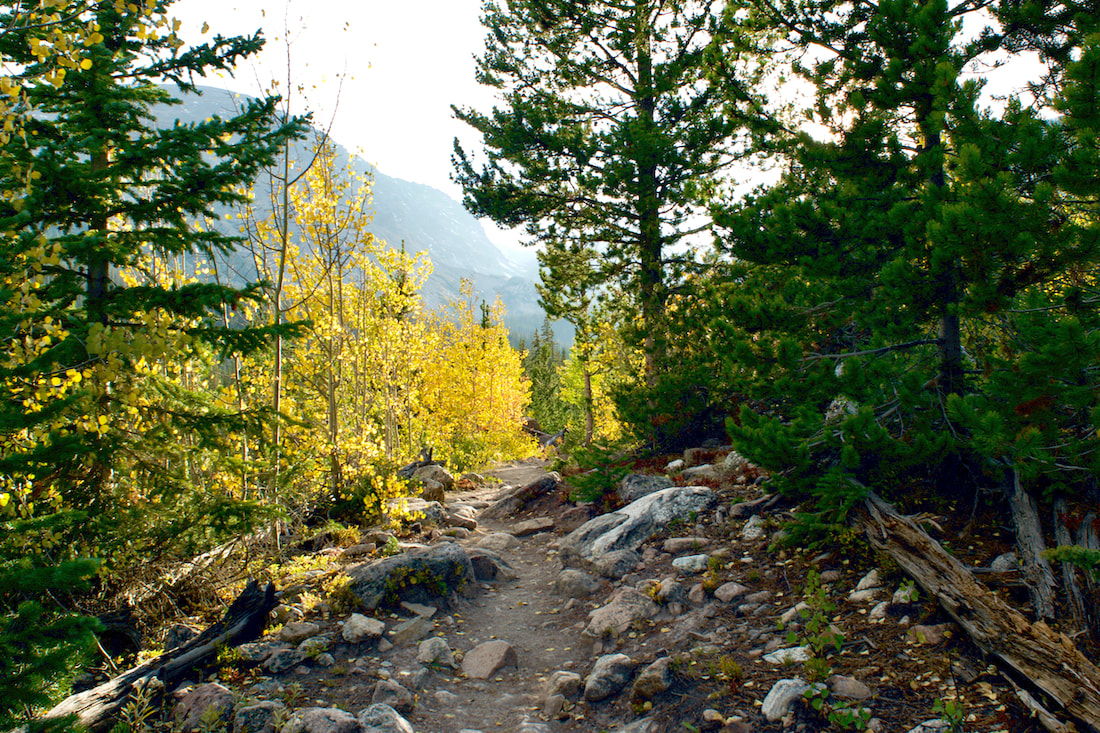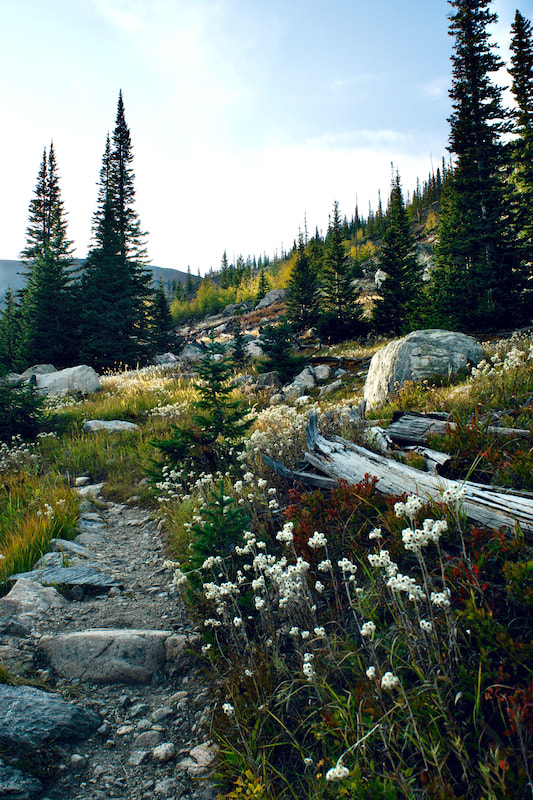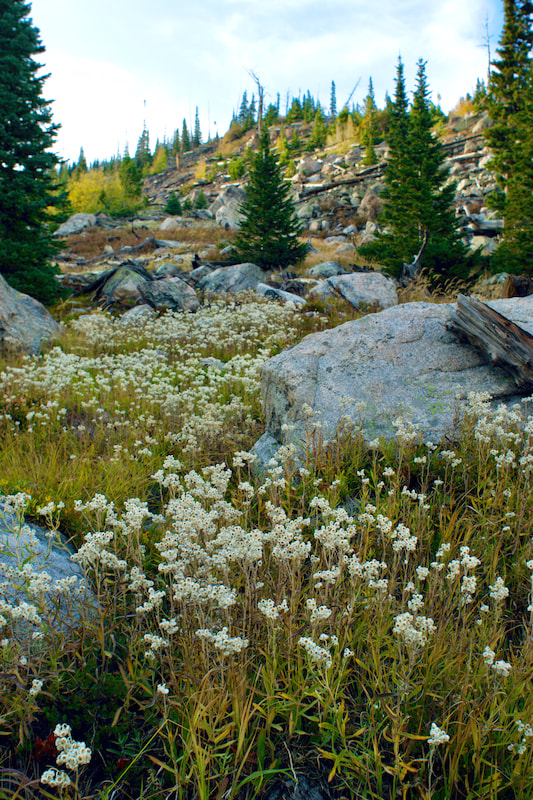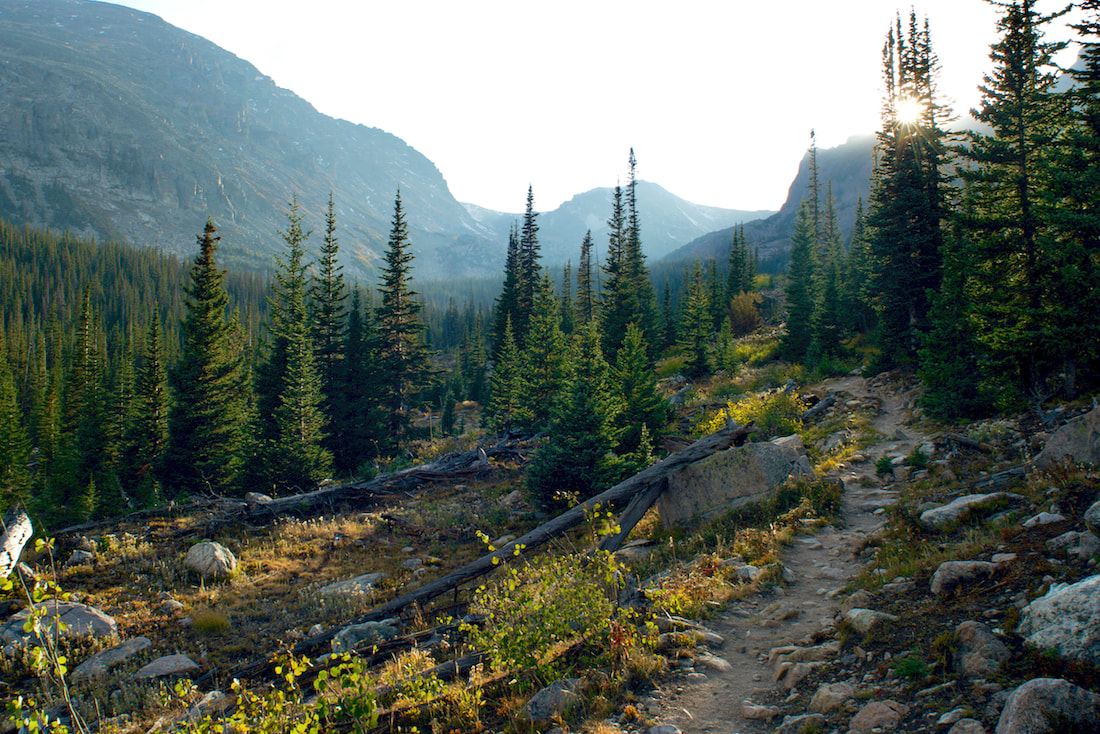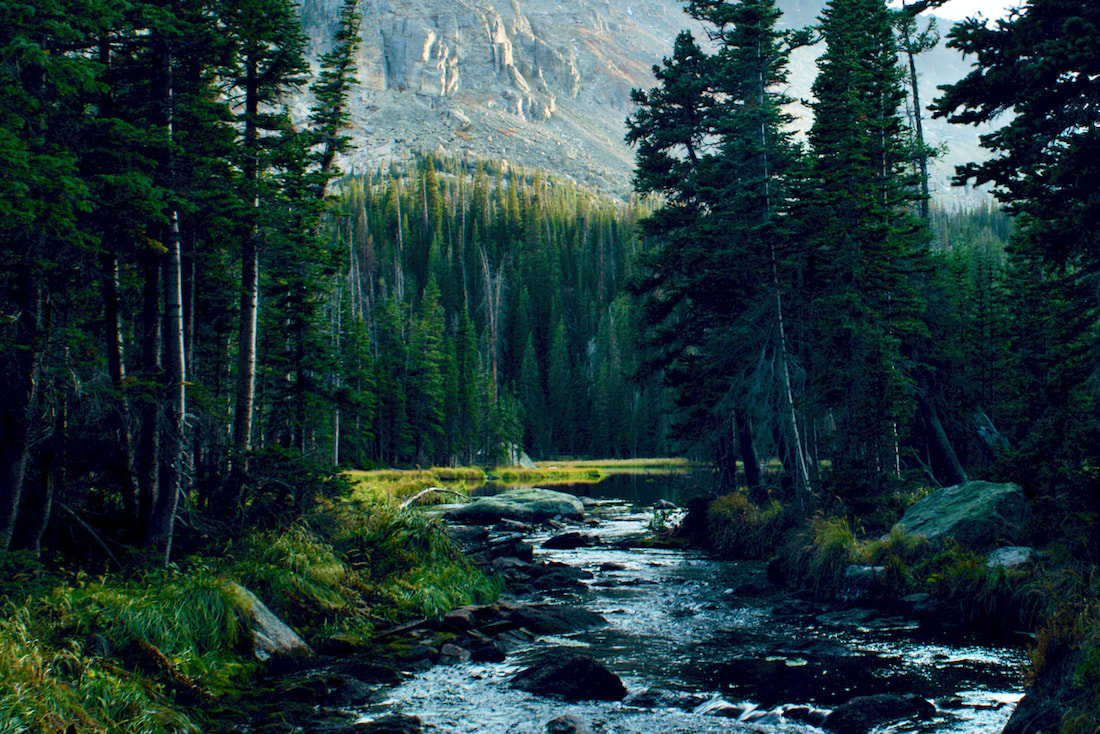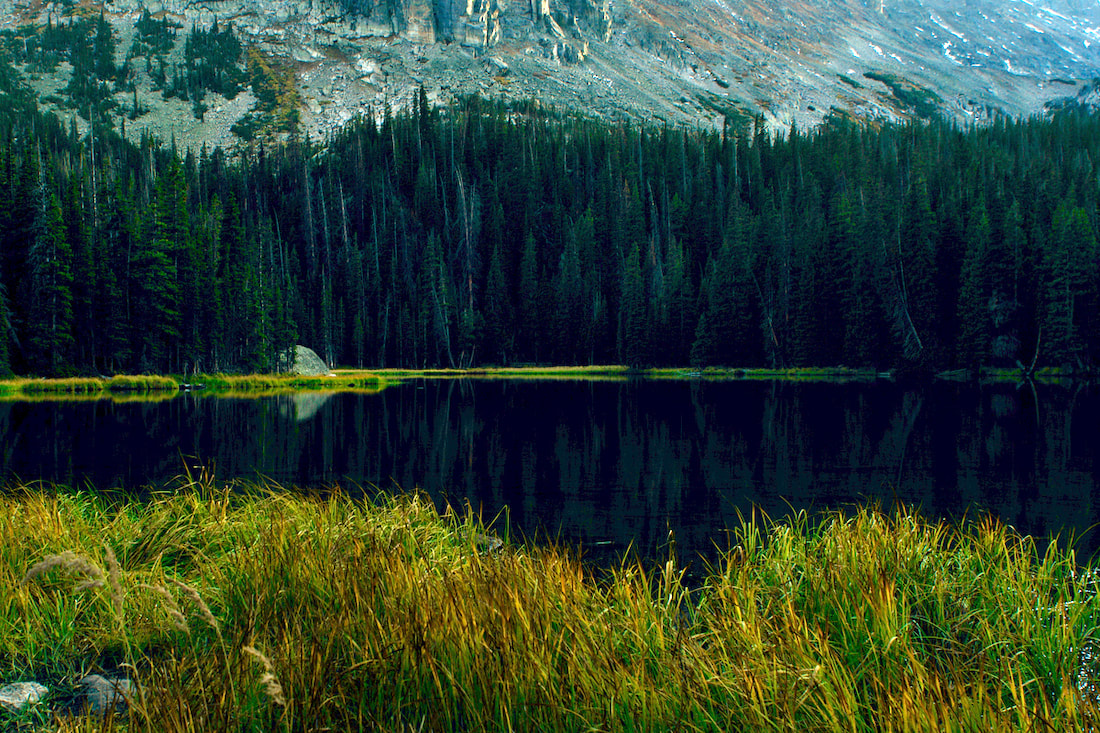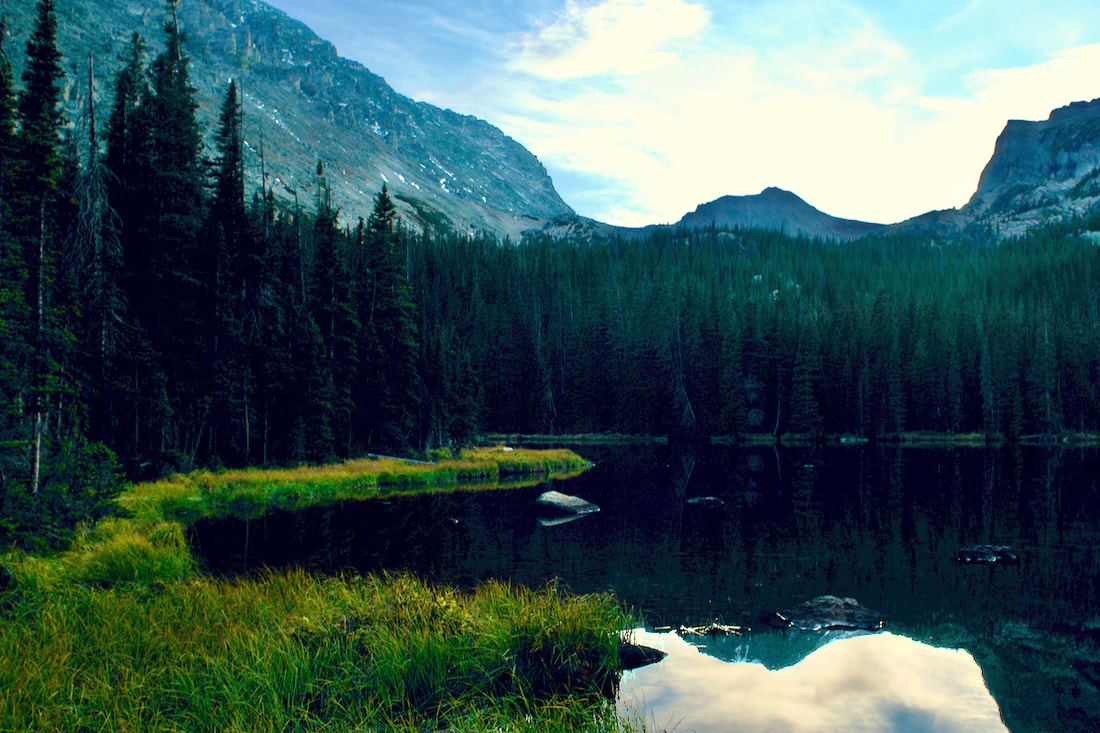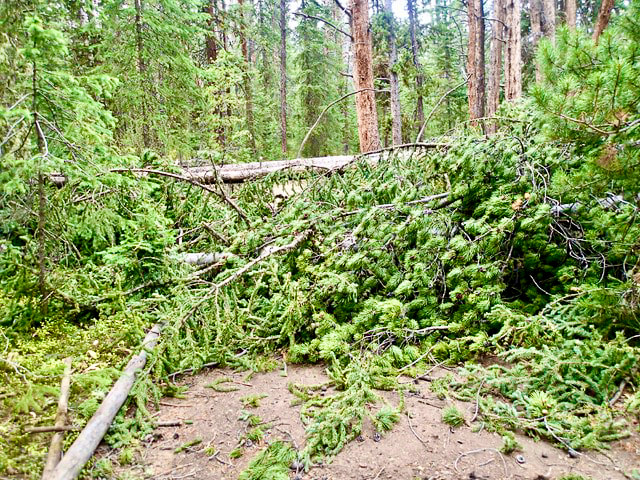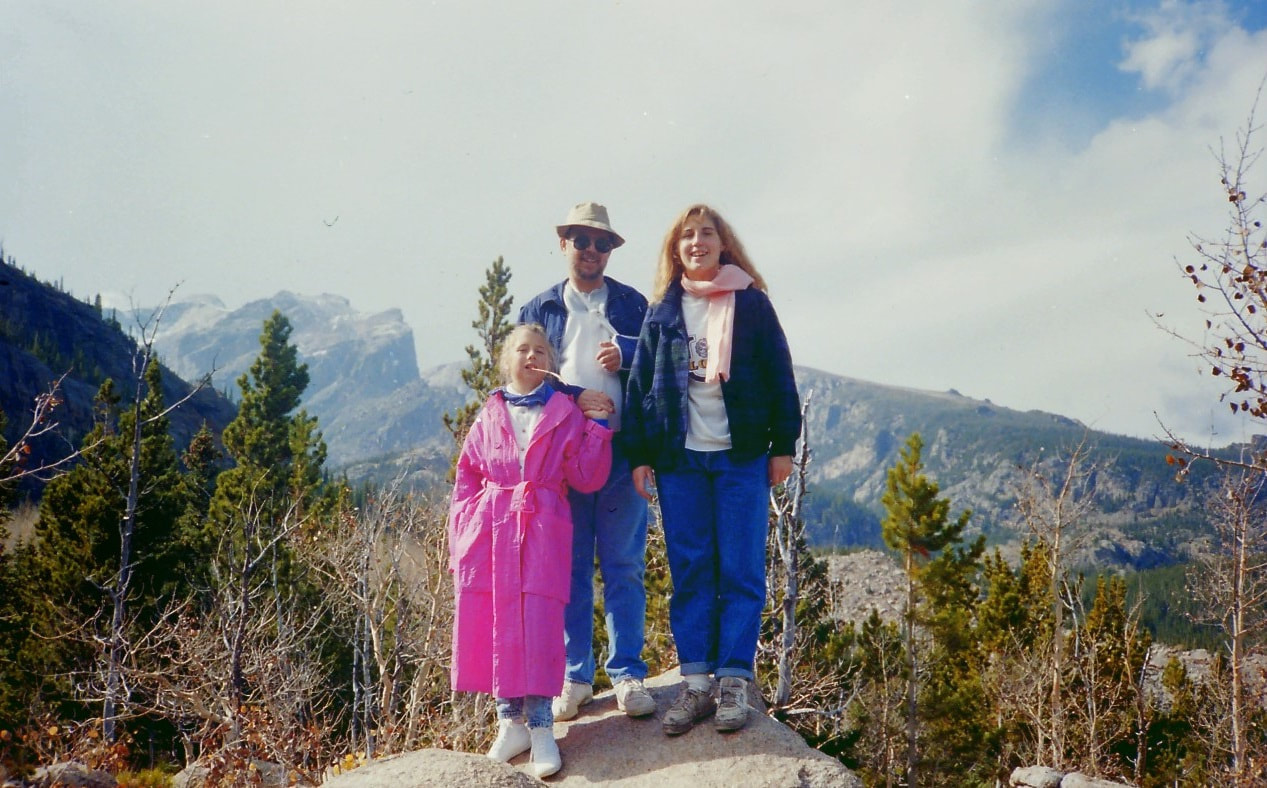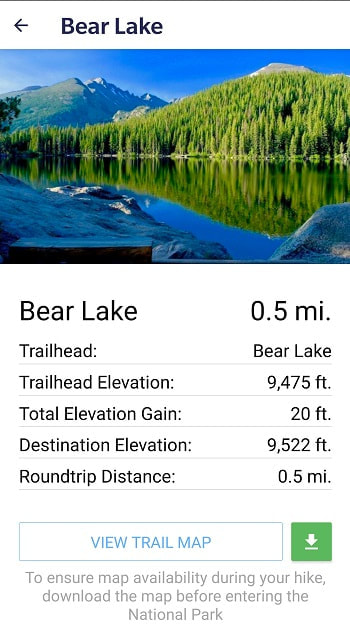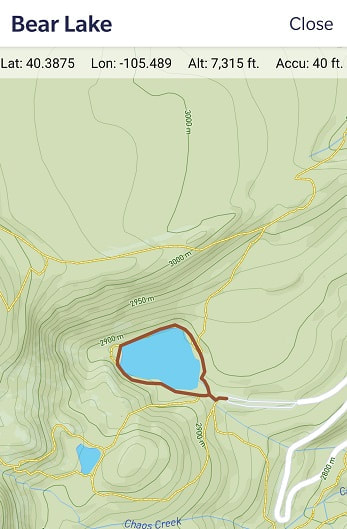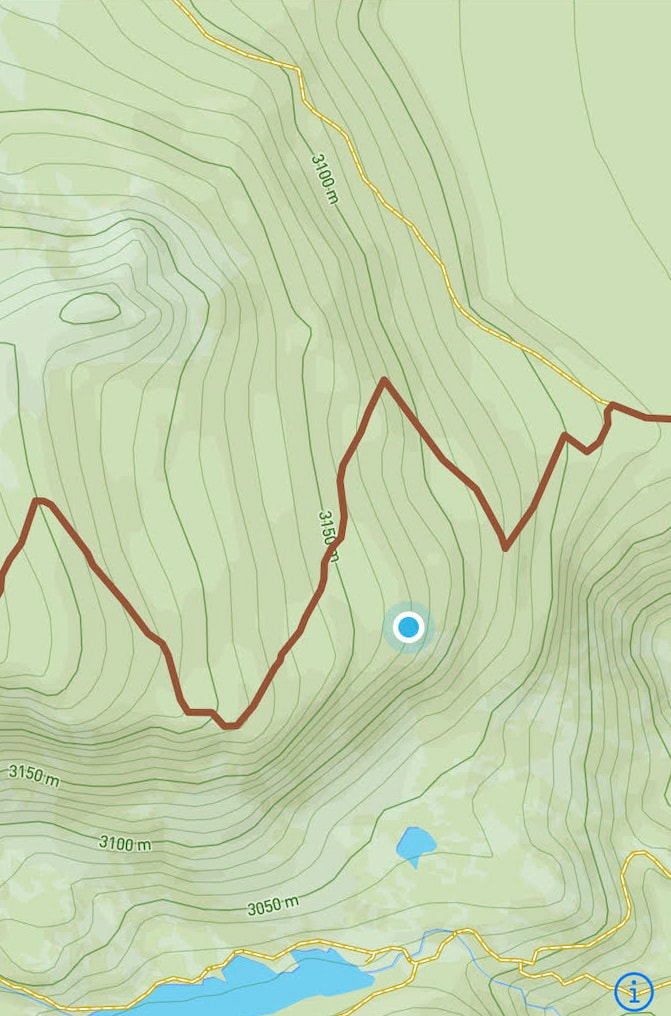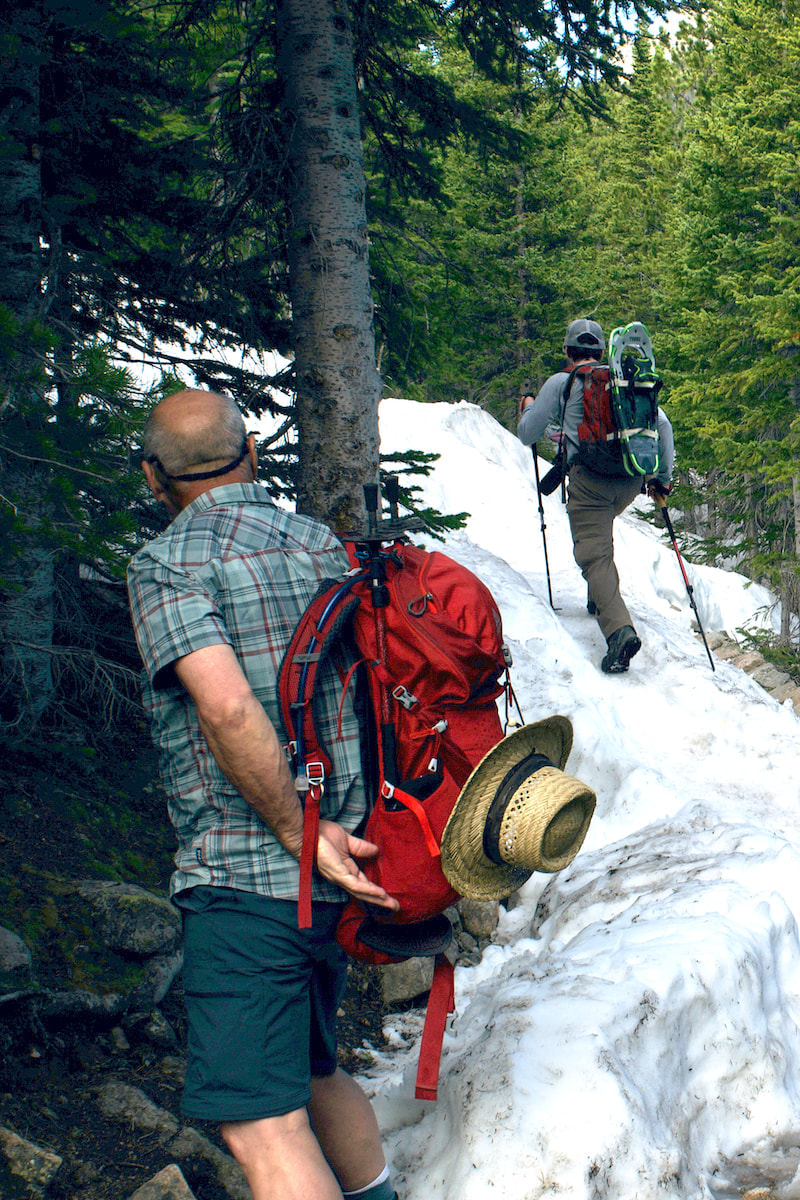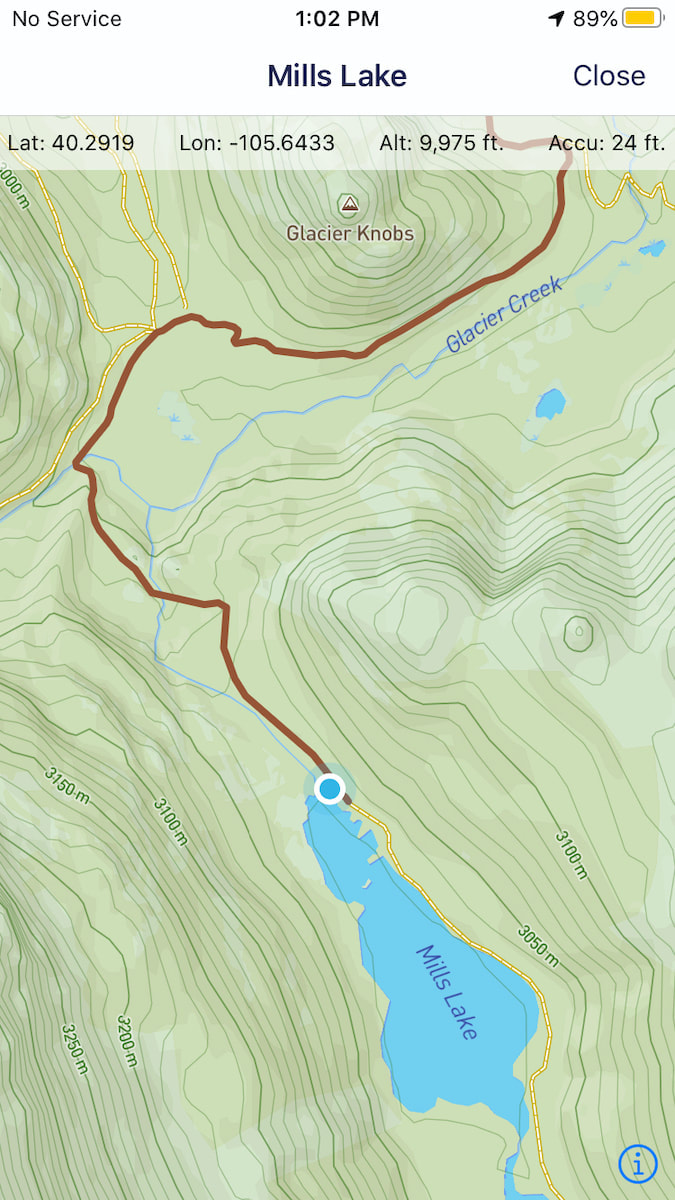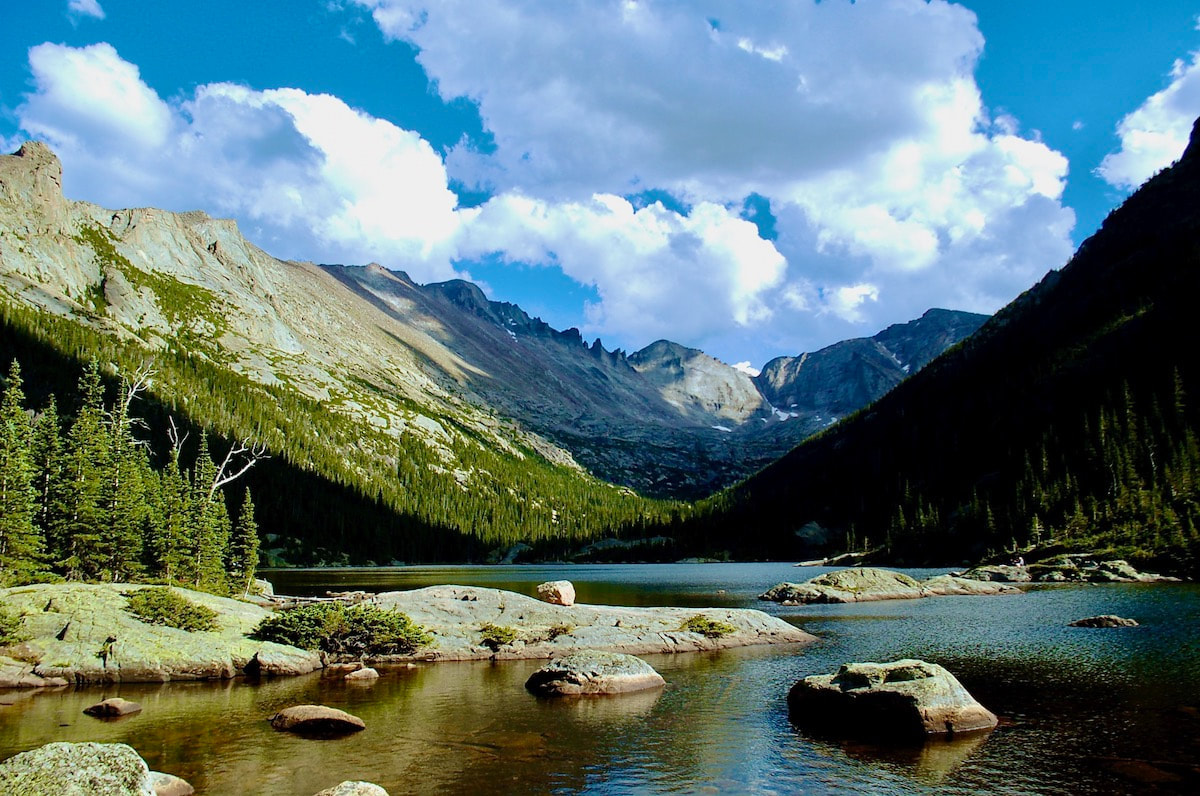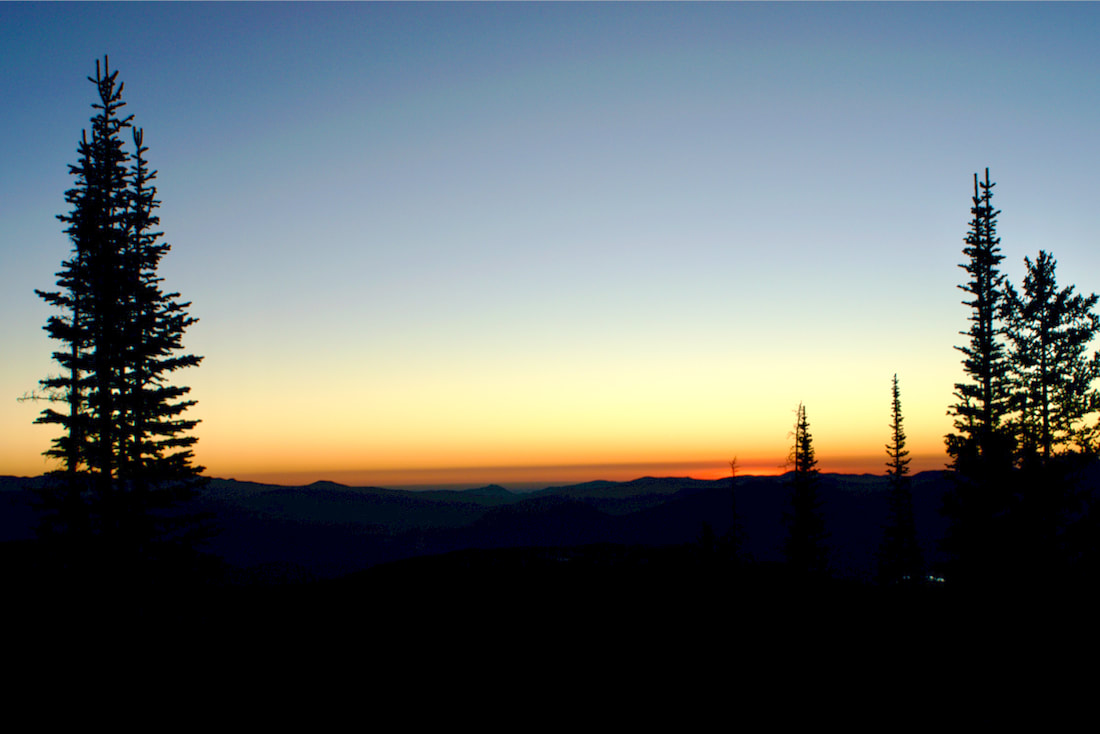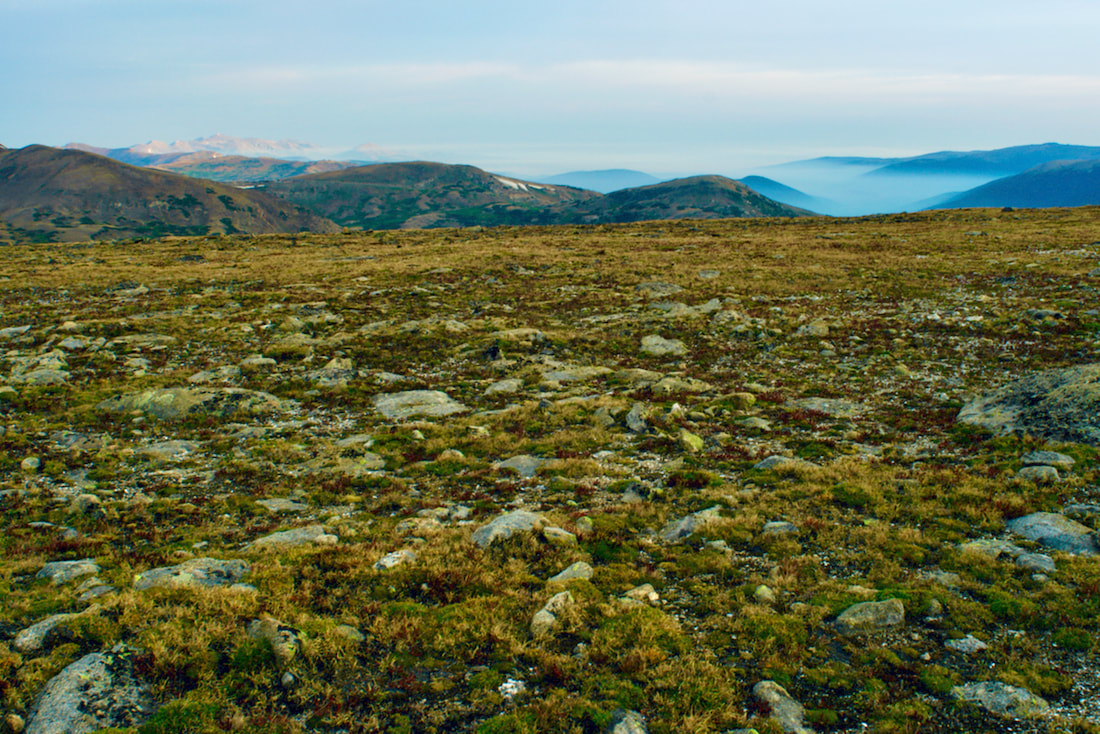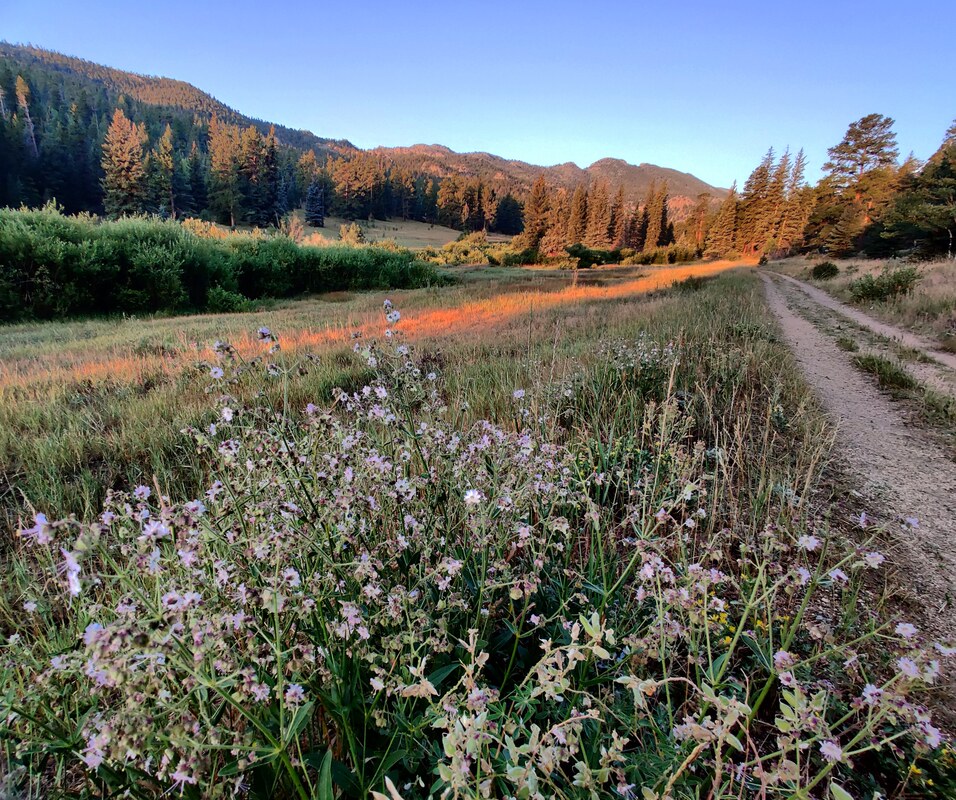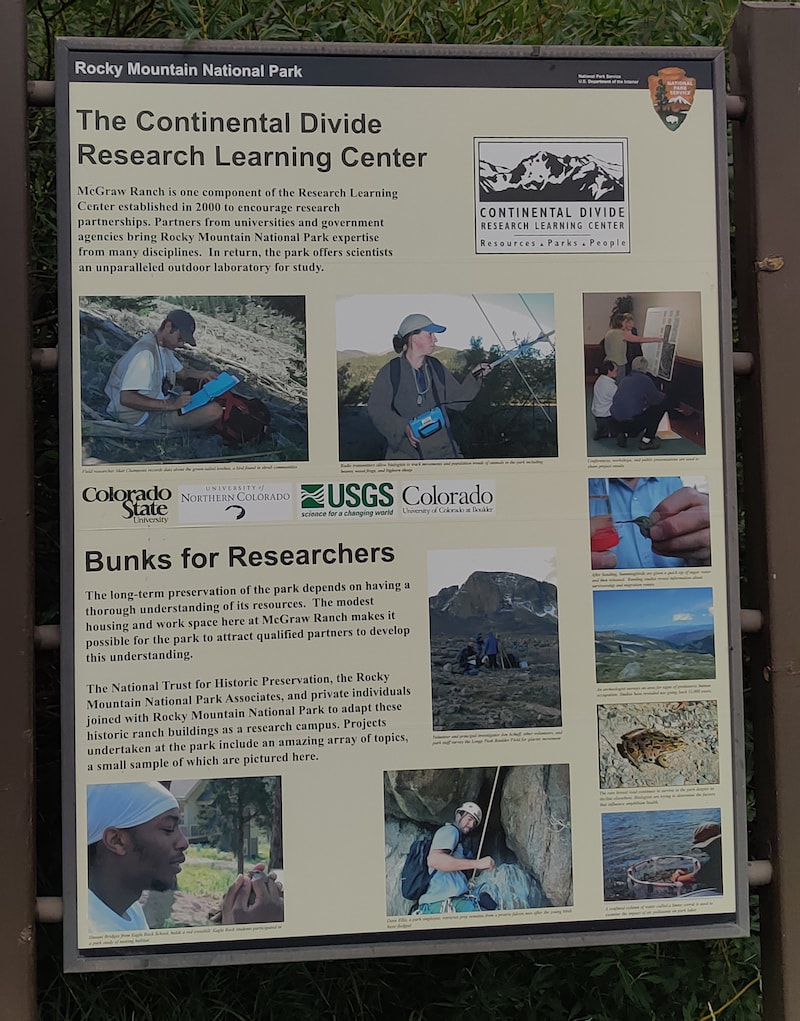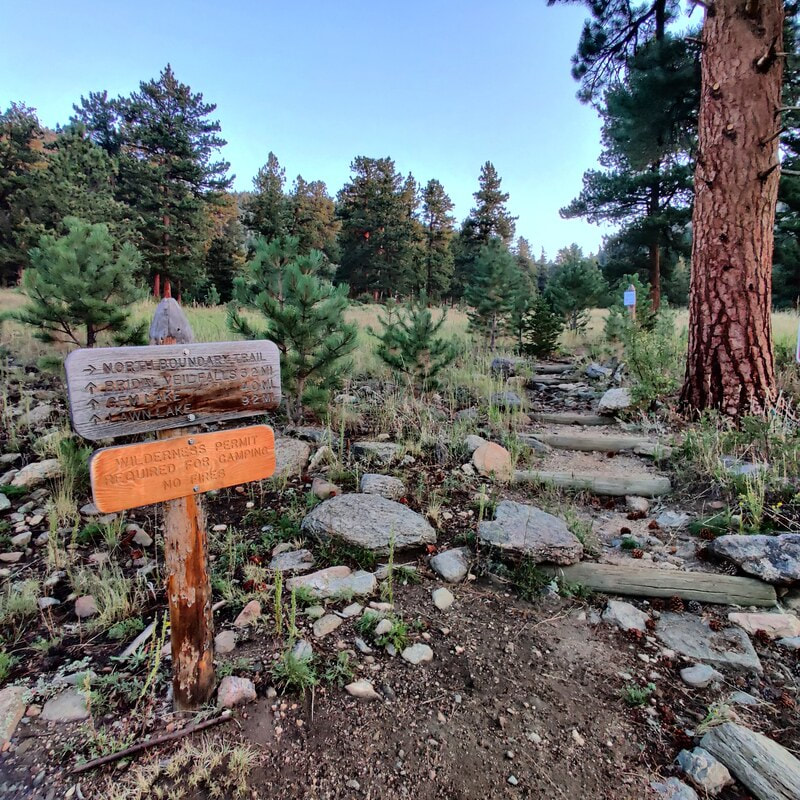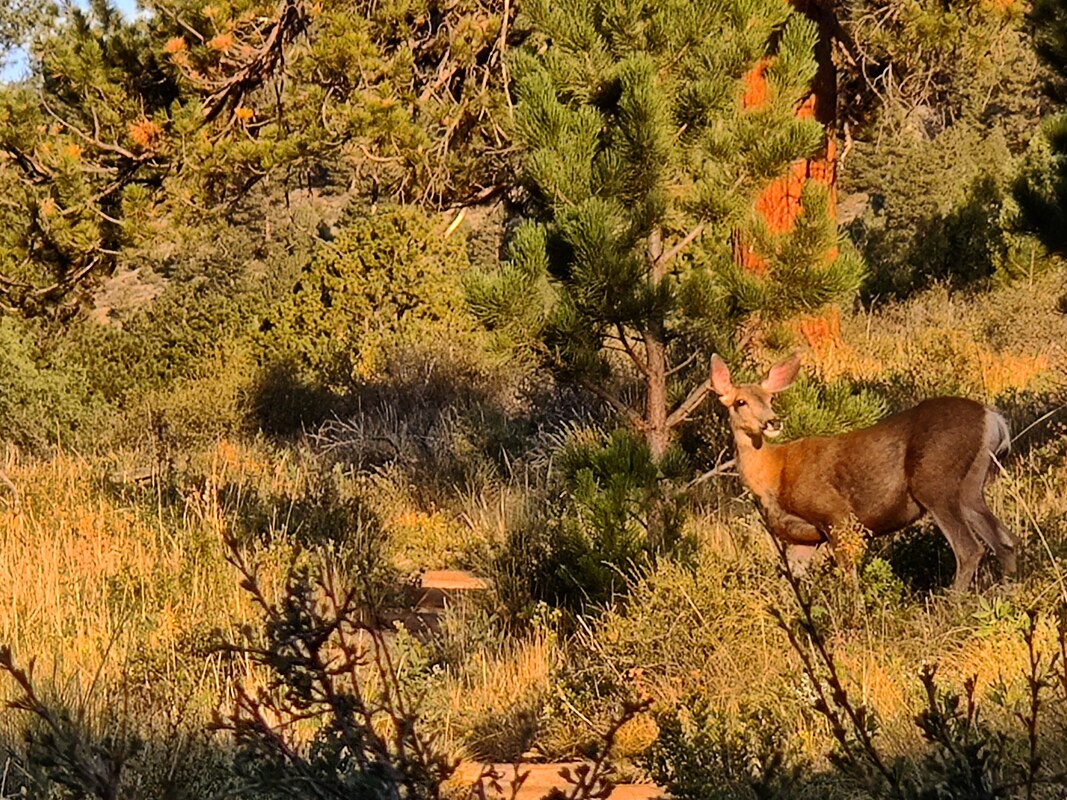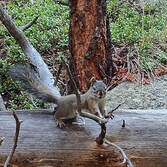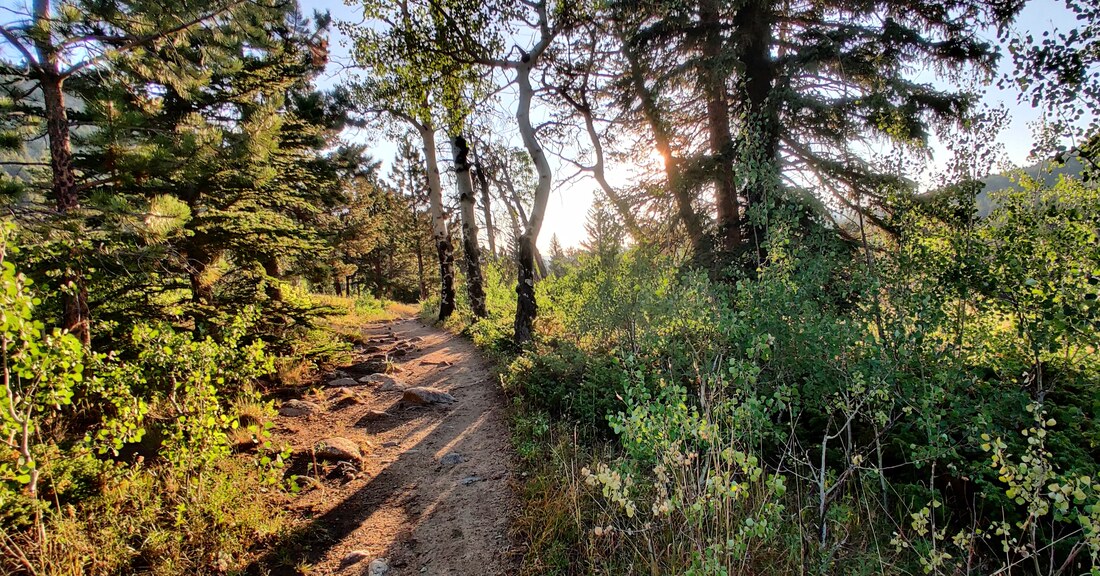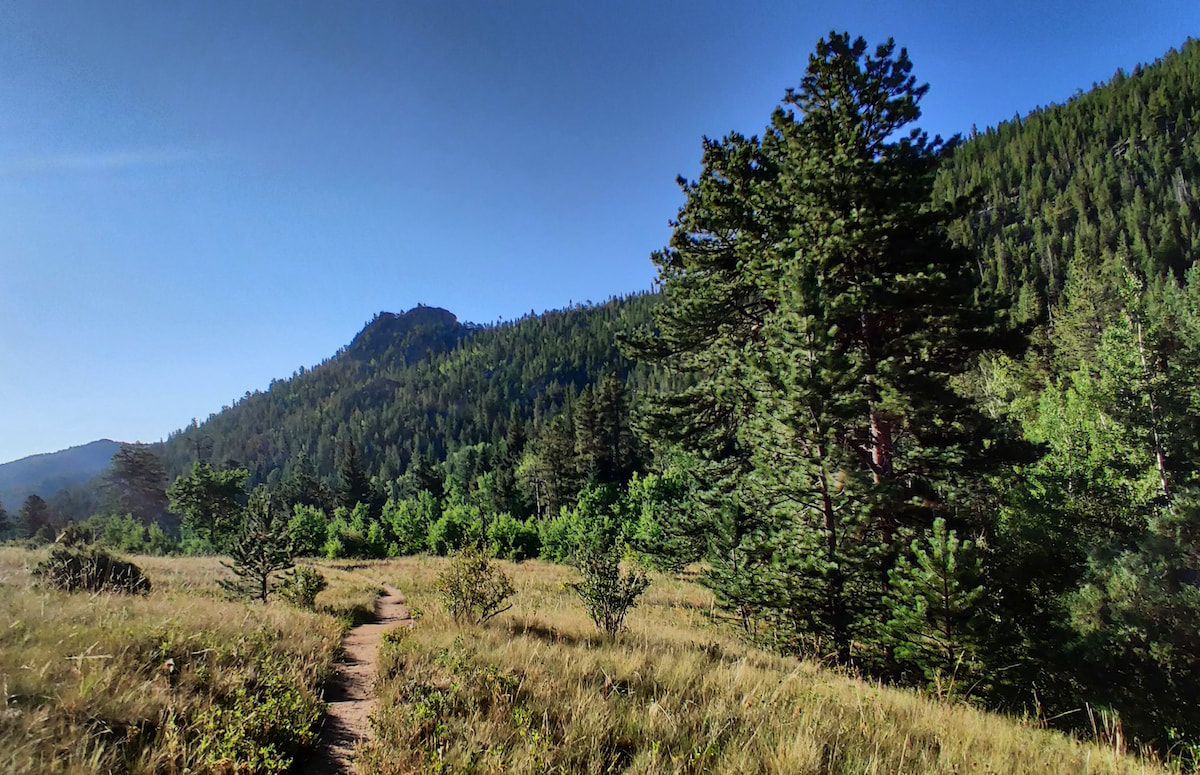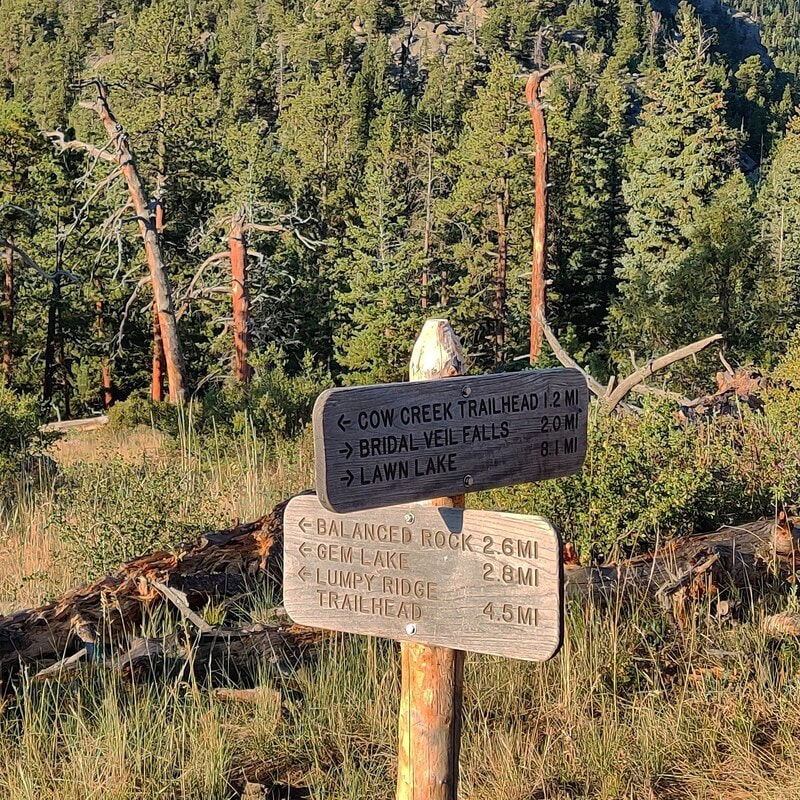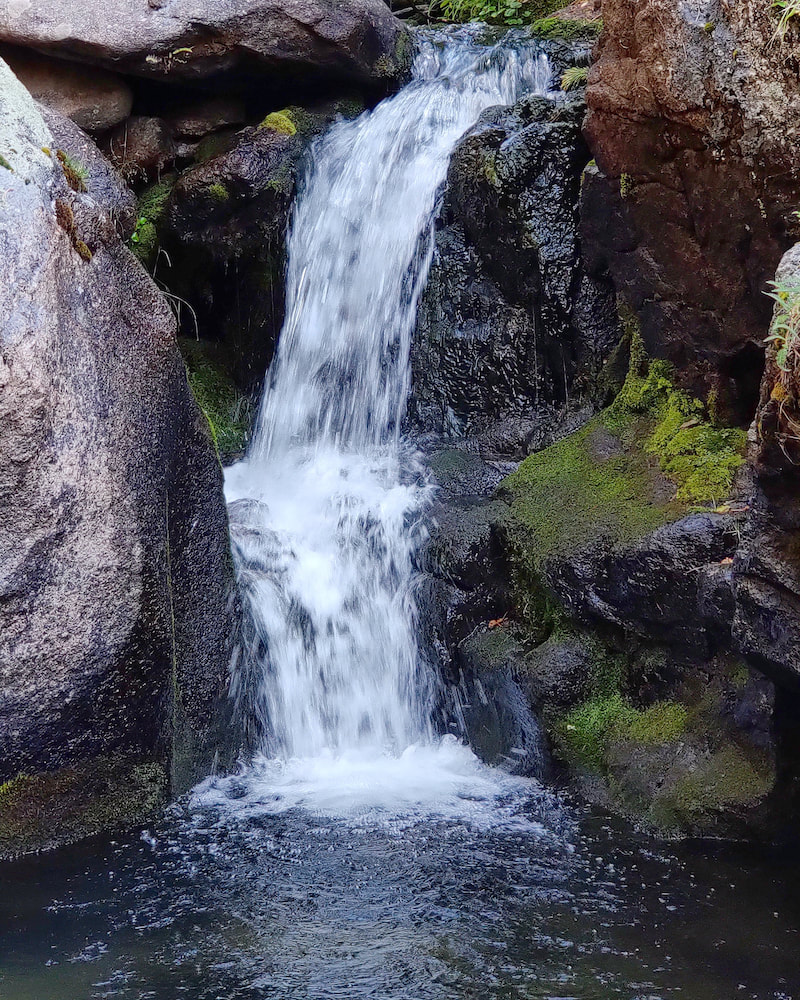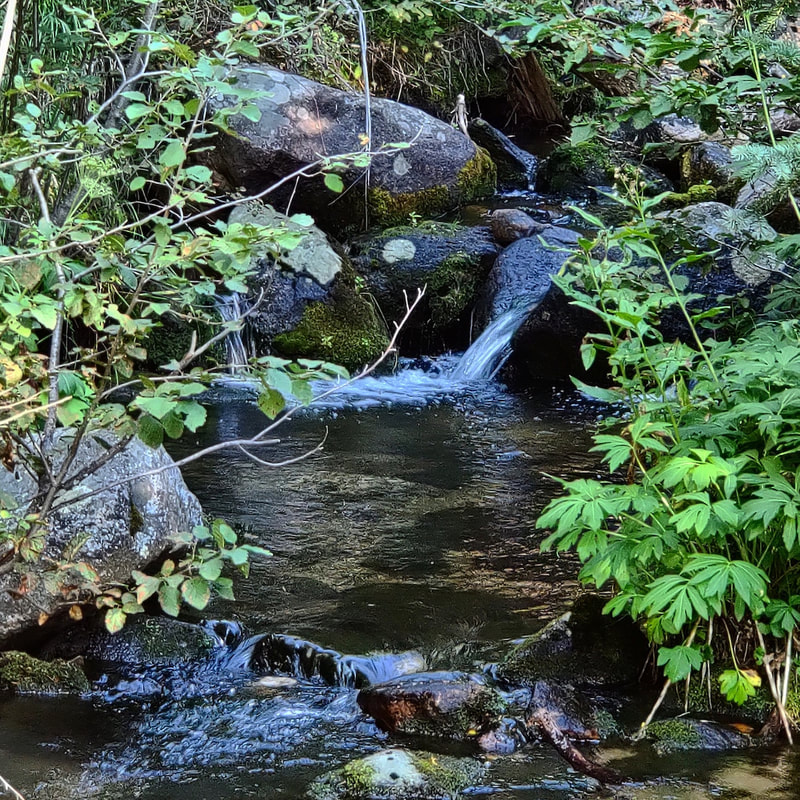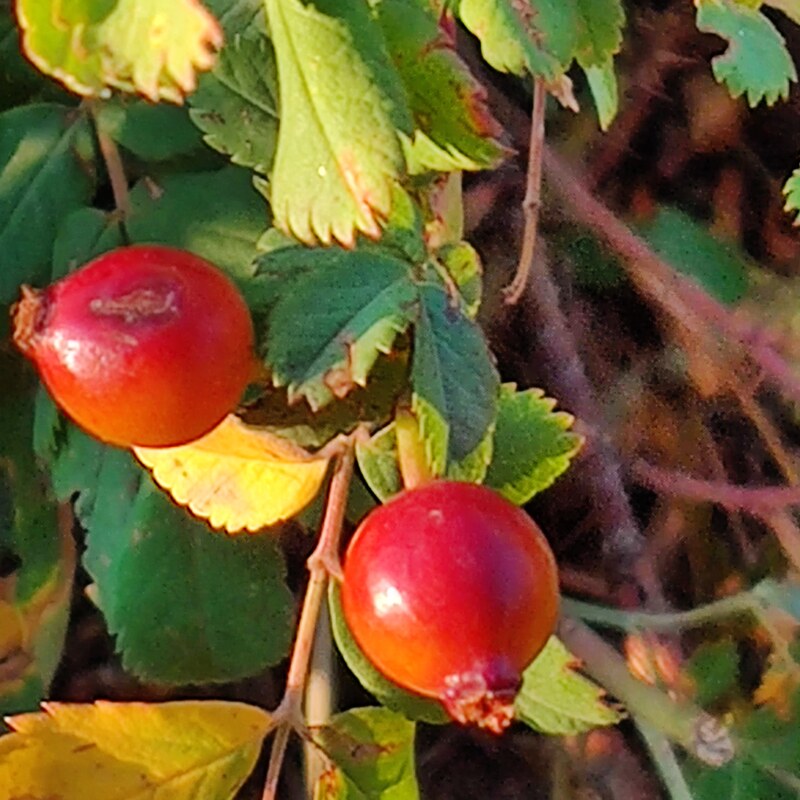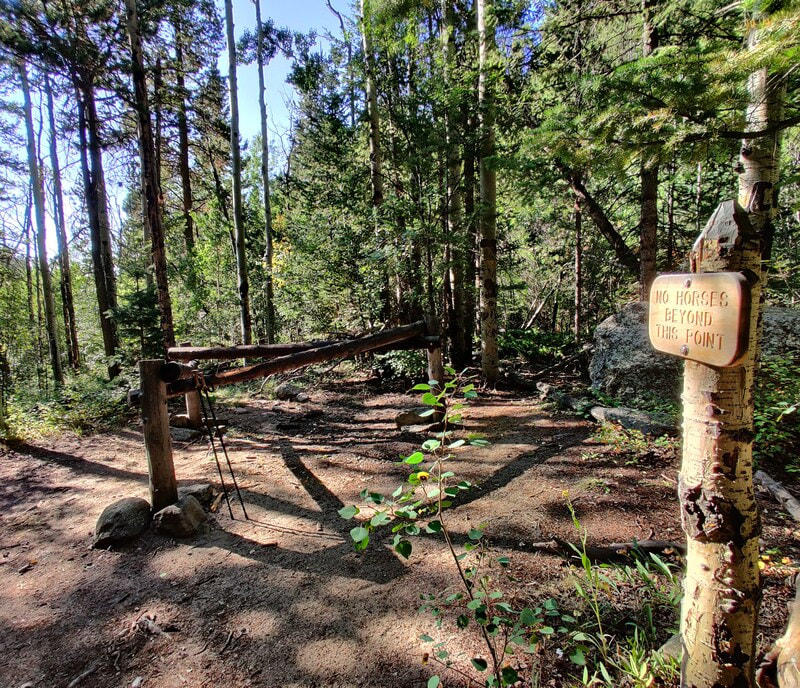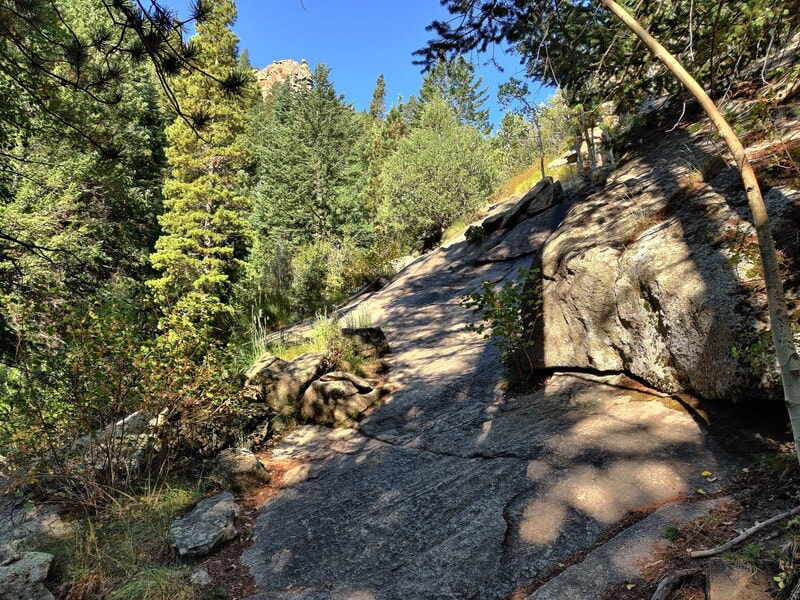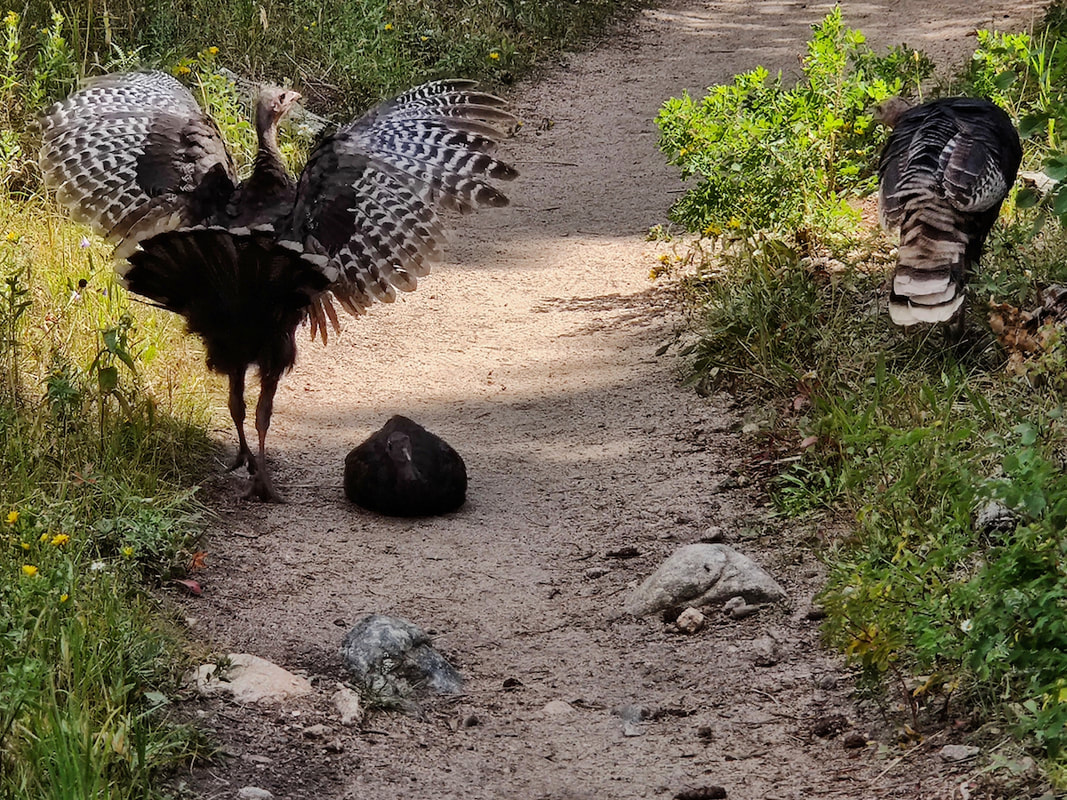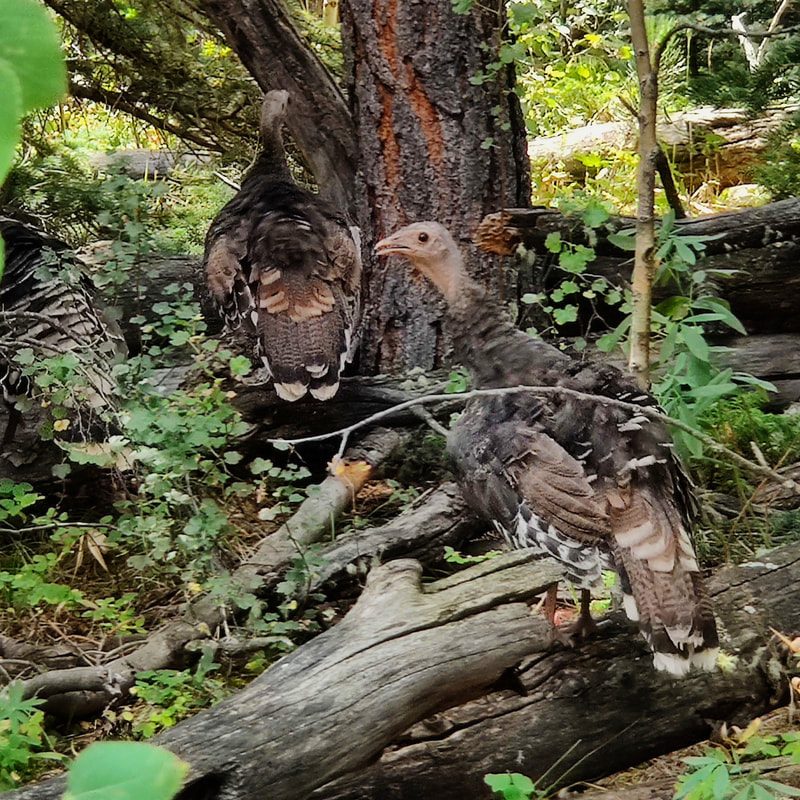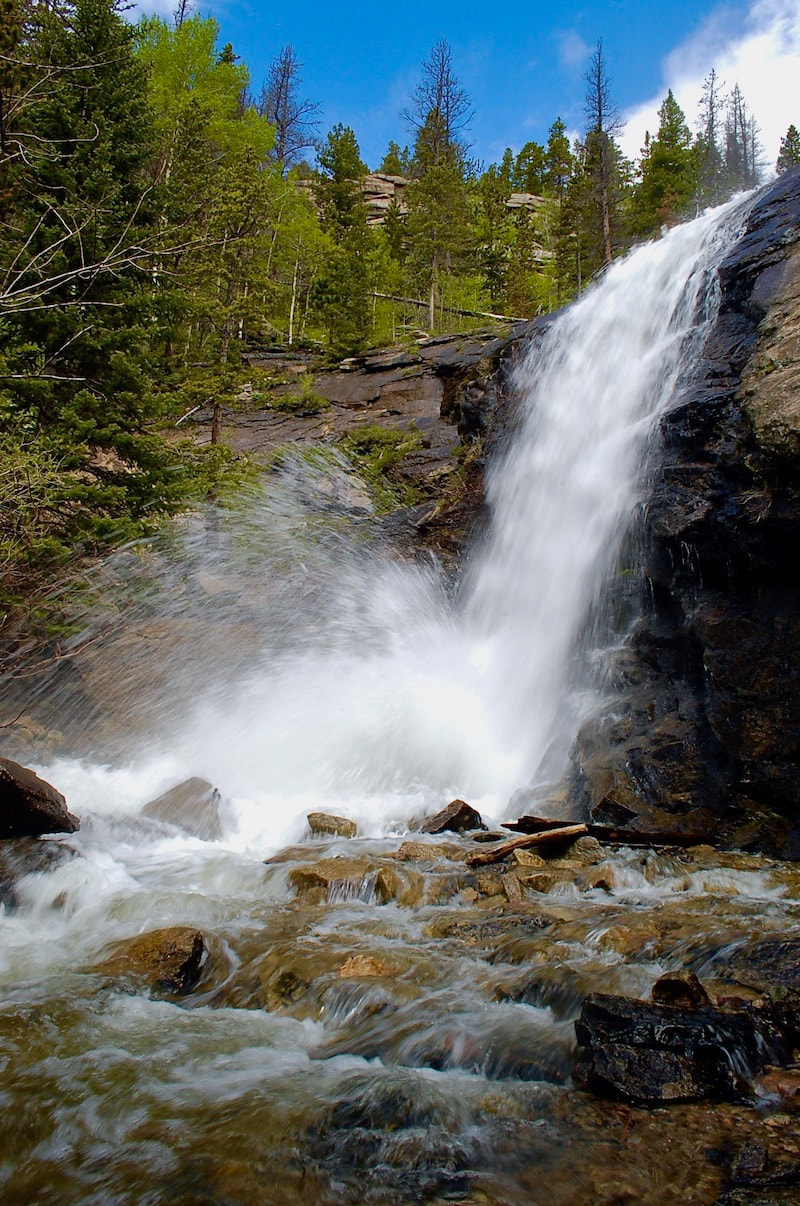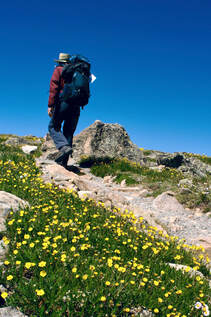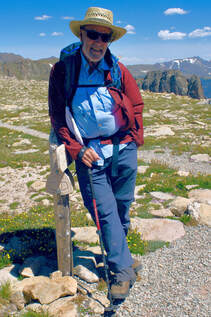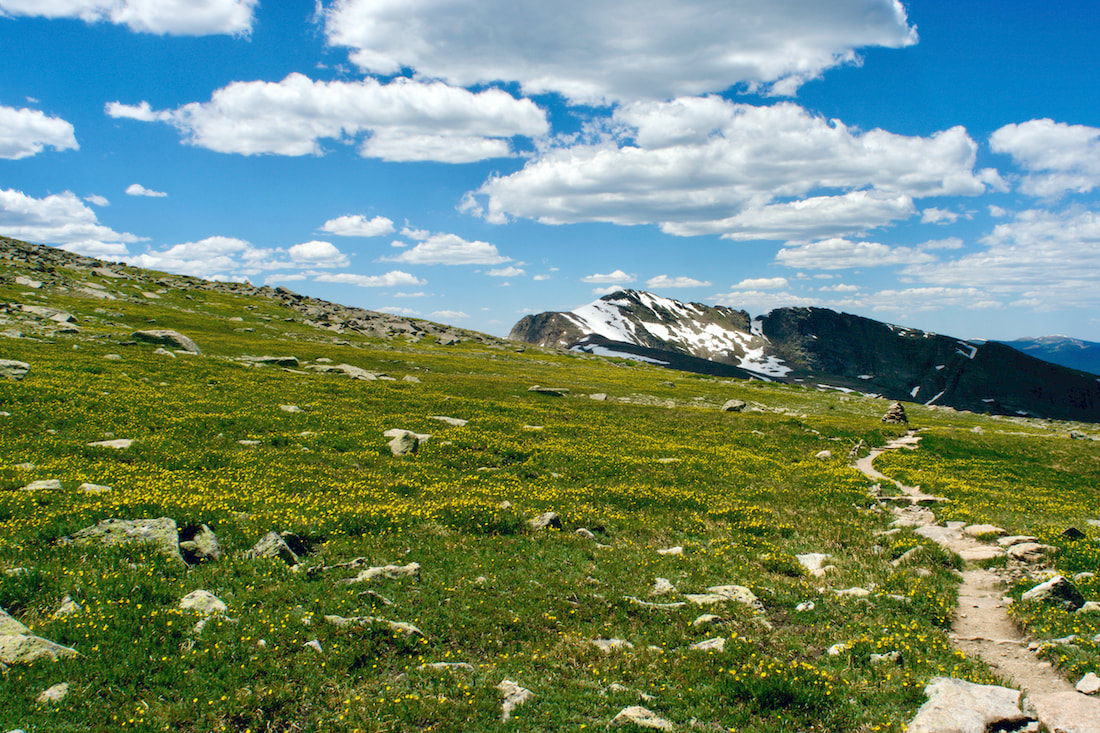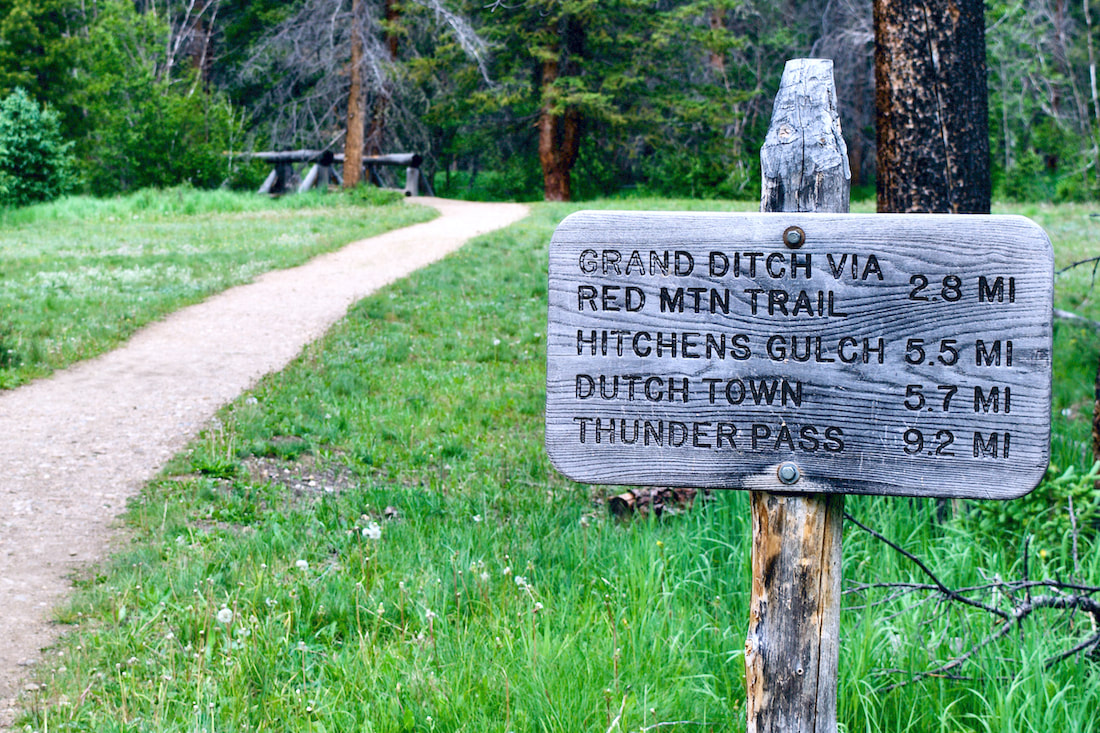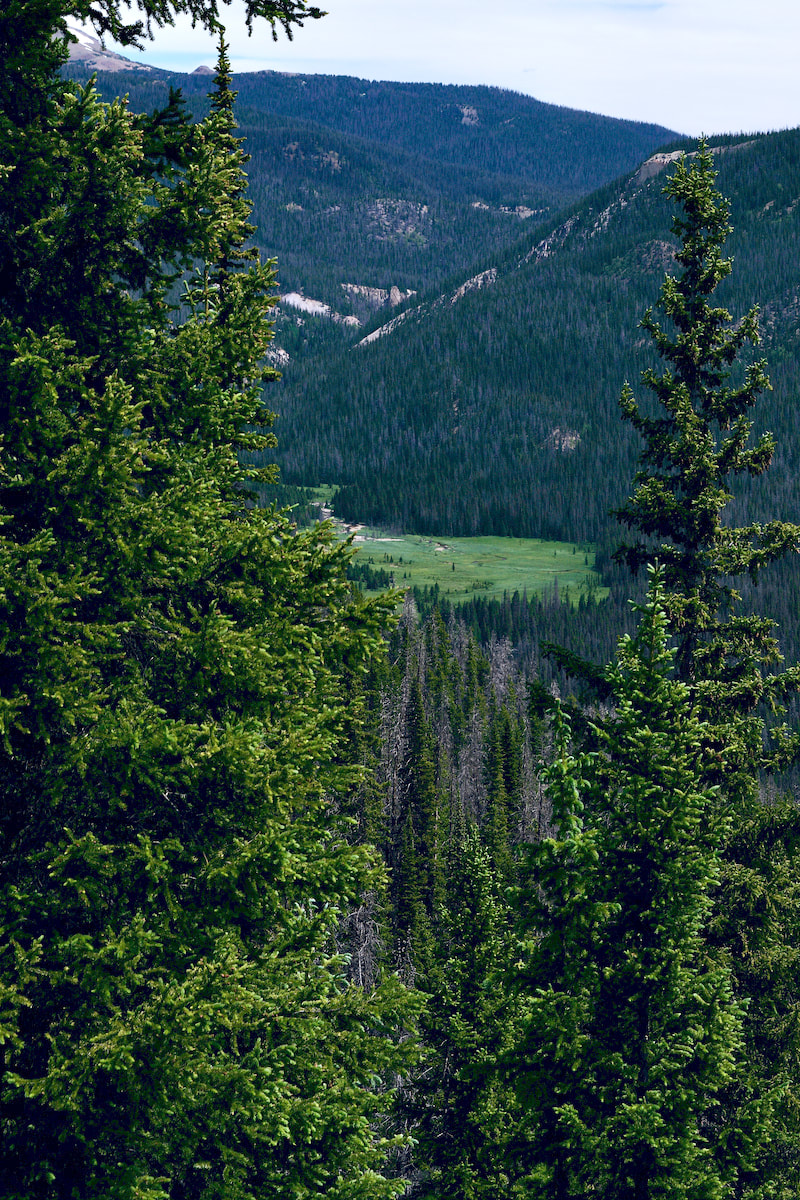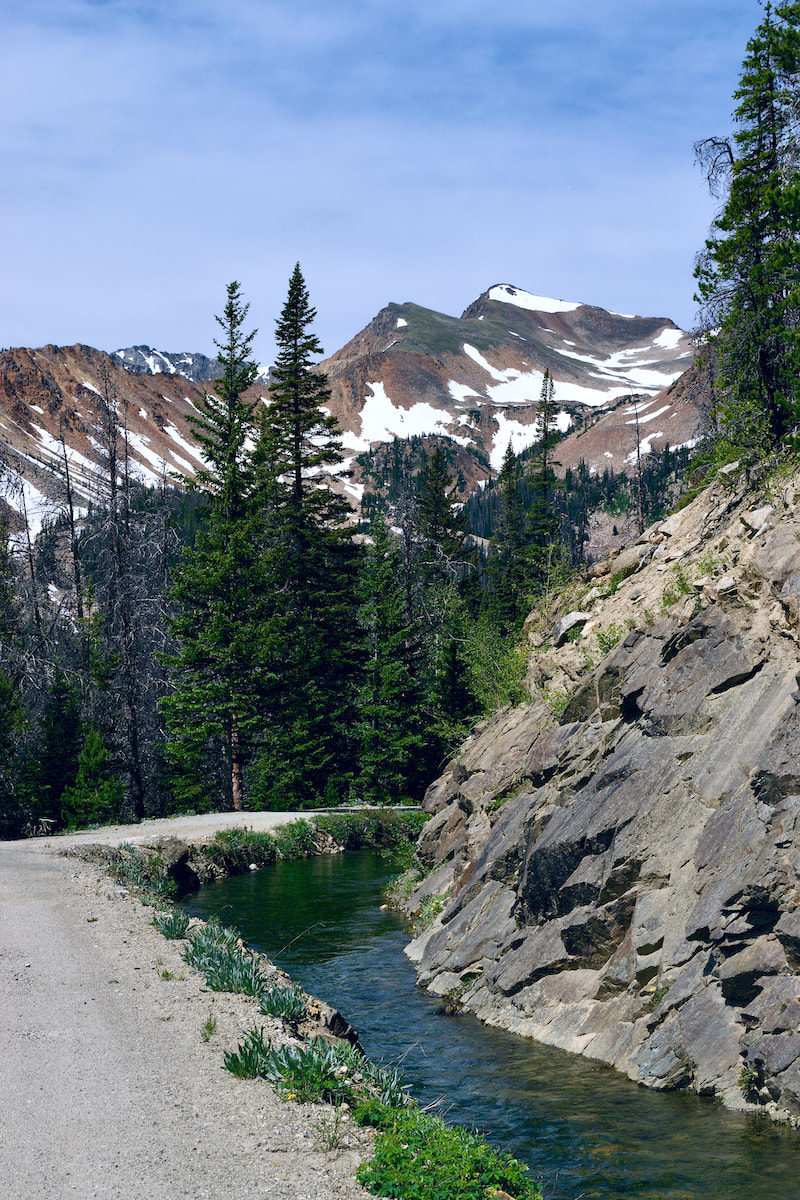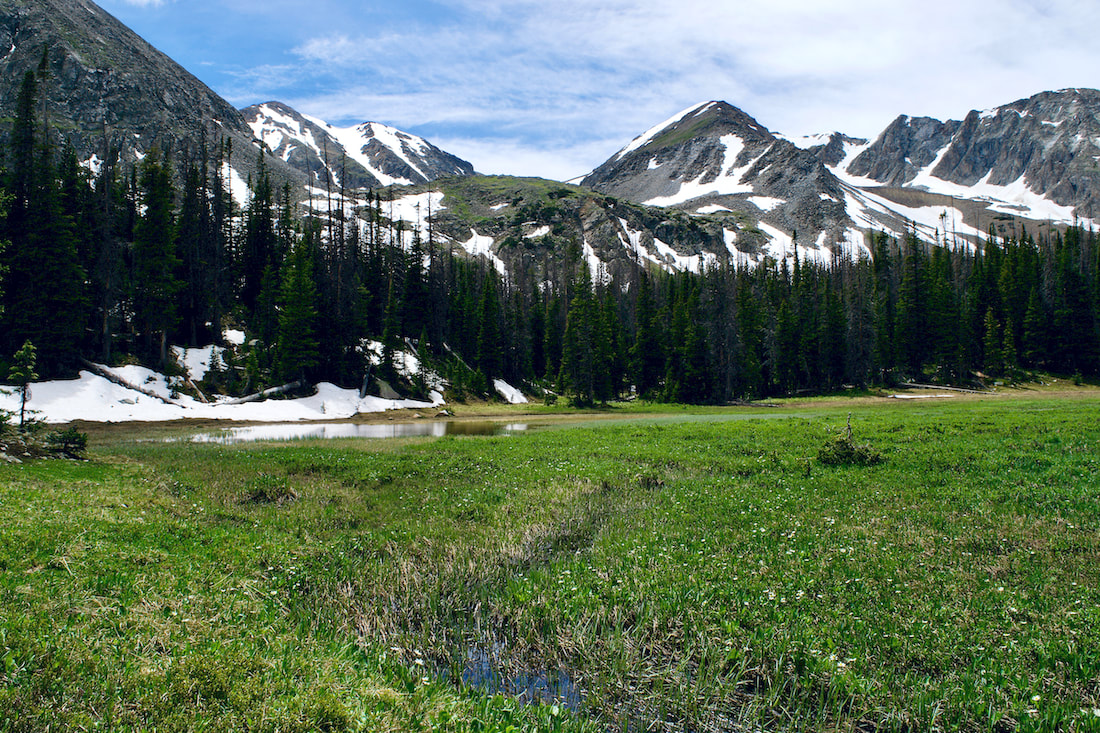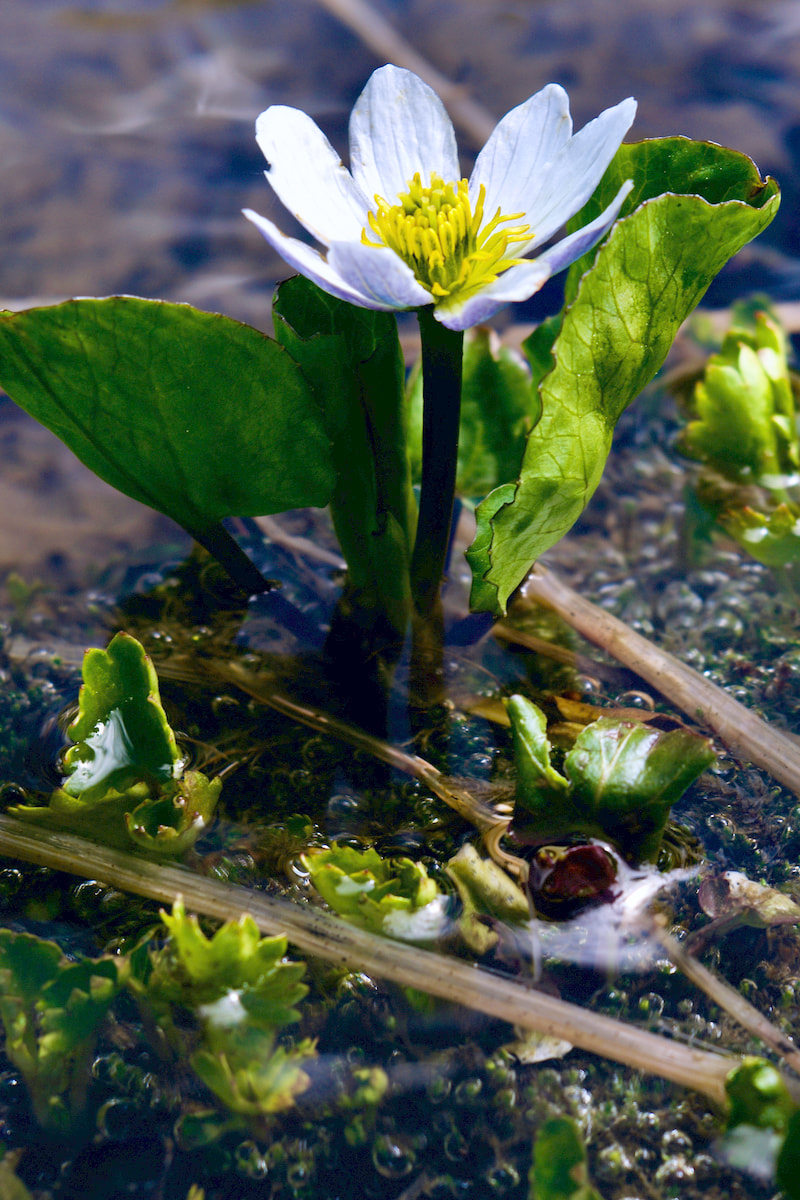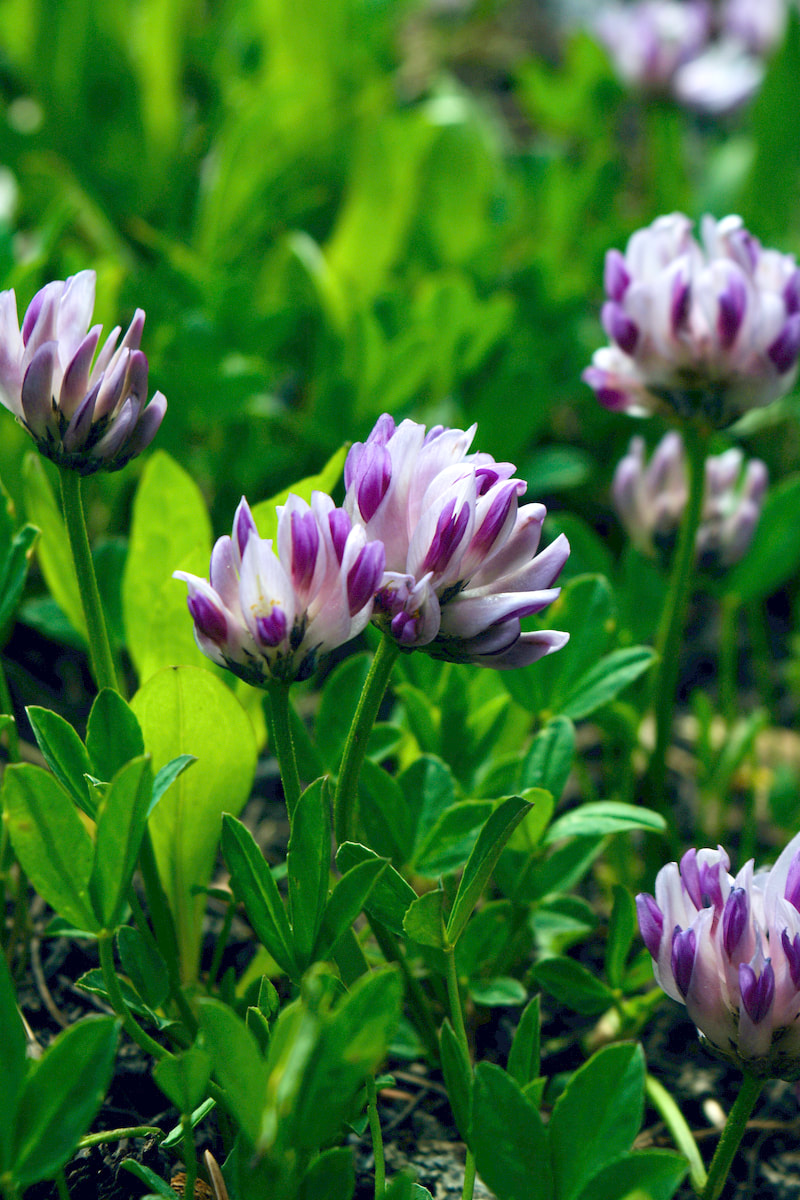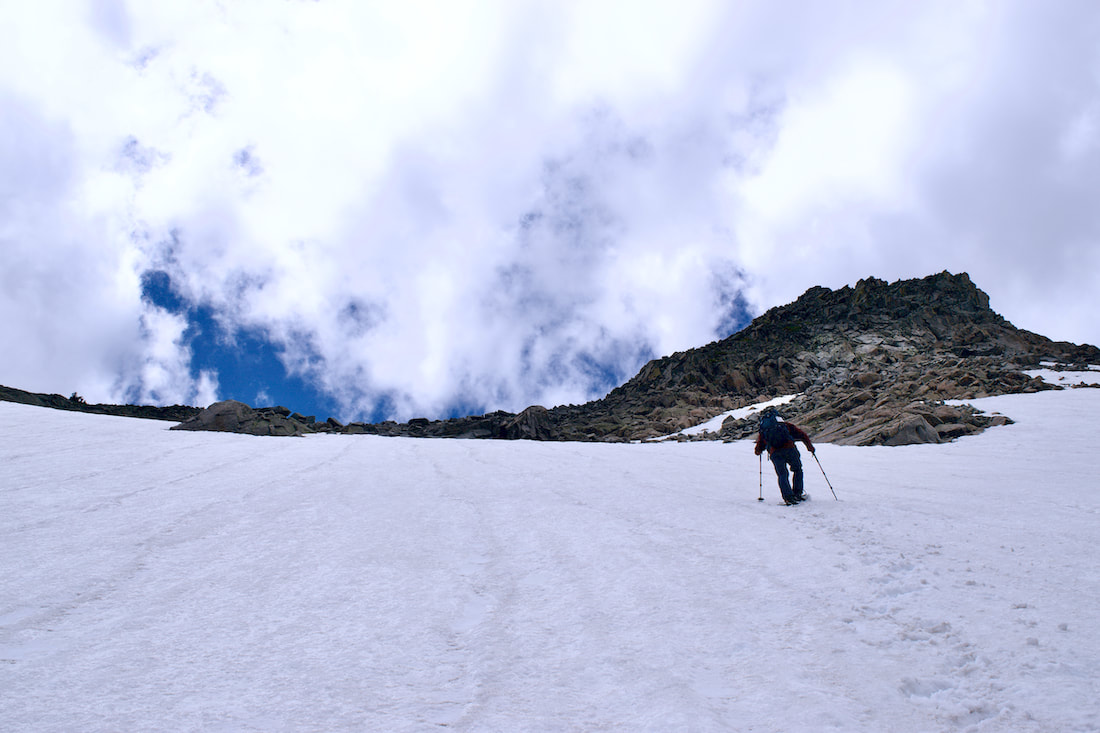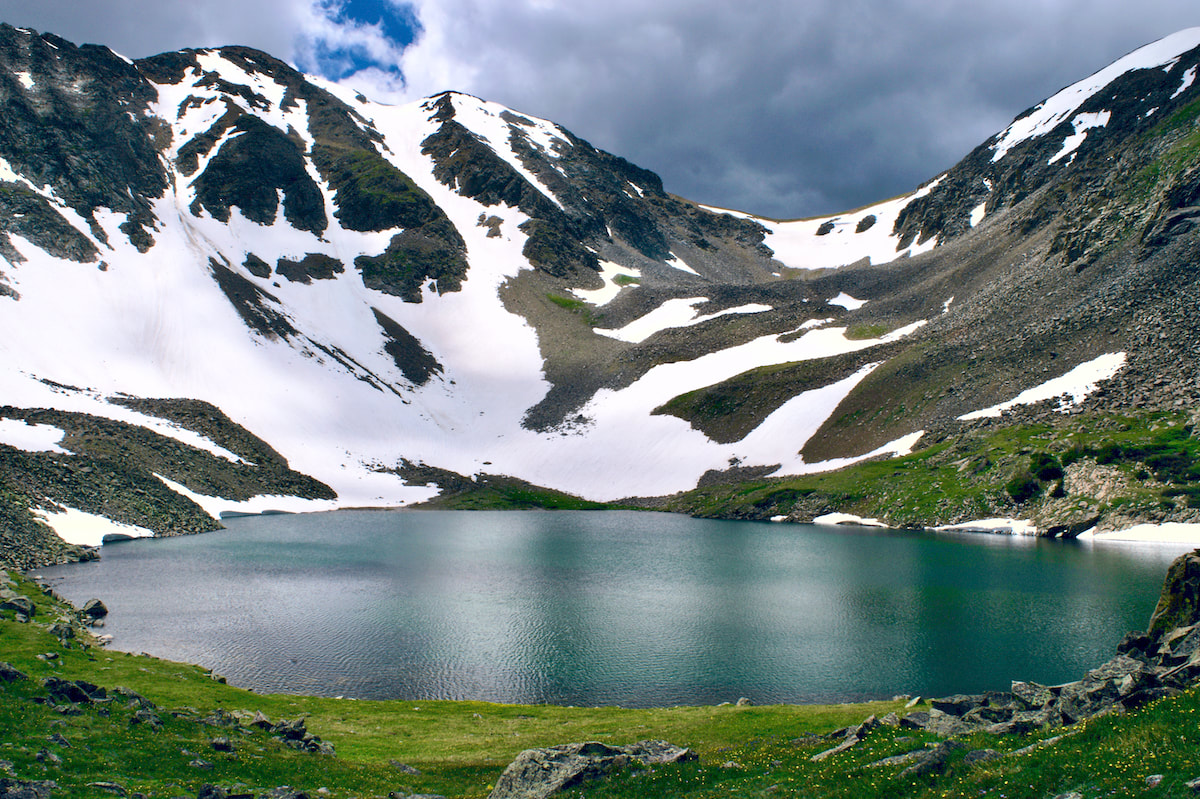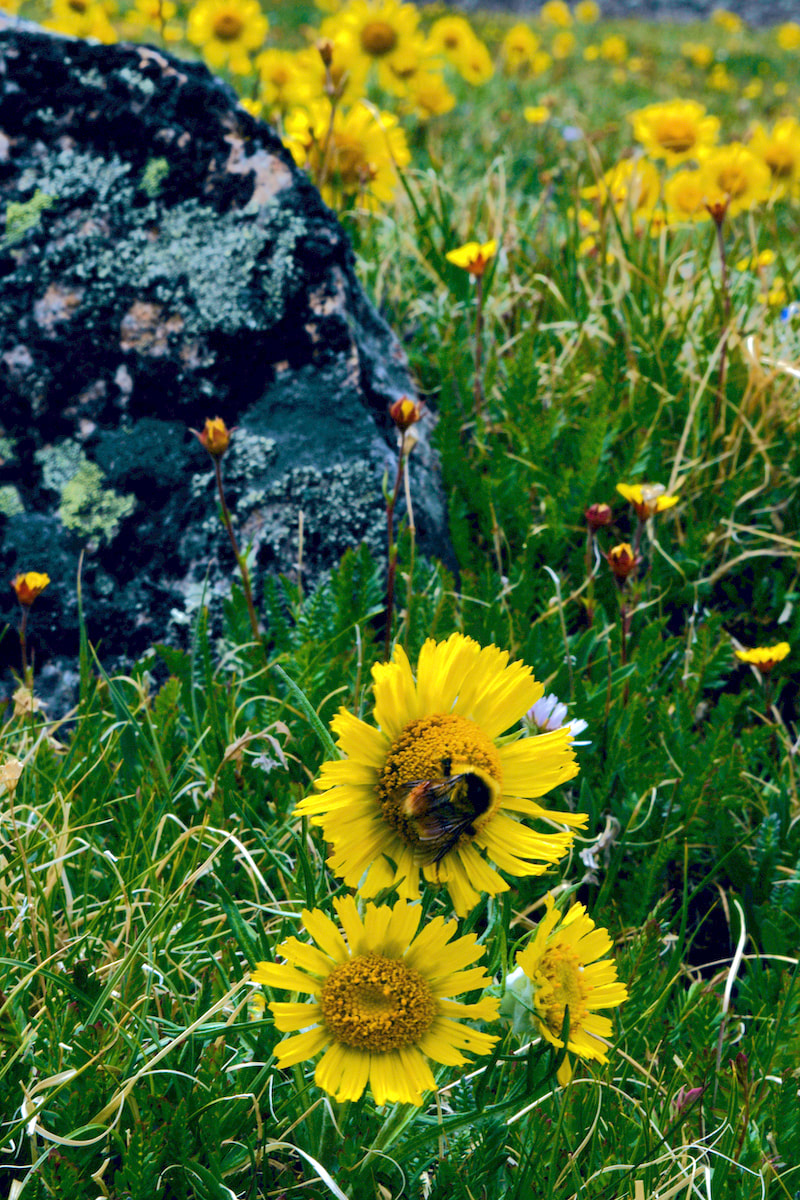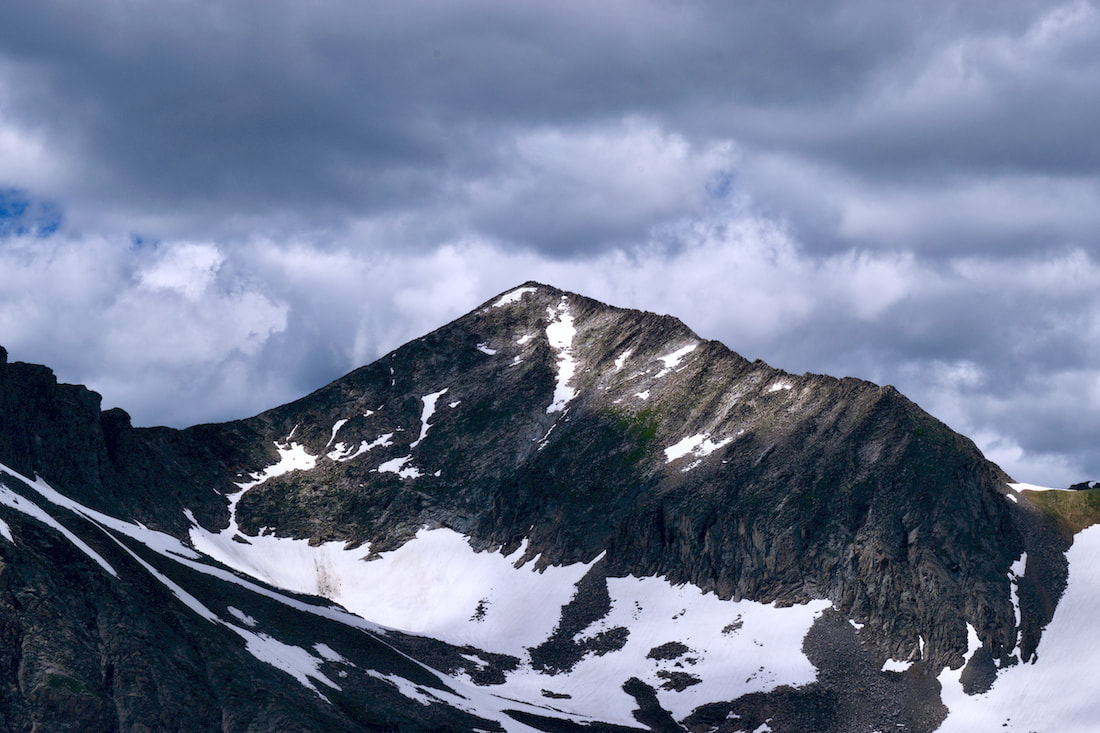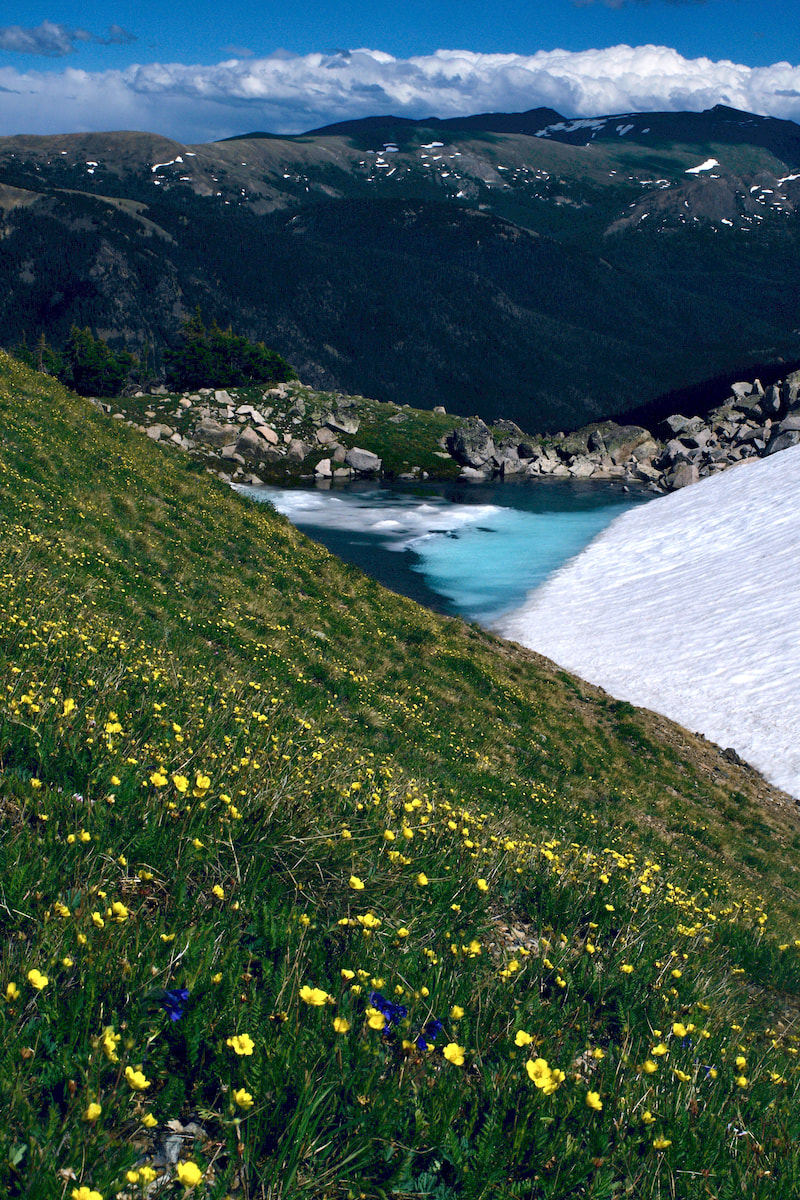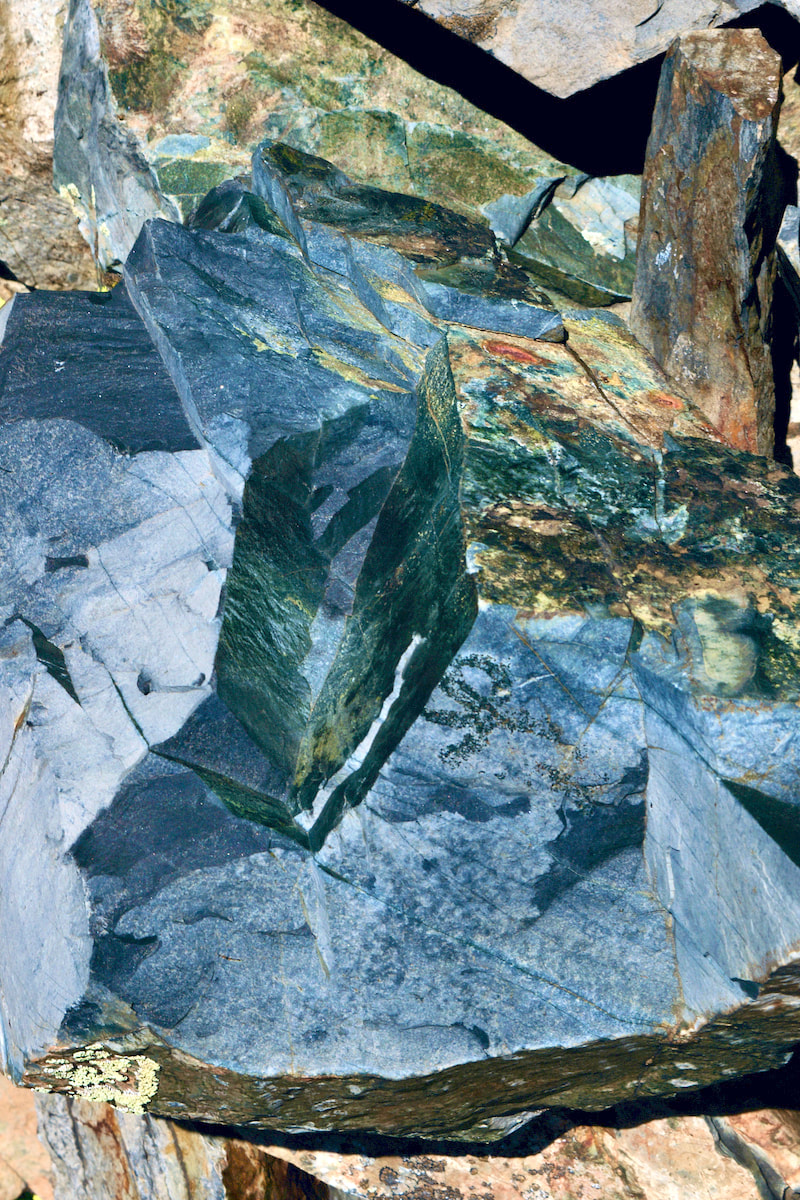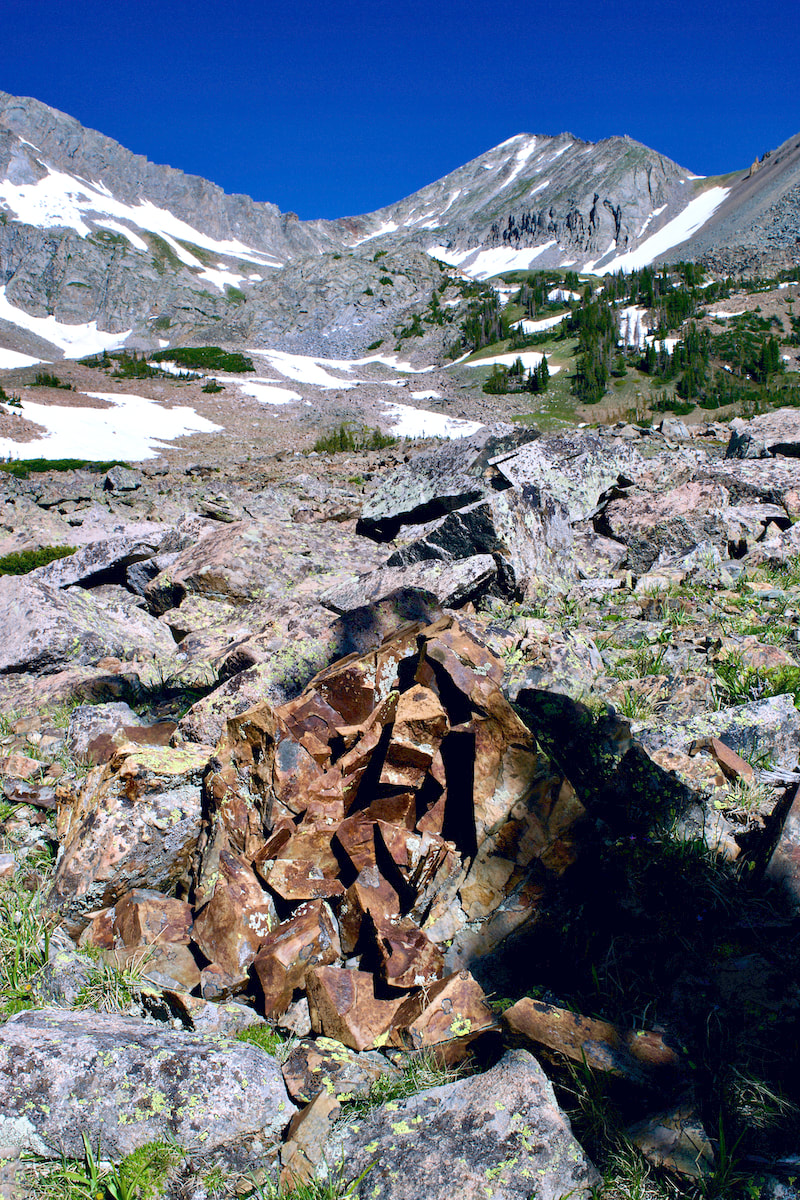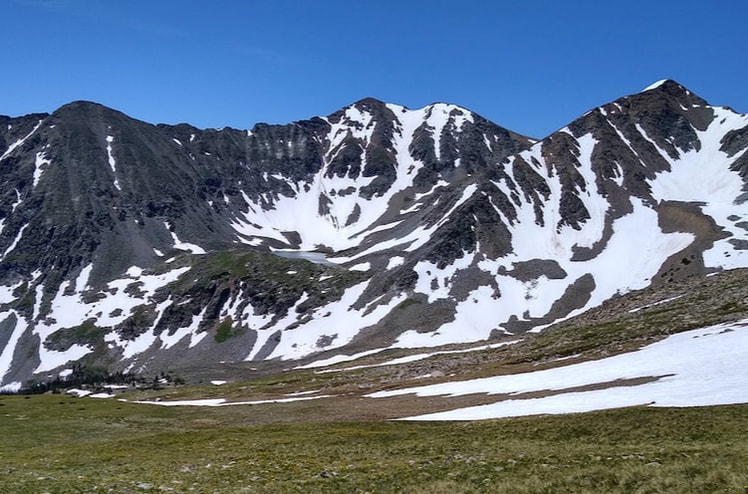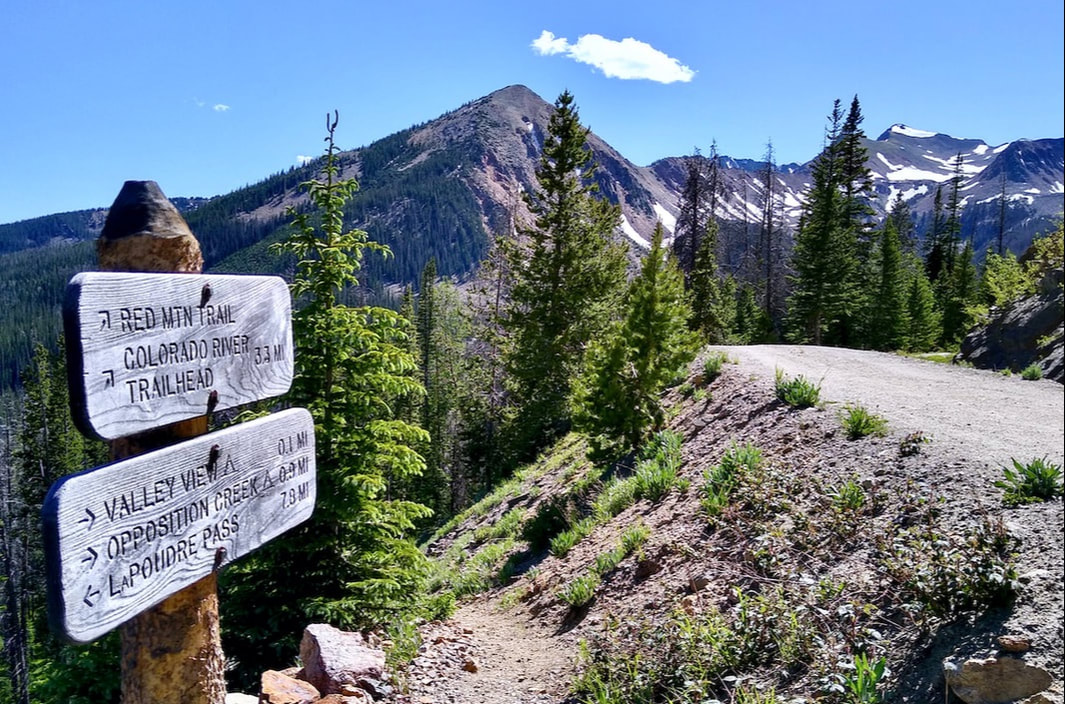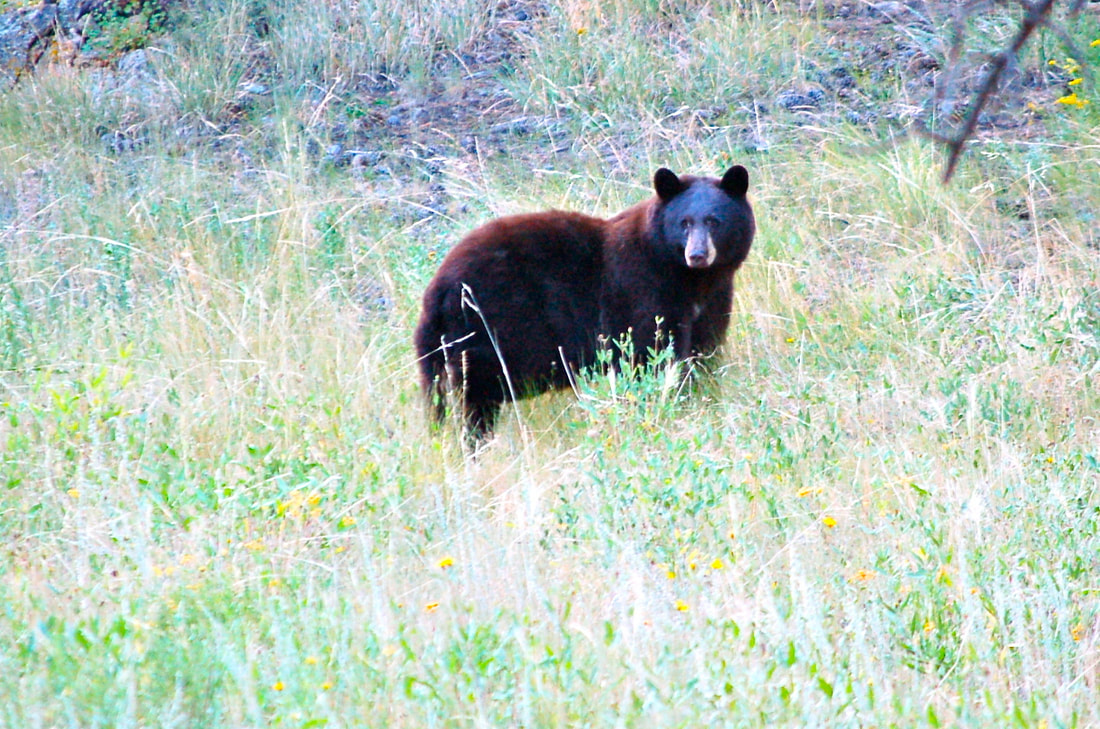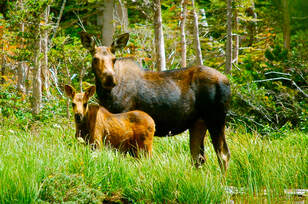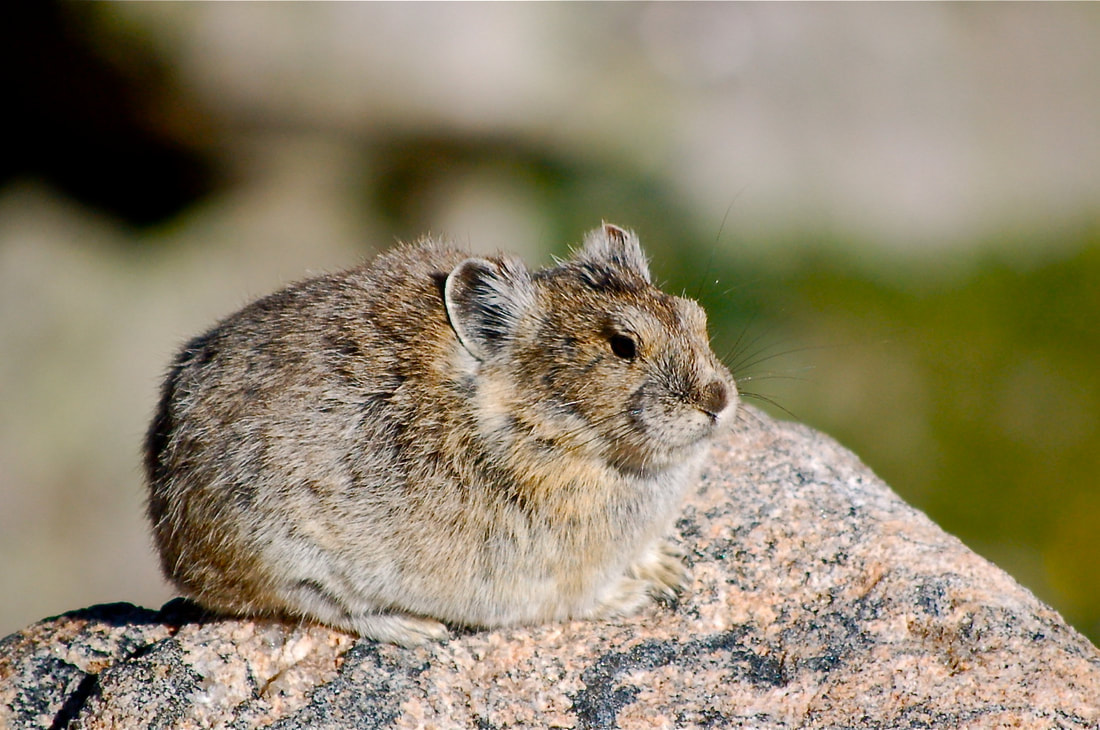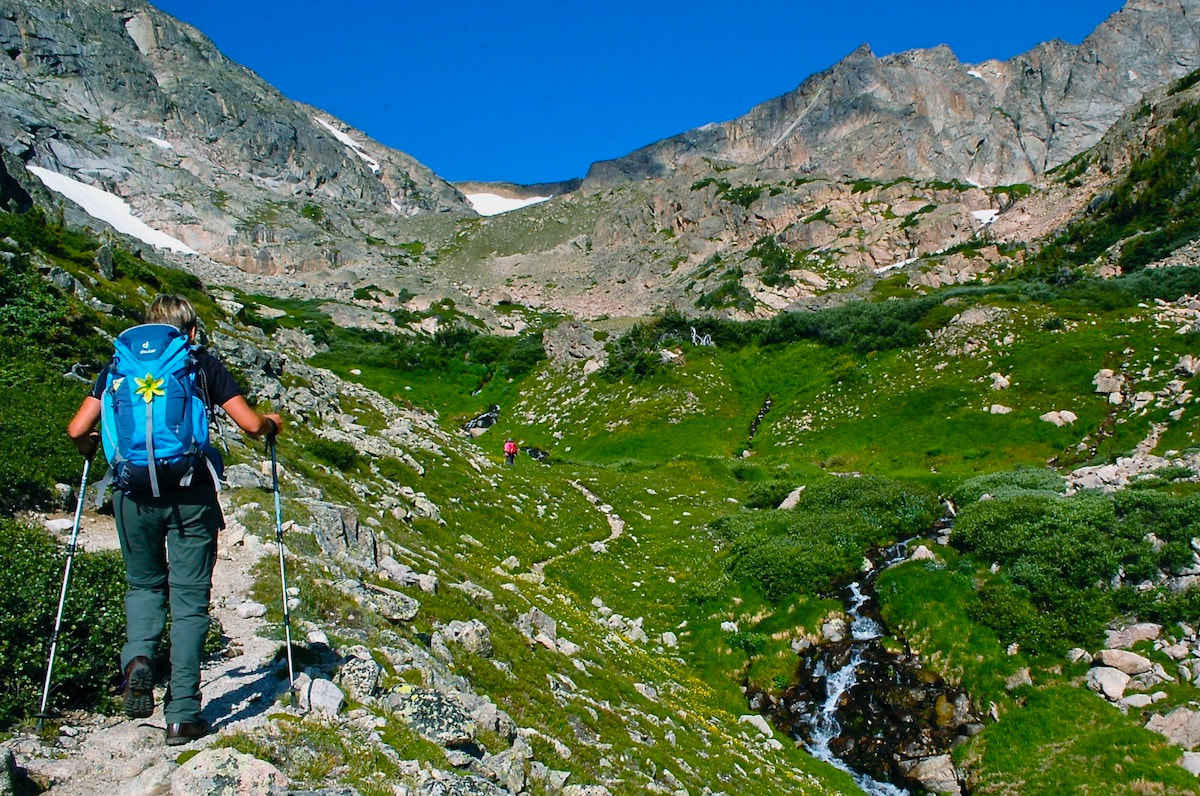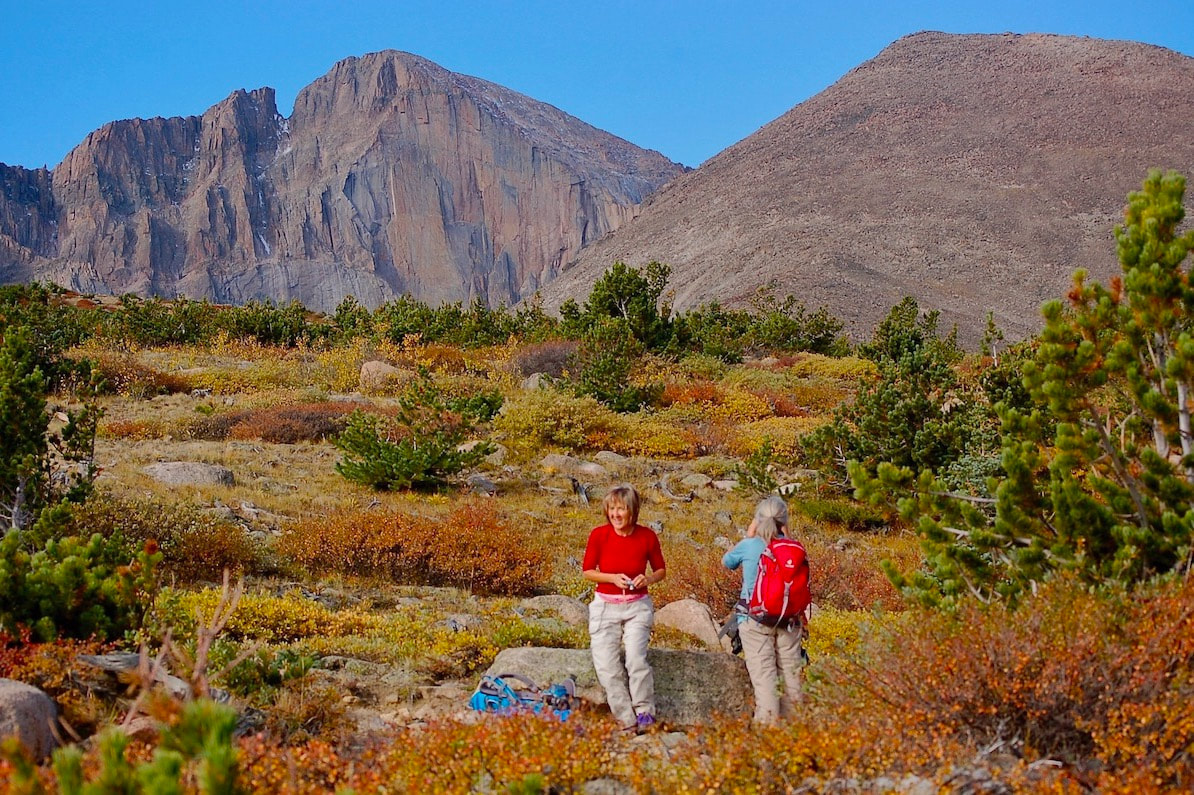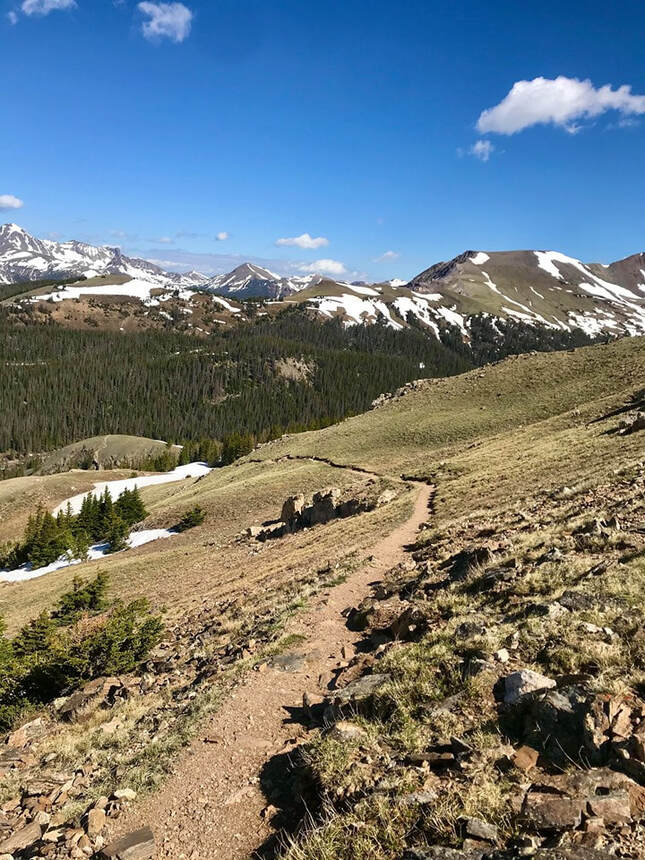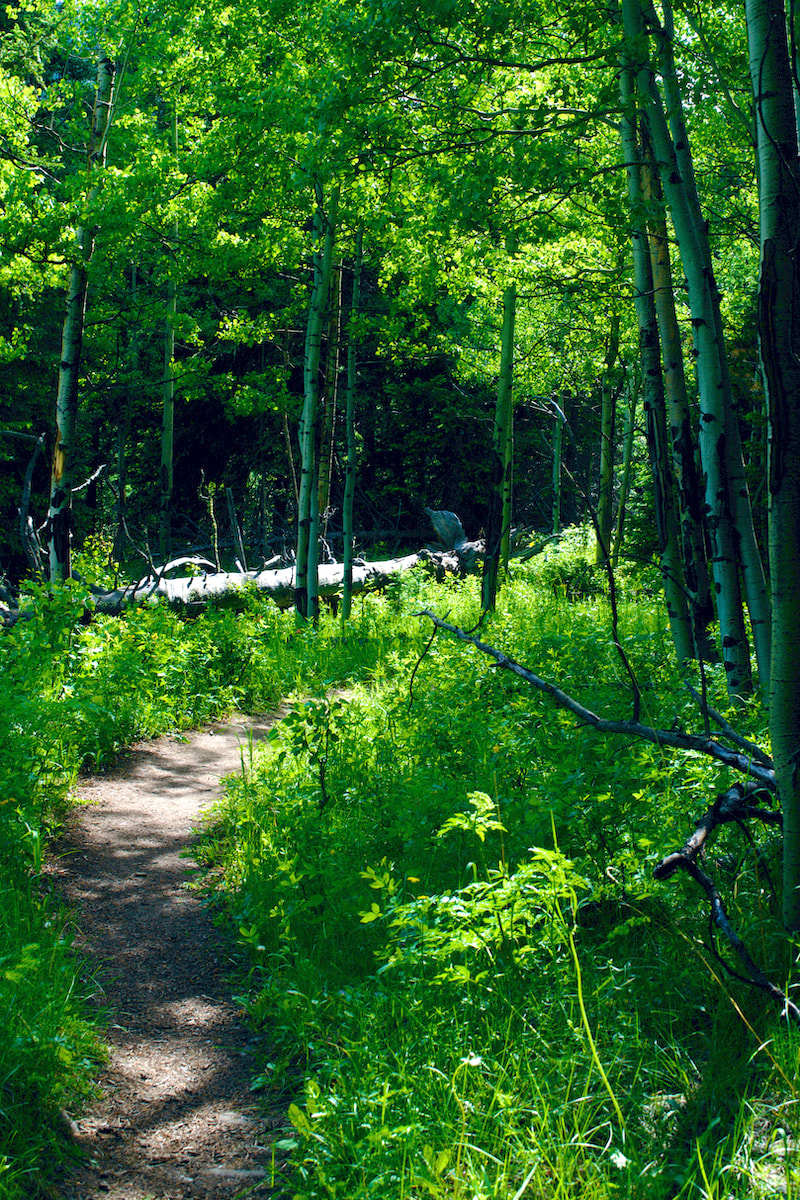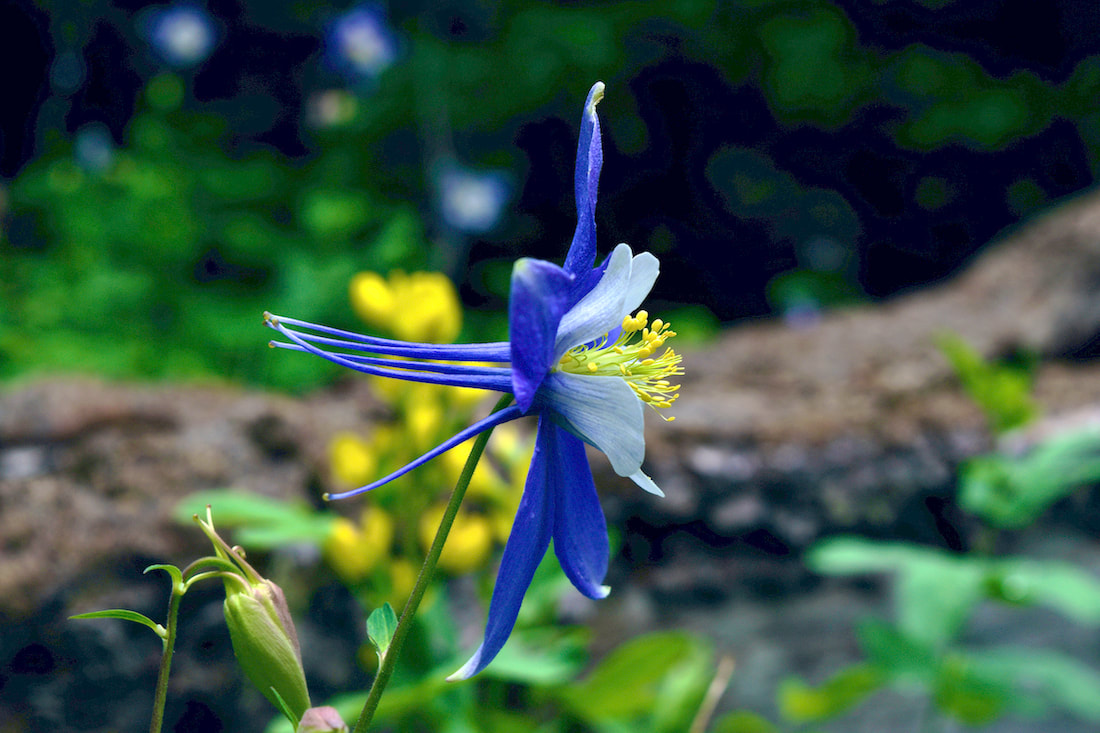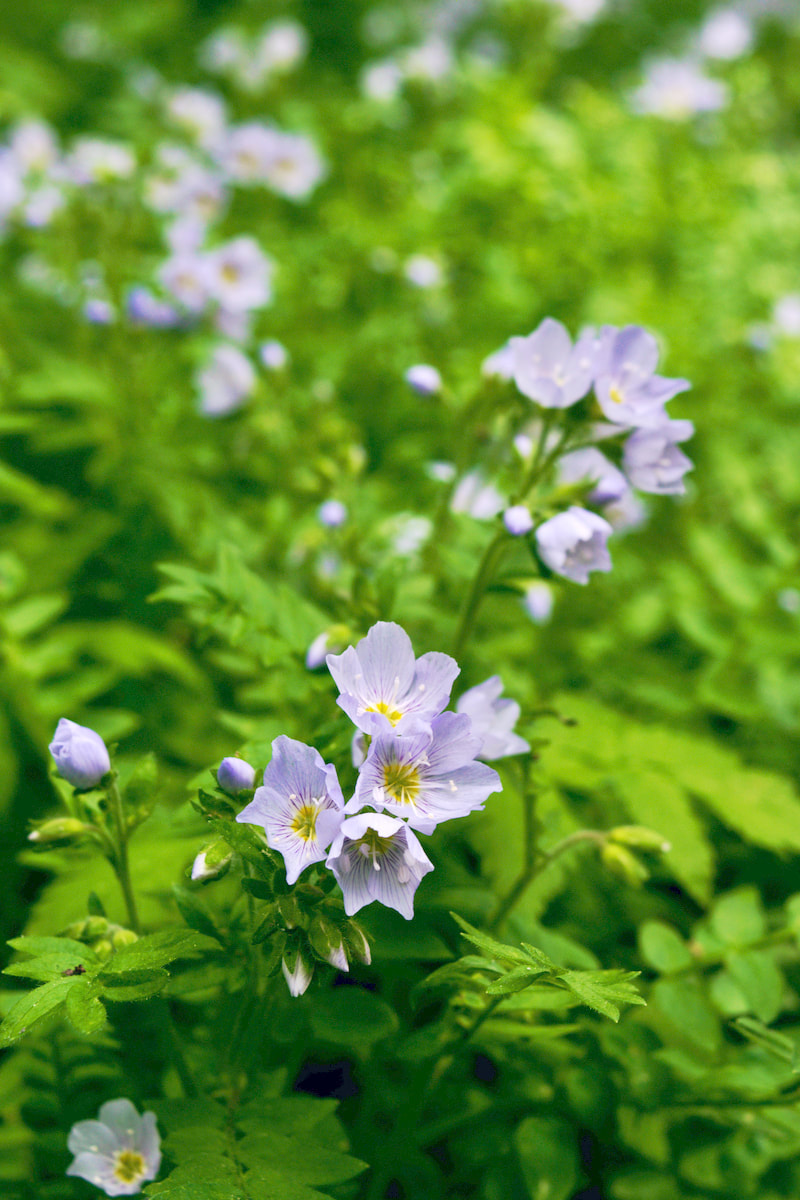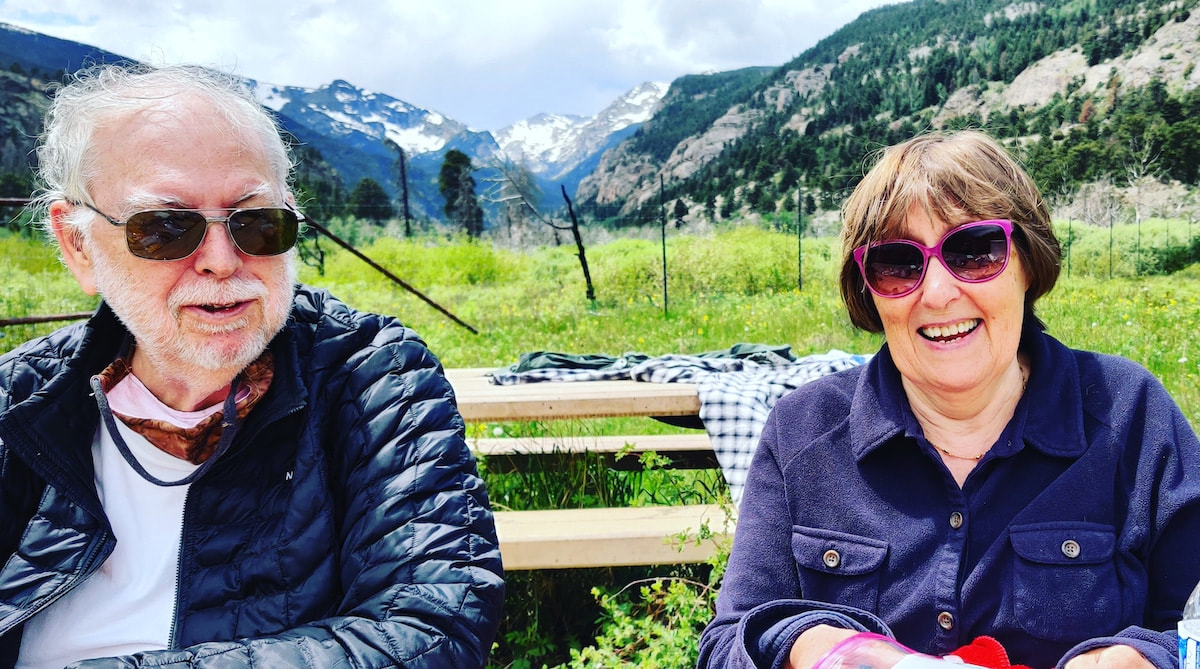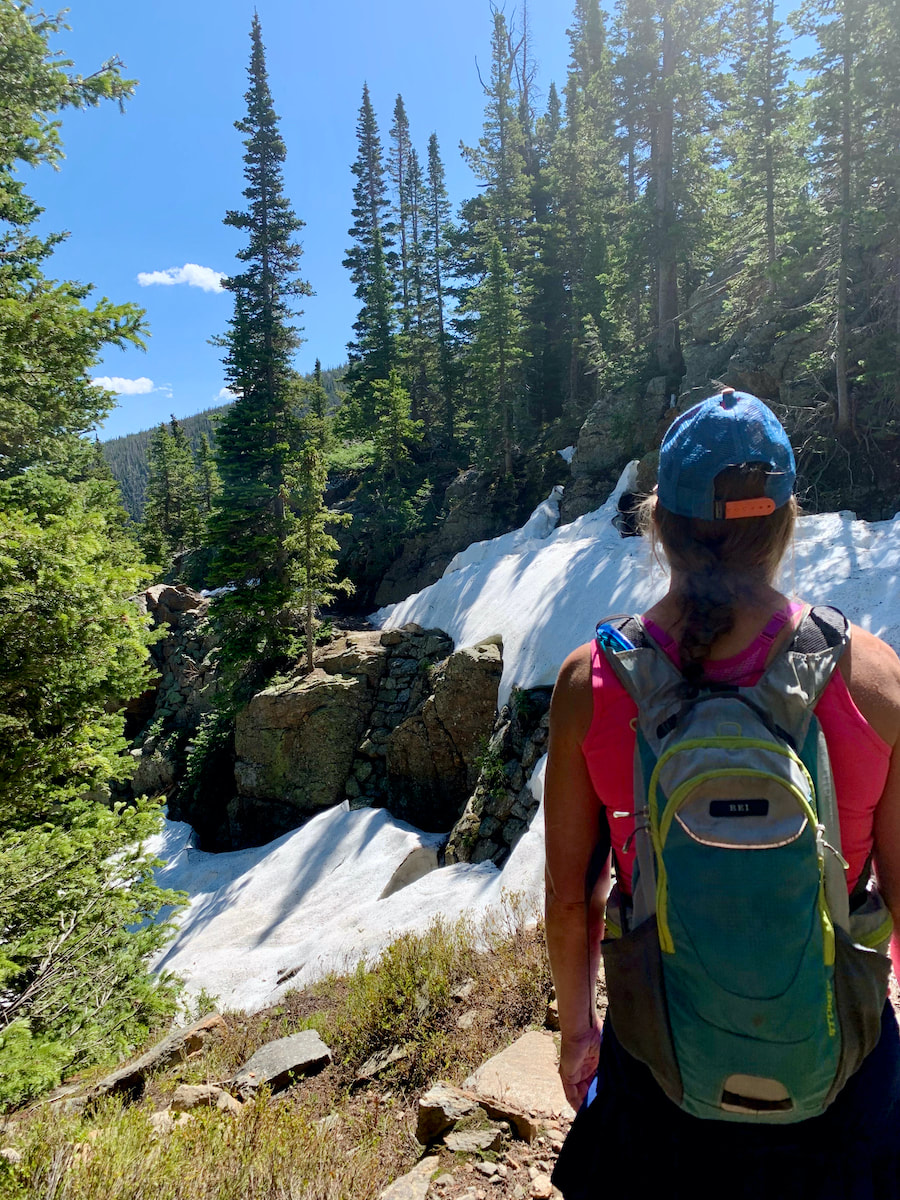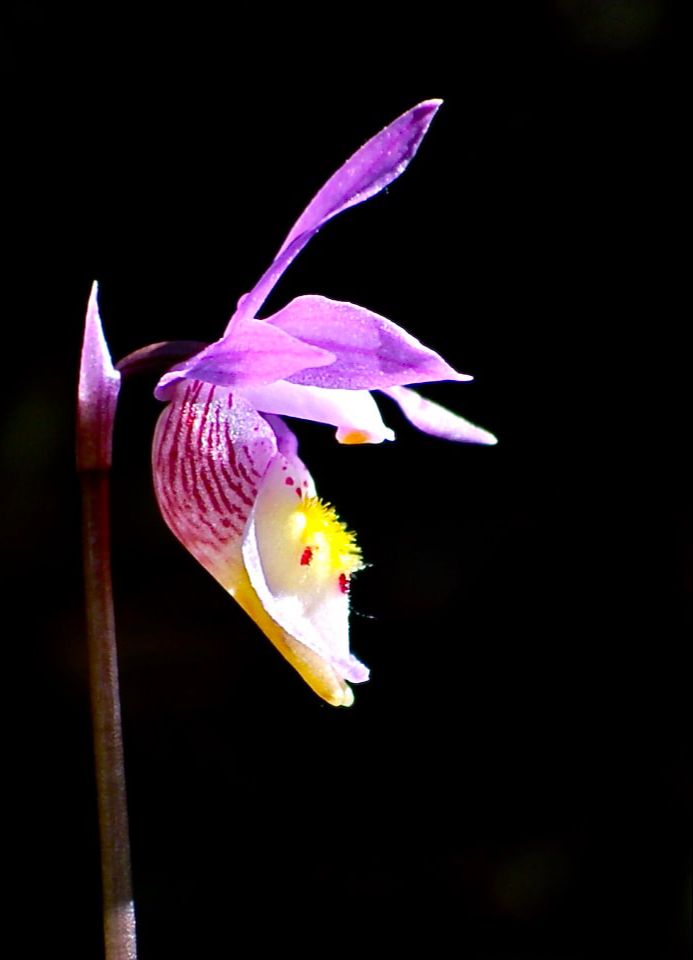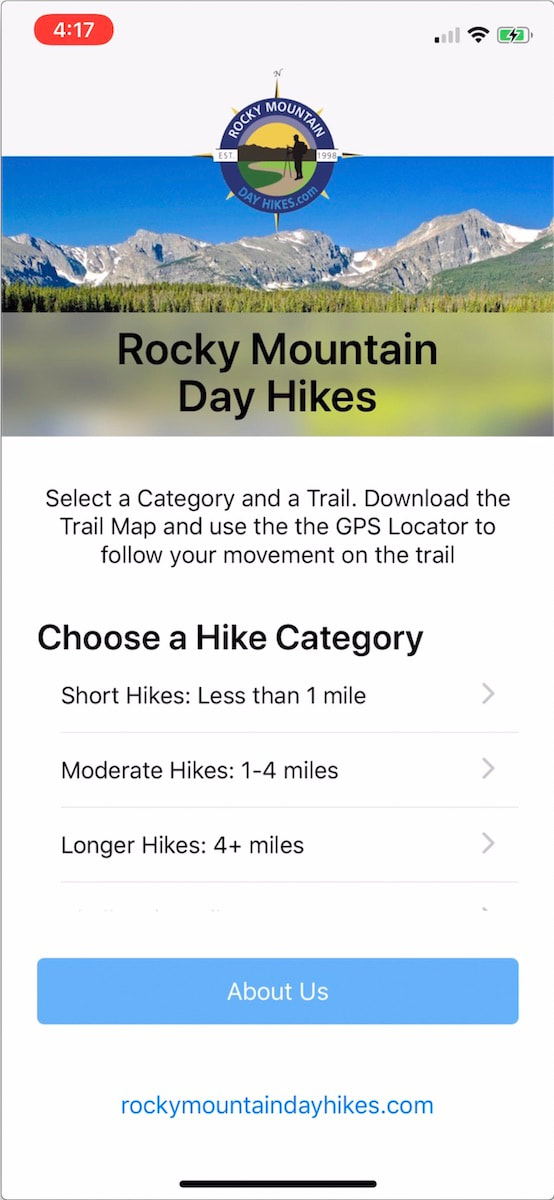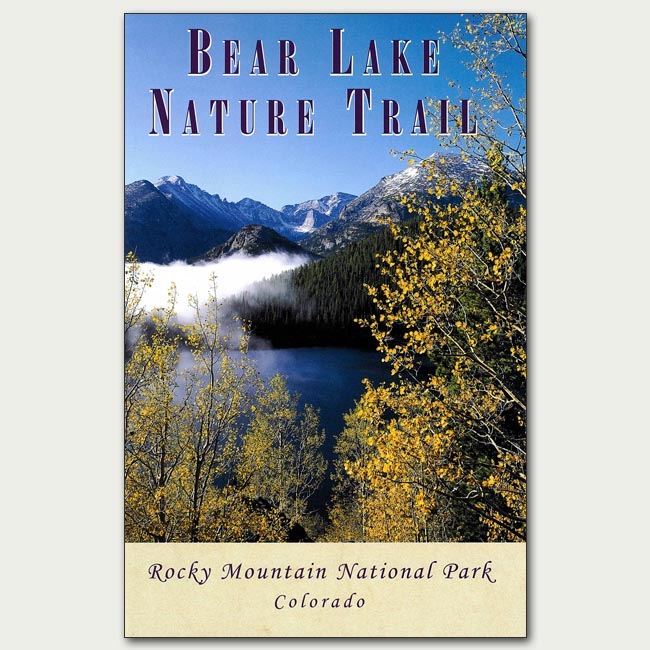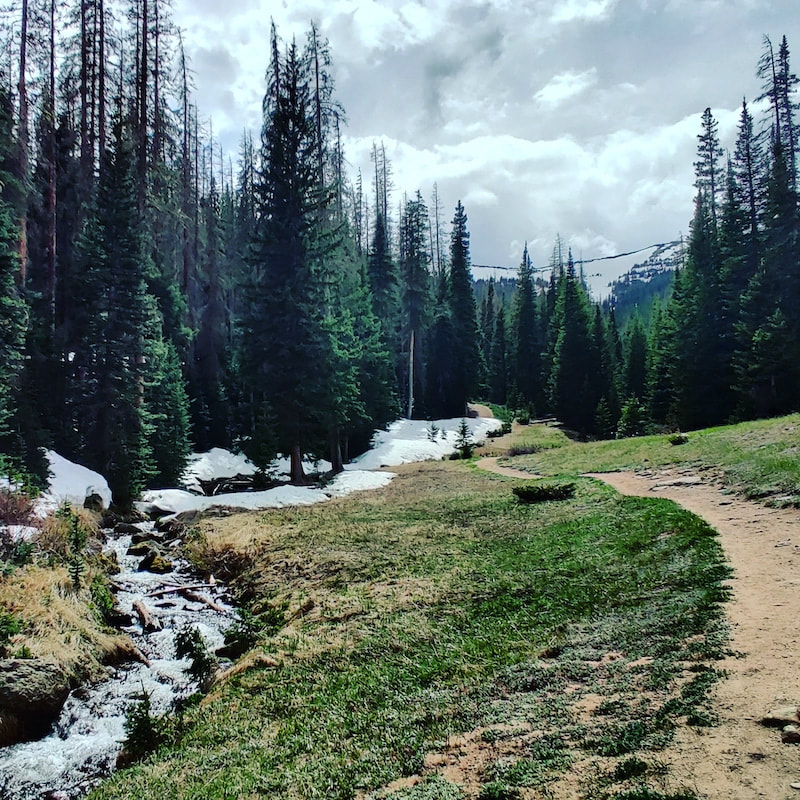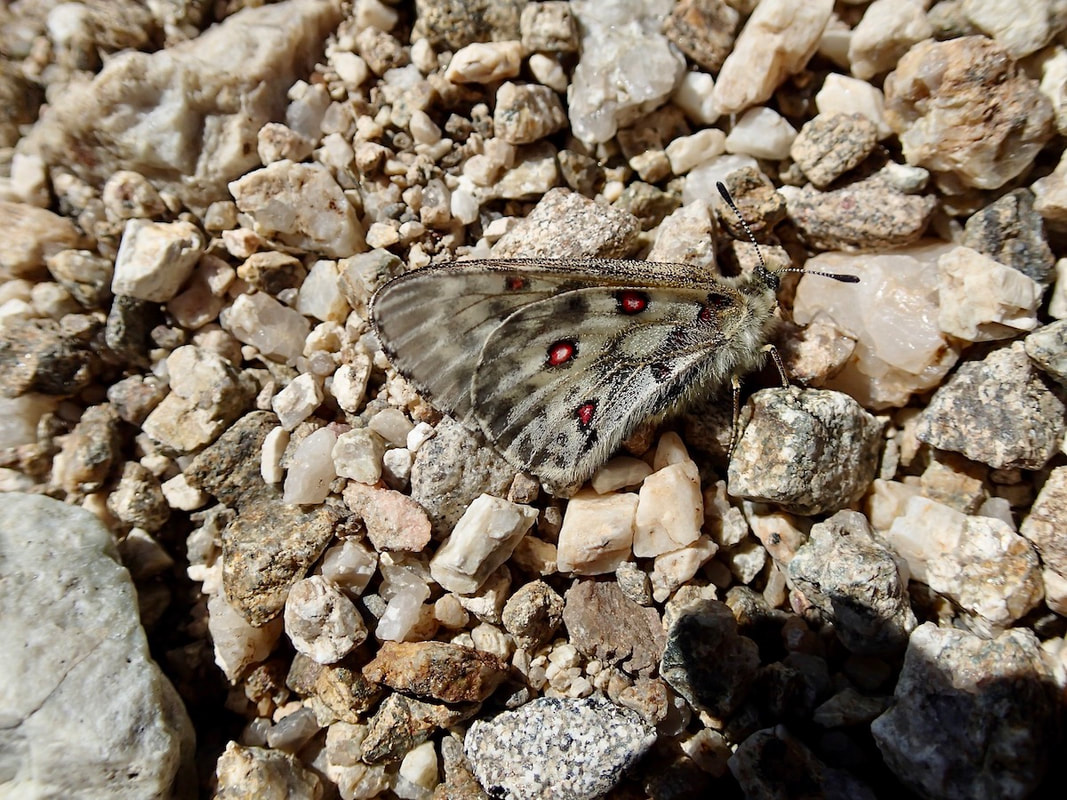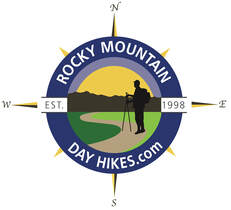|
Notes from the Trail
|
|
Trailhead: Wild Basin Trailhead Elevation: 8,500' Destination Elevation: 10,025' Elevation Gain: 1,525' Roundtrip Miles: 9.8 Recently, the Cameron Peak fire was blown into the northwest section of the Park. The devastation from that fire will be noticeable for many years to come. By taking a hike up to Ouzel Lake, we can imagine how things will look in that section of the Park in another 40 years. This last August marked the 42nd anniversary of the Ouzel Fire which started as a lightening strike in the southeast corner of the Park. Last week, on an afternoon when the fall colors were starting to come into their own, I ventured up the 4.9 miles to Ouzel Lake. It was a late day hike. I didn't leave the Wild Basin trailhead until almost 3:30 in the afternoon. I knew that by the time I walked the 4.9 miles to Ouzel Lake, it would be 6 or 6:30 and it would be dark by the time I returned to the lot, so I checked the batteries for my head lamp and threw that in the pack. The afternoon had clouded up and I encountered some rain on the drive south from Estes Park toward Wild Basin. But there was just occasional drizzle as I started my hike, not enough to get anything damp. Many of the aspen tree were still green, but those that had turned colors looked spectacular! As I hiked on, I wasn't too sure if the rain would pick back up, or would clear up. There wasn't a lot of water flowing down the Calypso Cascades when I crossed the bridges there and, knowing the water flow would be light, I went by the Ouzel Falls without much of a look there. My attention was mostly toward stopping to capture the fall colors as I quickly moved up the trail. I was glad to see the clouds breaking up once I hiked past Ouzel Falls. Sun was starting to get low on the western horizon when I reached the Bluebird Lake trail cutoff at just over 3 miles. The trail junction is in deep, dark forest being surrounded by tall spruce. But the trail quickly switchbacks up to the more open ridge that follows Ouzel Creek. This is where the hiker can best experience the 40 year natural restoration from the Ouzel Fire. I remember hiking this section of trail the summer after the fire in '79 and noticing how terrible things looked. It was a mostly barren landscape then. 40 years later, I could see the area was still a very long way from being fully recovered, but there was a healthy mix of aspen and spruce that were well on there way. Along this section of the trail, there were a few scattered dead trees that rose up over the new growth, ghostly remnants of the fire that sometimes gave the appearance of flames. One burned out log had fallen across the trail and I hoped the trail crews would leave it lay instead of cutting it up. I felt like it was an old soldier with the scars of battle showing. The fire opened the once forested ground to sunlight and part of the evolving ecological revegetation cycle allows for new plants and wildflowers to thrive. The late day sun made for good photography with long shadows and backlit leaves. But I knew I wouldn't have too much daylight left by the time I got to the lake. Fortunately, I was near the trail cutoff. There was just a little bit of daylight on the hillside as I approached the lake. Barely enough light to get some photographs if I hurried. I loved the orange tinged grass that highlighted the edge of the eastern shoreline The grassy shoreline was muddy and in places showed a little too much trampling from people walking around. I tried to step carefully so as to not contribute to the trampling. It took me two and a half hours to get to the lake, stopping for photographs along the way. I packed my camera into my day pack and left the lake at 6:30. It only took me an hour and a half to get back to the car. What a great hike!
0 Comments
Photos and story by Marlene M. Borneman “Autumn is a second spring when every leaf is a flower”---Albert Camus Every year I make the trek over the Continental Divide, 42 miles of which snakes through Rocky Mountain National park. There are several trails used to accomplish this mission but on Sunday of Labor Day weekend I chose to hike with three friends from Bear Lake to the Green Mountain Trailhead via the Tonahutu Trail, 15 miles one way. My husband was designated to pick us up at the destination trailhead. On a brisk, clear morning wearing headlamps, we started up Flattop Mountain Trail that connects with the Tonahutu. I started scouting for Blue Grouse, also called Dusky Grouse. These chicken-like birds live in subalpine areas this time of year. We were blessed with seeing several grouse foraging for seeds. The trail switchbacks in the subalpine forest gaining altitude above timberline to the alpine ecosystem. The trail becomes more rocky and steeper. The summit of Flattop, 12,324 feet, is always perfect for a second breakfast. Sweeping views of the Never Summer Range to the west were striking, but also melancholic as no winter snow was left, due to drought conditions.
Soon, we approached the intersection of the Tonahutu Trail and North Inlet Trail. We headed down the Tonahutu to the north and west over Ptarmigan Pass. Sightings of marmots, ptarmigans, and watching for elk and bighorn sheep absorbed us. Sweeping views appeared on a long switchback before dropping down. This section is wet and mossy as the beginnings of Tonahutu Creek; earlier in the season it is packed with wildflowers. I stopped to check on the vegetation and found a few star gentians still in bloom along with the tall and robust dense-flowered dock. Ah, the noise of Granite Falls can be heard before you see it. The water spilling over giant boulders with an invigorating spray makes for a picturesque spot for a break. There are many stream crossings on this portion of the trail and we stopped to soak our feet. I also wanted to photograph the seed heads of flowers which I find as attractive as the flowers in bloom. About two miles from our destination we came to Big Meadows from which the Tonahutu Creek snakes down all the way to Grand Lake and beyond. Tonahutu is an Arapaho word meaning “Big Meadow." There were no moose sightings that day, but they are often spotted here. The junction for Green Mountain Trail head came into view, we were only 1.9 miles to the awaiting car. But wait, what? Right then we got a text that the Park will be closing Trail Ridge Road at 3:00p.m due to heavy smoke from the Cameron Fire to the north. This was to be our route on the drive back to Estes Park! I checked the time - 2:45p.m. - and we hiked out a little unsettled thinking about the four-hour ride back, which usually takes 45-minutes when Trail Ridge Road is open (it has since reopened). We happily agreed to relish our day, including the long ride home. BE PREPARED you never know what will happen in the mountains. OPTIONS If you still feel ambitious after hiking over from Bear Lake instead of heading to the Green Mountain Trail Head, you can continue south along Big Meadows on the well maintained Tonahutu trail to Grand Lake. Here the Tonahutu Creek snakes down all the way to Grand Lake and beyond. This adds another 4.5 miles. This section is very showy in autumn with golden grasses, shrubs in red colors, lodgepole pine forests, gold aspens, and the chance of wildlife sightings. Encounter a little history by passing the Harbison Ditch as it no doubt helped irrigate the Harbison sisters homestead in 1895. Another option I have taken for a mellow day hike, not involving crossing the Continental Divide, is to hike this section as a 5.8-mile one-way hike with a car shuttle starting at Green Mountain Trail Head ending at either the Kaweeneche Visitor Center or Grand Lake. Or approximately 12 miles round trip. The entire way hiking is in rhythm with Tonahutu creek. The possibilities in Rocky are endless. NOTE: Last week I hiked Tonaahutu Creek./Big Meadows trail to Grand lake from Green Mountain Trailhead and back. Earlier in the week there was an “wind event” resulting in MANY down trees across the trail. The downfall increases the difficulty of hiking this section. Be sure to appreciate trail crews as they are working on clearing these trails. By Barb Boyer Buck Ever since I was a kid, hiking with my family in the mountains of Northern California and later in Colorado's high country, I remember the refrain: "Hey, Pop! Are we there yet?" My brother, sister, and I echoed this sentiment on all long hikes, even if we were enjoying ourselves. It became a habit. My dad would bend down, circle one arm around my shoulder and point to where the trail rounded a bend, traveling out of sight. "Just around that ridge," he would say. Most of the time, there was another ridge beyond that one… and another ... and another. When we were tired this was frustrating, but these days I understand why my dad did that. We had to keep going forward to reach our goal and he was trying to keep our spirits up.
Add to that the spotty and/or non-existent phone coverage in RMNP and the danger increases. Rocky Mountain Day Hikes has developed a free app for smart phones (either Apple or Android) called GPSmyhike to help with these concerns.
The downloaded topographic trail map indicates the trail with a red line and a moving blue dot (which we've named ED) tells you exactly where you are at any point along your hike. RMDH founder and app developer Dave Rusk had an opportunity to test the app's efficacy in early June, while hiking the Flattop Mountain Trail. Portions of the trail were covered in snow and it quickly became unclear where it went. "Even if there are tracks in the snow, it doesn't mean that it's the actual trail," Dave said. GPSmyhike helped him to find the trail which he & his hiking partner had wandered away from. Read his report of that hike here. Once you've downloaded the map, ED will appear anywhere you are! Even if you are off the trail, even if you have downloaded a map for a different hike altogether. Zoom out on any trail map you've downloaded and ED will tell you exactly where you are! ED always answers the question "are we there yet?" Have you tried out the app? We would love to hear about your experiences and perhaps see some app screenshots paired with actual photos of the location ED indicated you were. Submit these photos to [email protected] and we may use them in a future piece! Trailhead: Bear Lake Trailhead Elevation: 9,475' Destination Elevation: 13,208' Elevation Gain: 3,733' Roundtrip Miles: 16 This hike was done several weeks ago, on September 2. Before the area received several days of hot, dry winds that blew up the Cameron Peak fire and eventually closed Trail Ridge Road due to heavy smoke conditions. And before the dramatic change in the weather that dropped temperatures by nearly 50 degrees overnight and kept Trail Ridge Road closed for many more days with as much as 16" of snow. Conditions can change very quickly in the mountains. I left the Bear Lake parking in the dark with other hikers wearing headlamps to see their way on the trail. My destination on this day was Powell Peak via the Flattop Mtn trail and across the tundra, rounding the backside of the many peaks that make up The Front Range. Because of the extended amount of time cruising above treeline, it was important that there was a zero percent chance of thunderstorms in the forcast. I started up the Flattop Mtn trail like a race horse out of the starting gate, but then settled into a steady pace as I rose in elevation with the sun.
I worked my way around the western flank of Hallett Peak until I could see Longs Peak and Taylor Peak, two prominent landmarks. I needed to go around Taylor Peak to get to Powell Peak, so I headed for a low spot to the right of Taylor and kept that spot in my sights while I navigated the terrain. After passing Otis Peak, a visible trail appeared that led to the top of Andrews Glacier. I took a peek down to The Loch Vale before continuing on my tundra traverse.
Once I reached the high point on the shoulder of Taylor Peak, I found I was still not far enough around to see my direction to Powell Peak yet. But I was able to see across the valley to the southwest at the dramatic range, with Andrews Peak to the the left and Ptarmigan Mtn to the right, and I could also see the two lakes, Nakoni and Nanita, that sit below them. The actual summit of Powell Peak is hard to make out. It is not as prominent as many of the other surrounding peaks are, especially from the back side. And because of the rising elevations, some things are hidden. I kept an eye on a really prominent peak which at first I thought was neighboring McHenrys Peak. But later I realized that Powell Peak was hiding McHenrys Peak and what I was looking at all along was Chiefs Head Peak. It wasn't until I was on the actual summit of Powell Peak that I realized my error. Right in front of me, sticking up like a sore thumb, was the backside of McHenrys Peak between Longs Peak and Chiefs Head Peak behind it. The topography can be confusing, and very dramatic when trekking across the tundra. At 13,208 ft, Powell Peak is slightly lower than McHenrys Peak by only 19ft, but higher than the more prominent Taylor Peak by 55ft. But the distance to get to Powell Peak is considerable, and I began to make my way back. It took me six hours to reach the summit of Powell Peak from the Bear Lake Parking lot, but only four and a half hours on the return. Trailhead: Rock Cut Parking Area Trailhead Elevation: 12,090' Destination Elevation: 12,304' Elevation Gain: 214' Total Roundtrip Miles: 1 mile This summer, I have enjoyed some spectacular hiking into the backcountry areas of Park. Last week, I changed things up a bit and visited a variety of shorter hikes. I began my day by taking a walk on the tundra. I entered the Park at sunrise, the first rays of the sun lighting up the clouds that were forming. By the time I reached Many Parks Curve, the sunrise was putting on quite a show. Note: click on each photo for a larger image. The Tundra Communities trail begins at the Rock Cut pullout on Trail Ridge Road, at an elevation of 12,090', according to a sign posted on one of the restrooms at the parking lot. The 1/2 mile trail is paved and there are not any steps on the trail. The first part of the trail ramps up a ways before leveling off. Of course, there are mountain peak views in every direction. On this day in late August, the sky was fairly overcast. But the sun found a break in the clouds and shone down on the Never Summer Range to the west. Looking to the northwest, the smoke from the Cameron Peak fire was laying low and filling the valleys below. Along the trail, there are interesting rock formations of dark colored schist that originated at the bottom of a sea. The lighter colored granite pushed in as magma. The granite erodes more quickly than the schist and forms forming mushroom shaped rocks. The trail offers the hiker plenty of informative interpretive signs where one can stop and rest while taking in the view. The best time to see the tundra in full bloom is mid summer. But the tundra is rich in autumn colors right now and it's not as crowded with other hikers. The trail dead ends at a high point of rock formations. If you scramble up the rocks, you will find a memorial plaque Roger Toll, the first superintendent for this Park. You can read more on the Park history here and on Trail Ridge Road here. Story and photos (except the last one) by Barb Boyer Buck Before I go into details of the Cow Creek Trailhead hiking opportunities, there are several things to keep in mind. First, parking is extremely limited and fills up quickly. Roadside parking, or parking in a homeowner's driveway is strictly forbidden. Respectful usage of this trailhead is a must as there are sensitive ecosystems, private land, active researchers, and lots of wildlife also inhabiting the Cow Creek Valley. The McGraw Ranch Road, which is your only access to this trailhead, is a dirt road with mild washboards and can be easily accessed from Devil's Gulch Road, on the north side of Estes Park. If you want to hike this trail, my advice would be to go very early in the morning, or late afternoon. Please remember in the summer months, afternoons often bring thunderstorms and several portions of this hike crosses wide-open meadows. It is not advisable to hike during a thunderstorm, lightening strikes are a very real possibility. If you find yourself wanting to hike this trail at any other time of the day, the best thing to do is have someone drop you off at the trailhead; however, cell phone reception is pretty much non-existent in the area. If you decide on this option, have a plan to meet at a specific time with the understanding that idling cars waiting to pick up delayed hikers are also not permitted. Instruct your driver to check back occasionally if you are not there when you expected to be.
The site of the old McGraw Ranch still has buildings, including one that has been standing since 1871, the original homestead cabin of Harry Farrar. Others were built between 1884-1887, and most of the guest cabins were built between 1935-1936 by Frank and John McGraw (for more history of the ranch's early days, see part one of The Cow Creek Trail, published last week).
Researchers from Northern Colorado, Colorado State University, and the University of Colorado, along with the United States Geological Survey, now use the surrounding land as an outdoor laboratory. Onsite housing, laboratories, meeting rooms, and dining areas for these individuals are provided by the ranch buildings. The renovation of the buildings started in 1999, the culmination of a partnership between the NTHP and several private citizens to restore the McGraw Ranch buildings to their heyday as a guest ranch, between 1936-1955. The research center opened in 2003, becoming an important site to gather significant data in RMNP; Rocky Mountain National Park is designated as a United Nations Educational, Scientific, and Cultural (UNESCO) international biosphere reserve. From butterflies (there are 142 species confirmed in RMNP) to climate change, these studies provide important, scientifically-gathered information for the entire world. I started my hike at dawn, just before 6 a.m., at the research center. Very soon, the trail has an intersection on the right with the North Boundary Trail which branches up and east. The beginning of the way to Bridal Veil Falls was lit with the sun at my back, glorious coloring the late-summer vegetation and a whitetail deer, grazing along the edge of the trail.
The first part of the hike is a beautiful meadow that climbs a bit before it wanders back to Cow Creek. For most of the hike, you can hear its rushing or trickling waters, something I enjoy very much. It's so relaxing. I needed a bit of calming down because I was anxious about taking this hike by myself, the first one with a distance of more 2 miles I've taken on my own since my back surgery. And there was no one else on the trail that early in the morning. Every rustle in the trees had me looking - this is bear country after all! It's also a hunting ground for mountain lions, although it's very rare to see these creatures anywhere near humans. A bit further down the road comes another trail crossing, this time giving you the option to turn left to hook up with the Lumpy Ridge Trail to visit Balanced Rock and Gem Lake.
Just beyond this spot, there are some steep rocks before the trail picks up again. I didn't dare do this on my own so I guess neither horses nor I would get any further. It was frustrating because ED. (more about ED. next week) told me I was essentially there, but I couldn't chance it. Just a few weeks ago, a woman took a tumbling fall, sustaining serious injuries, above Bridal Veil falls (see more info here: https://www.rockymountaindayhikes.com/rmnp-updates.html) So, I ate some fruit, drank some water and started back. I saw several more people on the trail and I was grateful to be coming back. The sun was higher now, and it was starting to get hot. When I passed through the meadows again, the butterflies were flitting all around me, enjoying the late-August sunshine. It took me about five hours to do six miles roundtrip but remember, I stopped to take many pictures along the way. It was worth it and I needed it. It was the first morning without any smoke haze after two days of good rain. The air was clear, the sky was blue and the morning light was perfect. Happy hiking, everyone! Trailhead: Finch Lake Trailhead Elevation: 8,476' Destination Elevation: Finch Lk-9,925', Pear Lk-10,594', Cony Lk-11,512' Total Roundtrip Miles: Finch Lk-10, Pear Lk-12.4, Cony Lk-18.4 In the south end of Rocky Mountain National Park, as part of the Wild Basin trail system, there are a series of lakes that begin at the Finch Lake trailhead and can give the dayhiker some options on a trail that is not too crowded, but the destinations are all longer hikes.
The trail actually loses some elevation on the last strech to Finch Lake. There are a couple of good rock spots along the eastern shoreline to enjoy this peaceful lake. Finch Lake is a comfortable distance for many dayhikers, and well worth the effort. But for another 2.5 miles, you can also bag Pear Lake. The trail skirts around the north side of Finch Lake, then drops a bit more to a footbridge crossing Cony Creek. There's not too much elevation gain between the two lakes and the trail is pleasant.
This trial is not an official trail of the Park. It is not maintained and there will be some downfall to climb over, for example. If the dayhiker is going to travel here, you will want to plan on a much longer day. After passing the lower of the three Hutcheson Lakes, the trail can be difficult to keep track of, so it's necessary to have an awareness of your surroundings. Having a topographical map and knowing how to read it is also a good idea. This is a pristine alpine environment, so travel carefully. Follow the small trail to reach the Middle Hutcheson Lake. The three Hutcheson Lakes each sit on a self with the lower lake still below treeline, the middle lake in the subalpine and the upper lake right at treeline. Carefully navigate over rock outcrops that look over Middle Hutcheson Lake to reach into the upper basin and Upper Hutcheson Lake. The upper Cony Basin begins to come into full view as the dayhiker approaches Upper Hutcheson Lake. Cony Pass that leads over to the Bluebird Lake basin to the north, can be seen in the distance. Ogalalla Peak can also be seen now. On our day, we decided to travel up to the base of Coney Pass. The pass is steep with lots of loose scree. We reach our high point standing below Ogalalla Peak. The summit, 13,138', is part of the Continental Divide and is a high point marking the south boarder line of the National Park. We then turn our attention east looking at where we have come, and now our return route. We can see Cony Lake below us. Nearby is the prominent Elk Tooth with Meadow Mountain in the far distance. Both of these peaks define the southeast boundary of Rocky Mountain National Park. by Barb Boyer Buck Imagine it's 150 years ago (I do this all the time). Imagine you have made the long trek via horseback to the beautiful mountain valley of Estes Park. At that time, Colorado was a territory of the US and the land was declared "public" by the Homestead Act. Every piece of the valley that is not already developed is open for homesteading. All you have to do is pick out your 160-acre parcel, "improve" the property, and pay a small registration fee. Put yourself in that scene. What is your personal perspective? Are you a child, part of a family looking for a new home? Are you sick of the towns where you live and want some peace and quiet in the Colorado mountains? Do you fancy yourself a wilderness man or woman, fiercely independent and resourceful? You're itching to live off the land and figure things out for yourself. Whatever your perspective, I'm sure you'll agree. The homesteading narrative is romantic and adventurous. Let's say you’re a big game hunting guide and you marvel at the wide-open fields below you as you crest that final hill over Estes Park. It's the late summer of 1871, and the basin looks mostly dry, with only the snake of the Big Thompson River slicing through it (there was no lake back then). You notice the prime spots along the river were already claimed. Now, suppose you ride north in the valley, where the mountains meet the meadows and the elk are plentiful. Finally, you see it. The Cow Creek Valley. The creeks in this valley have been slicing a sliver out of the surrounding Rocky Mountains for millions of years. Upon investigation, you find the valley is more than wide enough to establish a viable homestead and the entire drainage is covered in lush foliage. Imagine you stop to take a drink from the stream. (Don't do that today unless you treat the water!) These are not the exact circumstances that led Henry Farrar to eventually homestead the area in 1871, but it's probably close. These are the kind of things I like to think of when I talk about hikes in historic sites within Rocky Mountain National Park but when I was a kid, I hated history. I struggled in class to remember dates, names, events. I only fell in love with history while I earned a BA in Anthropology. Suddenly, I found context in past events. I studied possible motivations for historical figures. I found similarities between myself and everyone who came before me. I can imagine myself into the mindset of someone in Estes Park, 150 years ago. In the case of the Cow Creek Valley, I can imagine the stirring excitement of the situation, being given just enough help through the Homestead Act to get myself started in something entirely my own. In reality, Estes Park had long been the hunting grounds for native Americans, a summer stop on their nomadic routes. Just because a place had never been permanently settled, doesn't mean anyone should claim it. It had been a public, shared, space for ten thousand years before the homesteaders arrived. Several buildings near the original homestead near Cow Creek were finished in 1887 after the property was developed with its sale in 1884. The barn, the lodge, the bunkhouse, and two additional cabins started this valley along another journey. It provided water for cows and the family that lived there. I imagine an idyllic scene, exactly how you'd imagine what a Little-House-on-the-Prairie homestead would be like here, in its perfect riparian ecosystem. Bounteous and cozy. I'm an environmentalist, so I understand the damage human development has affected on our ecosystem, but the feeling of adventure, possibility, and excitement is intoxicating. John and Irene McGraw, grandparents of the surviving McGraw lineage, bought the ranch outright in 1909. John set it up so there could never be any debt on it. There was no way any of his kin was going to gamble with the family home by using it as leverage in other concerns. This pioneer tradition of establishing family ranches can be found in nearly every rural town, including those close to a National Park. Frank and his brother John, sons of the senior McGraws, turned the place into a dude ranch in 1936 by building additional cabins, eager to get in on the action so many in the area had at the time by taking in lodgers.
The McGraw family was the backbone of the operation and was living onsite, but everyone had to move to a hotel in Estes Park to make room for the Landon family and his campaign. Secret service personnel were housed in the bunkhouse, the Landon family lived in the lodge. The McGraws would return to the ranch every day to cook for everyone and take them on horse rides. One of the most popular rides was to Bridal Veil Falls. Eventually, this well-trodden path became the Cow Creek Trail.
After Landon's visit, the McGraw Ranch was on the map and the family, eventually including Frank's wife and five daughters, were essential to its success during its 52 years of operation as a guest ranch. In 1988, The McGraw Ranch was sold to the National Park Service and became part of Rocky Mountain National Park. Go to Part Two of The Cow Creek Trail next week when I will describe trail specifics, more historical anecdotes, and explain what the McGraw Ranch buildings are being used for today. Trailhead: Lawn Lake Trailhead Elevation: 8,540' Destination Elevation: 10,559' Total Elevation Gain: 2,180' Total Roundtrip Miles: 9.4 The trail to Ypsilon Lake is a quiet trail traveling up to a fine alpine lake. This can be a casual dayhike if not in a rush. However, with careful route finding, there can be adventure opportunity by trekking beyond the lake. The hike begins at the Lawn Lake trailhead at the west end of Horseshoe Park. The initial trail rises off the broad valley floor on the northern side with occasional views of Endovalley and Sundance Peak.
The trail then rises quickly again and maintains a steady uphill pace as it meanders through lodgepole pine. Eventually, there's a welcoming view of Ypsilon Mountain through the trees. From here, the trail drops to the lake. When the trail reaches Ypsilon Lake, the views are to the east. There is a non-established 'fisherman's trail' that skirts along the south shore of the lake and a little careful navigation along the eastern shore brings one around to views of Mt Chiquita. The surrounding terrain blocks the view of Ypsilon Mt from the lake. At the inlet to Ypsilon Lake, there a small footbridge and a path that leads to a beautiful waterfall, a must see if traveling to the lake. My hiking partner and I decided to further. Again, with careful navigation up steep terrain, an unmaintained trail leads up to the spectacular Spectacle Lakes, surrounded by rocky terrain, at the very foot of Ypsilon Mountain, now on full display. After having a break, and considering working our way to the upper lake, with still plenty of summer sun, we opted for a different route. The Spectacle Lakes are embraced by two long named ridges that come off the summit of Ypsilon Mtn like two arms, popular in the alpine climbing world, the Donner Ridge on the south and the Blitzen Ridge to the north. After careful examination, we picked a route on the far east end of Blitzen Ridge to traverse into the Fay Lakes region.
We were treated by a very brief visit by this little critter, either an ermine or a long-tailed weasel. It was hard to get a good look at it because it moved around so quick, and then disappeared. There are numerous small waterfalls between the upper and middle Fay Lakes. Blitzen Ridge of Ypsilon Mtn is in the background. We navigated quickly down to the Middle Fay Lake and then picked up a faint trail marked by rock cairns back to Ypsilon Lake. Trailhead: Chapin Pass (on Old Fall River Road) Trailhead Elevation: 11,020' Destination Elevation: 13,514' Total Elevation Gain: 3,134' Total Roundtrip Miles: 8.5 Scenic mountain peaks are the hallmark of Rocky Mountain National Park. But reaching the summit of many peaks can be challenging if not impossible for the dayhiker. However, with a little uphill effort, the Chapin, Chiquita, & Ypsilon trail off of the Old Fall River Road affords three summits within easy reach. As we begin our early morning hike, a Clark's Nutcracker calls up the sun. We ascend into the alpine with the trail leading us into the morning sunlight. We are stopped by a White-tailed Ptarmigan standing watch along the trail, then suddenly notice five little chicks crossing the trail. While we watch them wander off, we look back and see Lava Cliffs off of Trail Ridge Road in the distance. It would be easy to walk right by the side trial that leads up Mount Chapin. From the summit of this lowest of the three peaks (12,454'), we could see Horseshoe Park and Deer Mountain to the east. We backtrack back down to the main trail and continue up Mount Chiquita. Looking across to Mt Chapin, we can see tiny hikers on the summit. The trail up Mount Chiquita can be a little difficult to keep track of, but there are rock cairns marking the way up. This is a steep and sustained part of the hike requiring numerous stops to catch our breath and take in the surroundings. We look down on Lake Chiquita from the summit of Mount Chiquita (13,069') and take a much needed snack break while enjoying the 360 degree views. To the novice geologist, these exposed rocks on the summit appear to be sedimentary layers, perhaps from an old ocean bottom, that was uplifted over the millennium. We enjoy the patches of alpine wildflowers bringing color to the otherwise sparse landscape while we climb up the last of the three peak series, Ypsilon Mountain (13,514'). It felt like a lot of effort to drop elevation off of Mt Chiquita and then climb back up Ypsilon Mtn. But gazing down on the Spectacle Lakes made the effort worth it. After our return decent off of Ypsilon Mtn, we skirt below Mt Chiquita. There may have been a trail crossing here, but we didn't see it and we carefully made our way back, rock hopping where we could, before reconnecting with the trail. Journeying back on the trail across the tundra, and feeling satisfied with our accomplishment, we marveled at the surrounding rocky mountain vistas. After finishing our drive up Old Fall River Road, we stop off at the Lava Cliffs pull over on Trail Ridge Road and gazed upon the three peaks we had just climbed. What a fantastic way to spend our morning!
The trail passes by and in front of numerous mountain peaks and you can use numerous rest stops with a map figuring out what all the names of the peaks are. At about the halfway mark, the trail begins its drop into the Tonahutu Creek drainage and back into the trees.
Story and photos by Barb Boyer Buck Every summer, I eagerly anticipate the reopening of Old Fall River Road in Rocky Mountain National Park. It usually happens around July 4, depending on weather. This dirt road travels one-way up to the top of the pass, emptying out at the back of the Alpine Visitor’s Center parking lot and Trail Ridge Road (that’s how you get back down). In places, the grade is as steep at 16% and switchbacks on the road can reach as tight as 20 degrees radii. It’s narrow and rocky, tends to become riddled with fairly deep potholes, and has very steep drop-offs (with no guardrails) on one side for most of the way. Yet, my little 2-door, front-wheel drive car can manage it easily. In fact, wider and heavier cars have a much more difficult time. For the time being with my knees in rehab, this is my favorite way to access the sub-alpine forest, which is at its most beautiful this month and next. Every week, the sights, smells, and sounds are different, making it a shame to limit yourself to just one trip. The road closes when the first snows start accumulating at that elevation, usually at the beginning of October. September is a beautiful month to drive it as well, with the aspen leaves in full color (not just gold, but often orange and red, too) and the tundra becomes a sea of rust-gold. Old Fall River Road travels from Endovalley (near the Alluvial Fan), where it passes through several ecosystems as you travel up. These include the montane, subalpine, and alpine. In some spots, rich riparian areas offer a rare east-side Rocky look at the sights and sounds of this ecosystem. You move from dense forests to tundra in only 11 miles. This will be one of the longest 11-mile drives you will take. But especially if you’re used to city traffic logjams, you couldn’t ask for a more pleasant delay. There are plenty of places to stop and I recommend stopping at all of them, if you can. The first major attraction is Chasm Falls. This amazing water feature can be seen with a very short hike from the pullout, making it a rare experience for everyone. These types of waterfalls are common in the backcountry, especially just before you approach treeline, accessed by arduous hiking in most cases. There is a spectacular hike (as I remember, I hiked it long ago) that can be accessed from this road at Chapin Creek Trail. There is space for approximately 10 cars in the pullout for the trailhead, so it’s best to go up very early. This trail is 6.6 miles to Chapin Meadows (at the base of Mount Chapin), where it splits to the Mummy Range trail. Several spots to pullout include limited access (foot traffic only) to beautiful forests and the Fall River, which follows the road for most of the way up. Glorious wildflowers, wildlife, lush forests and stunning views greet you the entire way. When its approximately three months of vehicle access is over, you can hike or bike this road (weather permitting). Of course, I love the sights and sounds I witness from my car & the short hikes I do when I stop at certain places. But just as enthralling to me is the rich history of this road. Construction of the road began in 1913 and lasted seven years, with a brief interruption caused by World War I in 1914. When it was finally finished, it connected Estes Park to Grand Lake. When Rocky Mountain National Park was dedicated in the Fall River Valley in 1915, attendees could observe men, using only hand tools, widening the path that Native Americans had weathered for 10s of thousands of years. This actually caused an issue for some of the more refined and prominent representatives at the RMNP dedication. Because at the time, Colorado State Penitentiary inmates, housed in nearby cabins, were the men building the road. (A construction company took over building the road before it was fully extended to Grand Lake.) Congressmen, Colorado’s governor, prominent local businessmen, and local women associations attended the dedication; seeing the convicts carving out the road was the not the proper aesthetic and the men could be dangerous, some thought. In my opinion, seeing slave labor at work was not very palatable for the higher-ups of the time. Another important part of the road’s history is its association to the end of Estes Park’s grand old hotels. Before Fall River Road was opened in 1920, people who came to Estes Park had reached the end of the road, so to speak. They couldn’t travel farther west than Rocky Mountain National Park’s east-facing mountains, unless they climbed over. Hotels on the east side of RMNP such as Elkhorn Lodge (built in 1874), Stanley Hotel (1909), the Crags Lodge (1914), the Baldpate Inn (1917) were designed to have everything a visitor could need. Lodging, food, entertainment, opportunities to relax, and starting points for hunting trips or wildflower gathering were provided by these lodges. (These days hunting and gathering of anything is illegal in Rocky Mountain National Park, it’s a federal crime.) But after Fall River Road finally opened to create vehicle access from Estes Park to Grand Lake, the story changed a bit. Eventually, Estes Park was not the place to stay for weeks or months at a time; it was a place to stop for a few days on the way to points west. Grand Old Hotels gave way to roadside motels, especially in the 1950s and 60s when vehicle travel became America’s favorite pastime. Do yourself a favor and make Old Fall River Road part of this summer's adventure in Rocky Mountain National Park. Be sure your vehicle does well in high altitudes, has a full tank of gas, and my advice is not to drive large vehicles up it, it’s much more difficult that way. But above all, remember it’s only ONE WAY, going up – you will have to take Trail Ridge Road to go back down, either to Estes Park or Grand Lake. "Little and Big Dutch Creeks remind us of eight Germans who formed a clique in Lulu City, as did groups of Irishmen and Swedes. Each nationality had a nickname, the Germans being known as Dutch. One night the Dutchmen, home from a spree at Grand Lake, started a free-for-all in Lulu. When the smoke cleared away, the townspeople found much damage, including a broken arm on a respectable woman. Blaming the Dutchmen, the majority of citizens ordered them out of town. The Germans climbed to the west, settling two miles above on Big Dutch Creek." ~ High Country Names, 1972 The hike to Lake of the Clouds is rich in beautiful scenery as well as history. It is located in the Never Summer Range on the west edge of the Park.
In the early part of the summer season, a large and steep snowfield covers over the rocky trail. Though a thin layer of soft snow may make crossing this snowfield appear safe, there's still hard ice underneath and it is quite easy to take a fast, hard slide into the boulders below. Crampons are the safest way to travel here. Lake of the Clouds is large and sits at the base of Howard Mtn and Mt Cirrus The glaciated moraine that holds the lake is covered with alpine wildflowers, such as Alpine Avens and Sky Pilots. A small snowmelt pond with views to the east and Mt Ida. There's some very interesting geology in the basin, with very decorative rocks and boulders. Looking south across the Lead Mtn basin to Howard Mtn and Lake of the Clouds. The trail off of The Grand Ditch that leads back to the trailhead. By Barb Boyer Buck Rocky Mountain National Park is a wonderland of high-country wilderness. Millions of people from all over the world travel here to experience the beautiful scenery and hike trails every year. Summer is the most pleasant in RMNP with burgeoning wildflowers, a plethora of varied wildlife, and stunning weather – but it’s very important to keep in mind safety concerns and take the proper precautions.
experience, skill, and the proper equipment. Bouldering (climbing without ropes) is properly done only with crash pads & spotters. The best advice would be to keep from scrambling on the rocks at all if you don’t have consistent experience doing so, especially for young children. Wildlife Safety Few things are more exciting than seeing a wild animal in its natural habitat, especially if they have offspring with them. But even though Rocky’s wildlife has become habituated to the presence of humans, serious altercations can – and do! – occur when the proper precautions are not taken.
Preparing for changing conditions. If you’ve ever visited Rocky Mountain National Park in any season of the year, you have probably experienced a sudden thunder-storm that clears up within minutes, or have been pelted with hail only to be unbearable hot shortly after, when full sun emerges again. Weather is extremely changeable and unpredictable in the Rocky Mountains. Lightening strikes happen every year in Rocky, in every location. There are many areas in the park that allow hiking above or at treeline which increases the chances of being struck. Watch for storm clouds forming and plan for reaching shelter if the weather suddenly shifts. Wear layers, including a hat, to protect against the sun even if it is cloudy. Sunscreen is essential as you are about two miles closer to the sun than if you were at sea level. Sunburns can happen even if it’s overcast. Wear the proper footwear and plan for changing trail conditions. A dry, dusty trail can suddenly shift to a snow-packed one and regular hiking boots may not be adequate. Bring boot spikes or snowshoes (in the winter) along with you on your hikes.
Stay away from snow patches on inclines as these can give way to avalanches, any time of the year. Check with a ranger about the level of avalanche danger. Rocks and trees are not always stationary! Things that can cause a tree to fall unexpectedly include damage to the tree itself through fire or flood, disease, and high winds. Rocks can be dislodged by human and wildlife activity. Rockslides are possible in these situations. Streams, lakes, and waterfalls are beautiful and look very inviting. However, rushing streams can be very dangerous, rivers and lakes can be deeper than they look and waterfalls can contain debris. Streamside rocks are often slippery, so special care needs to be taken with children, especially young ones. Untreated water in Rocky Mountain National Park is not safe to drink.
Electrolytes also help replenish what high elevation depletes from your body. People with existing health conditions such as heart and lung disease should be very careful as they ascend in elevation. Hypothermia is a very real danger in almost every season in Rocky. Symptoms are sleepiness, impaired judgment, slurred speech and shivering. Lack of data reception You can't count on your phone to communicate dependably, or internet service while in RMNP. Be sure someone outside the Park knows where you are and when you expect to return. Protect from getting lost while hiking Rocky by downloading our free app, which utilizes GPS to power its trail maps, available here: GPSMyHike.com A "perfect" day in RMNP can turn into a serious situation quickly, so be sure to follow these basic safety precautions while visiting this beautiful national treasure. Story by Barb Boyer Buck Photos by Simon Vogt “The summit is the goal, but it’s not the reason.” For Simon Vogt, mountaineering in the high peaks of Colorado’s Rocky Mountains has become a metaphor for the new life he is developing for himself: one of sobriety and focus. Simon has attempted to climb Longs Peak twice – once in November of last year and then again in April of this year. The most recent trek to Longs ended at the intersection of trails leading to Chasm Lake and Boulder Field. “I knew that I was being very ambitious trying to climb Longs at that time,” he explained. “It was winter time, I was alone, and I hadn’t done anything that big in terms of altitude and class. “I set out, all prepared and with every intention to summit. I didn’t get very far, only 4-5 miles in, when I reevaluated the time it took me to get there, the time I still had ahead of me, the weather, and the time of day. I decided I’d gone far enough & turned around there.” This thoughtful attitude hasn’t been Simon’s strategy his entire life, however. He was born and lived in Germany for eight years after which his family moved to New York. He moved to Colorado for college in the early-1990s. “Colorado is the first place I developed a real interaction with the outdoor world – climbing, hiking & mountain biking,” he said. But he also encountered tumultuous problems with the law, alcohol and drugs. His naturally impulsive and reckless nature got him into some real trouble while he was using and drinking. “I almost died many times,” he said citing a week-long coma from a heroin overdose in 1994 and daring mishaps while bouldering with friends. “I was also shot at several times and stabbed as a result of poor choices,” he said. “It was the world I was living in at the time.” Simon moved back to Colorado about four years ago and a couple of years after that, he almost died again. “I quit drinking after I went to the emergency room for pancreatitis. That felt very deathbed-like,” he said. This was a little more than 18 months ago, in September, 2018. “Being able to get up from that bed and walk out of the hospital was the beginning of a new start, and a miracle.” He faced an immediate test right after getting sober: his boss died, he got evicted from his apartment, and his girlfriend left him. He started living in his truck. In these uncertain days, Simon started taking walks at night because he couldn’t sleep. “I got back into hiking more and more after that,” he said. In the past year, Simon has climbed 17 of Colorado’s 14ers and many other slightly-lower summits. His favorite summit in Rocky Mountain National Park (so far) is Mount Ida, about a 9-mile roundtrip trek that begins at Milner Pass, off Trail Ridge Road. On June 7, he got to the trailhead about 7:30 a.m. and immediately encountered a snow-covered trail. “I put on my nanospikes but right away I got lost,” he said. “It probably took me about two hours to get to treeline, (twice the time it usually takes).” Once he got to the tundra, the trail runs along the Continental Divide. “It was a perfect day, sunny and sometimes partly cloudy. After treeline the trail is dry and well-tread, you can see the path stretch out for about a mile at a time. It’s really gentle and travels up to 12,000 feet,” he explained. From this path, Simon could see features from both sides of the Divide including Rock Cut, Trail Ridge Road, the Alpine Visitor’s Center, the Never Summer Range, Lake Granby, and Longs Peak. I summited at noon and the first time I saw anyone else was on the way back down, about a mile from the summit. It’s nice to be alone, but running into someone is reassuring. It’s a secret link between you and them, a comradery of being with someone within a 10 miles radius. “ Simon generally hikes alone, especially on his longer adventures. “Mountaineering is very peaceful, meditative, and an inner experience,” he said. “There’s a dichotomy between being deep inside of yourself, examining your consciousness from a little further back in your mind, juxtaposed with the physical challenges of the outside environment. “Emotionally it puts me very much at ease, I go out there for the feeling of solitude, to get more of an inner connection by having that outward experience. This is when I thrive and feel alive.” On these treks, Simon also finds he can communicate quite easily with what he understands as God; this has been one of his touchstones since achieving sobriety. “Turning your life over to a higher power, trusting that things are going to be OK, any way it turns out-- that is the key,” he said. “You have to let things go and not stress or be anxious about things you don’t have any control over, like trail conditions or the weather, or what you encounter at work.” “Once you see yourself as connected to a greater path in life it’s easier to enjoy the moment.” The gratitude he feels while on these trips reinforces this connection. Suddenly, he is no longer the outcast and trying to fit himself into a shape society asks him to fill. These days, Simon works as a freelance contractor and carves out considerable time for traveling and mountaineering. While standing on these mountaintops alone, he sees these moments as wonderful gifts– that are uniquely for him alone. “I experience a rush of endorphins, that weird chemical euphoria that I used to seek out artificially,” he explained. “I become grateful for being a human on this planet, for having legs to get me to the summit.” Simon is continuously honing his preparation for hiking, after every trip he has figured out a way to lighten his pack a bit more and reduce the amount of water he carries. His advice for hiking is similar to his advice for achieving and maintain sobriety. “When climbing a mountain, you should only expend about ¾ of your energy climbing to the summit, you need to reserve about ¼ for the return,” he counseled. “You need to find your own path and whatever path that is, keep moving. Keep moving even if it’s not forward, sometimes you have to go sideways. As long as you keep going – take another step and then another and another. “I apply the same things in hiking that I apply in recovery; it’s not necessarily getting to the mountain top that’s the important thing. In life, you’re never like ‘I made it!’ You never truly reach that point. You’re never done, it’s never over. Once you get to the top you have to get back down.” Taking responsibility for his actions, along with expecting setbacks on the journey is essential to Simon’s new outlook on life. “If you can use those setbacks and disappointments not as a discouragement but as a motivator, you succeed,” he said. “They are learning experiences and that’s what it takes to improve. You have to expect to have problems and run into unforeseen things – in life and in hiking.” For a brief moment, spring rises through our elevation on its way up to the alpine. The aspens leaf out with a spring green and and the meadows show a flush of new green growth. Golden banner and blue flag iris are among the early season flowers that let us know summer is near. The waterfalls flow heavy with snowmelt and we wait for the snow to clear off the trails so we can hike to the alpine lakes.
What’s it going to take to get to the trailhead in Rocky Mountain National Park? A little advance planning and some patience. Rocky Mountain National Park has so many fantastic hiking trails that are very popular. Over the years, getting to these trails have become increasingly more difficult with increased visitation. The line of cars to get into the Park are longer and finding parking often involves using shuttle busses. And even then, sometimes the parking spaces are just used up!
Park officials have tried to respond. It’s now possible to Park your car east of the Town of Estes and catch the Hiker Shuttle that heads you straight into the Park. But, there’s still more work to be done. It would be great if there was a dedicated lane for the shuttle busses to pass the long line of cars waiting to go through the entrance gates, for example. This year, in response to coronavirus concerns, the Park is trying out a reservation system to limit the number of cars entering the Park and spreading the people congestion throughout the day. Last Sunday, I got to try it out. My hiking partner and I decided we would get a reservation to go into the Park between 8am and 10am. I signed up on recreation.gov the previous week and found plenty of spaces available. That may change as people begin to learn about the reservation system.
and once we reached the entrance gate, we flowed though pretty quickly. They wanted to see my reservation and my Park Pass. Our next decision was about whether we should take our chances with trailhead parking or just go straight to the Park-and-Ride lot and take the shuttle, like we ended up doing last week. Just as we were contemplating that question, a flashing road sign notified us the the Bear Lake parking lot was full and to use the Park-and-Ride. Decision made.
risk these days. We were all outside and the masks kind of helped us feel protected. I got a little tickle up my nose and wanted to sneeze. That might bring on some social distancing! I suppressed my sneeze.
The Park is currently running five shuttle busses between the Park-and-Ride and the Bear Lake parking lot. It takes a bus about 30 min to make the round trip. In order to keep people safe while riding the bus, they’re only allowing about 15-20 people on a bus. People were patient while they waited. It looked like the 4th and 5th shuttle bus didn’t come on line until 9:30, so that may have delayed out time. It took us a little over an hour to finally get to the trail head. 10,000ft. If you are hiking one of the trails originating from the Bear Lake area, that’s about the elevation where you will run into snow, including the trail to Dream Lake, Lake Haiyaha, or the Flattop trial, which also connects to the trail to Odessa Lk. These snow obstacles can be slippery and fun, or slick and treacherous. And sometimes, the winter packed snow trails can lead you off the summer trail. That can make travel even more difficult. Last week, my hiking partner and I headed up the flattop trail. We were not sure what the snow situation would be like, but we decided to find out.
My hiking partner brought his micro spikes and he was glad he had. I assumed the snow would be packed but soft enough without, which worked fine for me. Of course, a group of young women past us in their sneakers and that got me thinking about snow tires. Because the rubber of winter snow tires are designed to stay soft in colder temperature, they are able to grip the road better. I wondered if the same idea applied to sneakers. Trail musings.
A snack stop at the Dream Lake overlook would have to mark our accomplishment for that day. It was a gorgeous day and we lingered taking in the awesome view and mountain air. We were joined by a Clark’s Nutcracker who also was enjoying the day.
The More Things Change, the More They Stay the SameBy Barb Boyer Buck “What’s on your butt and why are you going to Cleveland?” I looked over at my dad who was sitting next to me while I was driving. I had no idea what he was talking about.
“Barb! The speed limit is 45!” he said. Oops, I was going 50. I was excited about driving up above treeline on Trail Ridge Road and wasn’t paying close attention. Also, for the first time in decades, it was a beautiful, early June afternoon and the traffic was sparse. I was giddy about this – it had been more than 20 years since I’ve seen visitation this light in Rocky on a glorious summer day. I was driving his car, so I respected his wishes and slowed to 45 mph. Almost immediately, a large truck was tail-gaiting me. “See, now there’s a bozo on my butt since I’m going the speed limit!” I said, but Don heard differently. All three of us broke out in uproarious laughter when I explained to my dad that what he heard as Cleveland was “speed limit” and nothing was wrong with my butt. One of the things I love most about my parents is their senses of humor. When RMNP announced the timed-entry reservation system would start on June 4, I made a reservation for the first day. It is required to present your receipt (paper copy or downloaded onto your phone) at the entrance gate and that you enter during the time period you reserved. I told my parents my reservation was from 8-10 a.m. and asked they pick me up by 8.
Note to self: next time, tell them to be someplace one hour before I really need them there. There were rangers standing on the road, right before we reached the Beaver Meadows entrance of RMNP at about 9 a.m. to make sure we had made a reservation and then at the gate we showed rangers our reservation confirmation. My dad had a heart attack three years ago; he turned 78 this year. Sprague Lake was the perfect spot, I thought, for a small hike. We took a slight detour to show them the handicapped accessible camping spot. There is virtually no elevation gain and it’s a half-mile jaunt around the perimeter of this lake, which was created by Abner Sprague when he was building is lodge there in 1914. To my surprise, my parents had never been there. Our family moved to Colorado Springs in 1979 and my parents owned a house in Longmont for 30 years before they downsized to a smaller place in Johnstown, just two years ago. I had hiked with my parents in Rocky many times before; I guess we were all younger then and did more strenuous hikes.
While preparing for this trip, I had suggested to my dad that he bring his pole & flies. “I don’t have a current fishing license,” he said. What? I had envisioned Mom & I hiking while my dad fished – that’s what we had always done in the past while us kids were growing up, on the South Platte River at Deckers, in southern Colorado. But that was 40 years ago, I reminded myself. My mother was having a wonderful time – she loved discovering the different wildflowers and encouraged me to take close-up shots of everything. “That one is called Frauenschue,” she said, pointing at a golden banner. My mother is German and grew up in a small town in Bavaria, exploring the woods and hills of Ober Franken. Frauenschue translates to “women’s slippers.” “Oh, I think that’s a wild hazelnut bush!” she exclaimed. “After the war (WWII), my mother sent us kids out to the woods to pick them. We ate a few (they were so sweet!), but kept most of them because she would grind them up to make flour and cookies.” Hermine pointed out wild strawberries and gooseberries as well. She stopped to marvel at the striated granite rocks and pieces of wood with interesting markings from insect infestation. I think I get my excitement at seeing beautiful nature from my mother, who notices every detail. She doesn’t hide her enthusiasm when she is pointing these things out, and it’s an absolute joy to be with her in nature (unless she starts talking too loud to my dad, which can scare off the wildlife.)
“How can I take pictures if I have those in both hands?” he said. I pointed out the loops attached the handles. “You just let go of your poles & take a picture,” I explained. He finally agreed and was soon out-pacing my mother and I, who stopped often to admire the flora and features around us. So, we hiked up there. Again, my father was outpacing my mom and I who were discovering more plants and flowers. On the way down we got caught in a sudden rainstorm and were pelted, somewhat painfully, with hail.
Note to self: patience is the key when dealing with children and elderly parents. Our drive up to the top of Trail Ridge Road was everything I hoped it would be. On that day, it was very warm and the snow that had been recently plowed through to open the pass was melting quickly, rivulets of snowmelt were everywhere. But Mom & Pop were too tired to take the trip all the way down to Grand Lake, so we turned around and drove back down to Estes Park.
beach, or the redwood forests, or vacationing in Yosemite National Park. In Colorado, you guys were older but we still went fishing and hiking all day. “What I liked was we also saw a lot of young families with their small children, instilling in them the love of nature. We saw people our age still hiking, even if they needed polls or sticks.” My skeptical and stubborn dad had a great time, too. “I was reluctant to go, having been almost exclusively in my house for about 100 days, but the park has been a favorite destination since I moved to Northern Colorado in 1988,” said Don. “We go two to five times a year on average and every trip before was enjoyable.“This time, with the Covid-19 around, I was not sure I wanted to be around people that much and the park has always been full in the past with heavy car and foot traffic. But I went because, 1. There were reservations to minimize attendance, 2. This is the best time to see the park emerging from its delayed winter, and 3. My daughter is a very persistent person, and enjoyable company.” Note to self: remember everyone, no matter what their age, have irritating quirks and differences in approach to life, including me. Both of my parents agreed the air was cleaner, the visibility was greater. “The whole park looks refreshed, like the pandemic gave it a breather,” said my mom. “Trail Ridge Road was always a special place for me,” she said. “It always showed me how unimportant we as humans are, even if we think we are so important. In other words, the park put me back to reality.” “The problem with the timed arrivals is that there are no timed departures,” Don said. “We, like I imagine most other visitors, decided that once we arrived, we were going to stay as long as possible. The result is, of course, that the further in the day, the more crowded the park became. “The air was crystal clear, even though we were breathing it through masks, a practice that about half the visitors seem to employ. The clarity of the air allowed us to see and photo extremely detailed features on the far horizon,” he said. It was a wonderful day for many reasons. I enjoyed reconnecting with my parents and reminiscing about the times we hiked as a family over the years. My mother experienced the burgeoning wildflowers and plants that she enjoyed so much. And my grumpy old dad got a little less grumpy. “Returning home, we felt that peaceful defusing of nerves that had started on entering the park and continued well into the night,” he said. “I realized that I needed that trip. I have three months of tension to get rid of, and Rocky Mountain National Park had once again worked its wonders.” With the reopening of Rocky Mountain National Park, things have begun to feel a bit more 'normal' for visitors and residents of Estes Park. I recently enjoyed early morning hikes to Estes Cone, Chasm Lake and Mount Lady Washington. The trails were almost completely dry and uncrowded. Upon return to the Longs Peak Trailhead post-hike, the parking lot was about one quarter full on the days that I visited.
On Friday, June 5, I completed the Bear Lake to Fern Lake Shuttle hike. The experience was quite different from years past for many reasons. Three of us girls made reservations for two cars and met at the Beaver Meadows Visitor Center at 6:30 a.m., just as law enforcement officers were setting up two emergency vehicles and stopping all cars to make sure folks were aware of reservation requirement. We dropped a car at the Fern Lake Shuttle Stop and took the second car up to the Bear Lake Trailhead. There was plenty of parking at both locations. We encountered snow about one mile into the hike and the trail remained snow-packed until the turnoff for Odessa Lake. There is more snow in Odessa Gorge than I have ever experienced outside of winter. Microspikes are a must as the trail crosses several snow gullies. I worked hard to kick in deep steps and my sneakers got absolutely soaked. For those unfamiliar with steep snow travel, these crossings will likely be scary and dangerous. A lightweight ice axe would be a good idea for added security. We saw few people on this section of the trail: a group of campers at the Sourdough site who warned us about the treacherous snow and a solo female hiker who had come up from Fern Lake. The views of Grace Falls, Notchtop Mountain and the Little Matterhorn were especially stunning after such a long hiatus from hiking in RMNP.
We were two of three people on the small shuttle to Park and Ride, but there was quite a wait to board the larger shuttle to Bear Lake. Eighteen people are allowed on each shuttle to provide for social distancing. Almost everyone at the Park and Ride wore face coverings. It was the largest group of people I had been around in quite some time. The sign on Bear Lake Road just before Park and Ride reported that Bear Lake Parking was full, which likely contributed to the crowds on the shuttle system. Upon arrival, we noted that the Bear Lake parking lot was about two-thirds full. It took an hour total to get from Fern Lake Shuttle Stop to Bear Lake via the shuttle system at 1:00 in the afternoon on a Friday. I would highly recommend hiking to The Pool, Fern Falls and Fern Lake from the Fern Lake Trailhead. I would suggest waiting a few weeks to attempt the Bear Lake to Fern Lake shuttle hike unless all participants are well-versed in snow travel. Policies, rules, and closures are changing as quickly as trail conditions. I hope we can all continue to be kind and patient, especially to our hard-working National Park employees. For the latest updates, visit Current Conditions - Rocky Mountain National Park (U.S. National Park Service). Reservations to enter Rocky Mountain National Park can be made at Recreation.gov. by Marlene Borneman The fossil record indicates that orchids may have coexisted with dinosaurs! The orchid family is the largest family of flowering plants in the world, approximately 30,000 species. So, it is only fair that approximately 26 species get to call Colorado home. Colorado’s native orchids are terrestrial orchids, referring to growing from the ground in soil. They range from a few inches to over a foot high. Since Rocky Mountain National Park is my backyard, I’m only going to tell the story of orchids that grow in the Park and the Front Range.
I also find how they grow mind-boggling! I will attempt to keep this simple, but remember native orchids are anything but simple! Orchid seeds are extremely minute and can number into the thousands in one single capsule. Because orchid seeds are so minute, they have no food reserves to germinate and are totally dependent on fungus for nutrients during the early stages of growth. Native orchids need a relationship with a variety of fungi to germinate and grow, for some orchids through maturity.
Blunt-leaf Orchid is uncommon in RMNP. It is another orchid I have only seen on the west side. 3”-9” high with one leaf at the base of the plant. The flowers are small and white-greenish in color.
A little trivia …What orchid has the most economic use today? The vanilla orchid. Of course, it does not grow in Colorado! However, some wild orchids found in the Rockies were once used as a food source or for medicinal purposes. For example, the bulbs (corm) of fairy slipper orchids were cooked by Native Americans for their rich buttery taste. The Paiutes made tea from the dried stems of coralroot orchids which was thought to build up the blood. Yes, believe it or not, there are folks out there who read flower guidebooks/websites and social media to locate native wild orchids to dig up in an attempt to transplant. For this reason, the location of orchids should never be made public. It is a rite of passage for anyone truly dedicated to observing and preserving native orchids to search habitats on their own and earn finding orchids. Only nature knows where to “plant” these orchids for success, so don’t even think of transplanting. Appreciate the orchids when you find them and let others enjoy their magical beauty, too. I just take a bazillion photos. My intention is not only to amplify your curiosity but also your respect for these vulnerable plants. Protect them. Suggested reading: The Orchid Thief by Susan Orlean Those Elusive Native Orchids of Colorado by Scott F. Smith Did the Park survive without us? Yes it did. Rocky Mountain National Park reopened just over a week ago after being closed for about two months due to corona virus concerns. When I first drove into The Park on the eve of that opening day, it was like returning to a familiar place that I had not visited in a while, like returning home. I looked around to see if anything had changed, but everything was still as it was before, excepting that the aspens were leafing and Moraine Park was greening.
It was a beautiful evening at Bear Lake. I also did a quick jaunt up to Alberta Falls, and then caught a beautiful sunset at Sprague Lake. Not a bad reintroduction.
I, for one, am happy that they are limiting the number of cars entering the Park and spreading the traffic throughout the day. But, it will be different and it will take some getting used to. The lines of cars going into the Park on this morning was not long and it was difficult to gauge how full the parking lots at the trailheads might be this late in the morning. I decided to find out. First I went to the Glacier Gorge parking lot where our trailhead for Mills Lake was, but not surprisingly, the small parking lot was completely full. We drove up to Bear Lake to see if there was anything in this bigger lot, but they were turning people around, that lot was also full. So, we headed back down to the Park-and-Ride Lot. A fruitless effort that probably cost us 20-30 min.
It did not take us long to get to our destination, it would have been better if we had just committed to using the shuttle in the first place. We were the only ones to de-bus at the Glacier Gorge Trailhead, everybody else was heading up to Bear Lake. We left our masks on thinking that the trailhead might be crowded, but a Park volunteer and another couple were the only ones there. I didn’t check, but I believe the restrooms were open.
What we found is that most everybody was attempting to keep a physical distance when passing on the trail. Many did have some sort of neck gator or bandana around the neck and were prepared to raise them as a mask, although most did not do that, and we quickly followed the practice feeling comfortable in our setting. We did occasionally encounter those that did raise their mask as they approached us and, in that case, we did also. It felt more like like a friendly gesture in passing. It reminded me of the movie A Knights Tale when two jousters preparing to joust with their protective head gear on would lift their lances in a friendly exchange as the past each other.
National Park mask ($9.99, $8.49 for members). Wearing that mask would be a way to stay safe and look good, while also supporting Rocky! The trail to Alberta Falls was covered by some snow, but it was easy enough to divert around and I can imagine most of that snow is gone by now, the snow is melting fast! Alberta Falls was flowing very full with snow melt. But once past Alberta Falls, we encountered more snow on the trail and occasionally we had to pause to let someone cross on the narrow packed snow trails, or they waited for us, everyone making an effort to social distance, or when that wasn't possible, turning away while someone passed. Though it seemed unfriendly, usually the other person said thanks, acknowledging the effort. While we hiked, I was able to try out a new app called GPSMyHike, soon to be released. It’s an app developed by Rocky Mountain Day Hikes and this was the first time I was able to try it out.
It wasn’t until after we passed the trail cutoff for The Loch Vale that we found sections of the trail mostly covered with considerable snow, and the snow was slippery and softening. On one steeper section of the trail, we stepped aside for a mother with a young child on her back in a kid pack while holding the hand of another chid that was slipping down the slope. I commended her on her ability to stay up right! She was followed by an elderly couple that was very glad to have spikes strapped onto their shoes. The husband commented on how glorious it was at the lake with the mountains all around. They were enjoying their day in the mountains.
Finally, we made it to the lake and there were all kinds of terrific large, sunny flat rocks to have a picnic by this spectacular mountain lake. It was great to be back in the Park!!
This land is my land – and yoursBy Barb Boyer Buck Yesterday, Rocky Mountain National Park opened for the first time since it was closed to the public on March 20 in consideration of the national COVID19 crisis. But right up until yesterday (and during the day), there were rapid changes in both RMNP and Town of Estes Park policies, which made things a bit confusing. For the past 25 years I’ve lived in Estes Park and generally accessed the Rocky via either the Fall River or Beaver Meadows entrances, both located just west of town. These entrances handle most of the vehicles entering the Park; in the winter months, it can be a factor of 30 times more vehicles entering the Park from this side of the Continental Divide. Just to illustrate this dichotomy: in July, 2019 (the Park’s highest visitation month that year) more than 210,500 vehicles entered Rocky from the vehicle entrances near Estes Park, compared to about 61,000 vehicles on the west entrance, at Grand Lake. As the dust begins to settle on changing regulations at both the local and federal level, it appears that as of June 4, 2020, Rocky will host only 4,800 vehicles per day from any entrance, or 148,800 vehicles for the entire month, a little more than half of the vehicles that cruised through the Park’s gates last year in July, the year’s highest visitation month. (For the purposes of this comparison, vehicle counts at access points that don’t require an entrance fee are being left out, ie, Lily Lake, Longs Peak, and Lumpy Ridge on the east side.) Rocky Mountain National Park publishes vehicle counts on their website for all of these access points going back more than 20 years. 2020’s timed-entry for July will keep vehicles at 42,200 less than what was counted in 1996 for that month, according to RMNP. Wow. I’ve lived in Estes Park since then and I am absolutely thrilled about this! But I also realize as a National Park, this land belongs to every citizen of this country and access needs to be granted to everyone on a fair basis. Park officials recognize this too; thus, the introduction of reservation system for entry into RMNP. At an Estes Park Town Board meeting on May 12, Rocky Mountain National Park officials presented the plan for a timed-entry system to be implemented with the opening of the Park to the public on May 27. Federal approval for the timed-entry plan did not come through until yesterday, but the Park opened anyway so I started my visit before 8 a.m., remembering how RMNP experiences so much congestion this time of year. I took along a friend who is relatively new to the area and hadn’t seen much of Rocky previously. We ended up spending about eight hours in RMNP, touring all the areas we could access by car. We took a few short hikes, too – such as around the Bear Lake Nature Trail. Pro tip, especially if you have children: the Rocky Mountain Conservancy publishes a guide book to interpret the bear-paw trail markers around the lake: https://rmconservancy.org/product/bear-lake-nature-trail/. Joe and I entered RMNP from the Fall River entrance station. Only one gate was open, but the line to get in was relatively short. There were two rangers at the entrance, both wearing masks. They were friendly and encouraging, and thanked us for visiting. Currently, the Aspen Glen Campground (the first destination after entering the Park from that entrance) is closed; there are no plans yet to open this campground this summer. We continued to Sheep Lakes – a popular spot for Big Horn Sheep during the spring and early summer months. Unfortunately, we didn’t see any that early in the day. Next, was the entrance to Endovalley and the Alluvial Fan created by the Lawn Lake Flood of 1982. Prior to the area being established as a National Park, a group of farmers from Loveland dammed the small lake in the upper portions of the Roaring River Valley. This valley descends 2500 feet in just six miles and when the long-forgotten dam finally deteriorated enough to fail, it resulted in a spectacular fan of rock debris, creating what is today an amazing waterfall. There are several indications of that flood still remaining at the site. The road to Endovalley is closed to vehicles, but foot and bicycle traffic to the picnic grounds and Old Fall River Road is still allowed. I became a little anxious about this time; it was already after 10 a.m. and we hadn’t yet seen Bear Lake. As a local I have seen the Bear Lake Corridor become more and more crowded with every visit; parking at Bear Lake is usually completely full well before noon. Over the years, increasing visitation compelled Park officials to initiate several protocols: a sign before you head up telling you if the parking lot is full and several shuttle busses and shuttle-bus stops along the way. The bottlenecking at this location is caused by Bear Lake Road itself - it dead ends at Bear Lake after traveling through Moraine Park. The traffic was relatively light on the road; the shuttle stops were empty (as were the shuttle busses driving by) and it was easy to get a parking spot right at Bear Lake. The lake is located at nearly 9,500 feet above sea level in the sub-alpine region with glorious views of the Continental Divide, including the back side of Longs Peak. Yesterday, even though visitation was a fraction of what it usually is this time of year, it was still hosting lots of families and groups and there was a considerable amount of screeching and yelling, making it sound more like an amusement park than a national park. Masks were required at this location if it became impossible to stay at least six feet away from others (and it was). Unfortunately, quite a few groups and individuals did not observe this rule. On the way back from Bear Lake we stopped where we could along the road. The Glacier Gorge parking area (that leads to Alberta Falls) was completely full, so we didn’t stop there. We walked around Sprague Lake, which was also moderately populated with people; some with masks, most without. The Glacier Basin Campground and road are closed at this time. Hollowell Park was open and the trail looked great – we didn’t hike much there because it looked like a storm was moving in and the trailhead leads through lots of meadows. We stopped at the Moraine Park Discovery Center (also currently still closed) and were greeted with amazing views across the moraine floor. The new leaves on the aspen trees were lime green and many elk were brooding – it’s almost calving season. Then, it was on to Trail Ridge Road. This is also US Highway 34, making it the highest paved thoroughfare in the United States. Currently, Trail Ridge Road is open to Rainbow Curve, just below tree line which is a little more than 11,000 feet in elevation in Rocky. Above this line, trees cannot tolerate the temperatures and weather to survive. At or near this line, especially on Trail Ridge Road, you will encounter trees that are some of the oldest organisms in Colorado – more than 400 years old, in some cases. They are also the most curious trees you’ll see – stunted and short, some twisted from the wind, with limbs growing only on the leeward side of the trunk. The side that faces the harsh elements are polished nearly smooth, like driftwood. On the way up, we stopped at Hidden Valley - a historical site that once hosted a small, fully-developed day skiing resort just below the Continental Divide. The ski lifts have been removed, and safety fencing was installed after the resort’s closure in 1991. But yesterday, we observed several skiers, hiking up to the Divide to ski down some of the slopes that still had snow. All in all, it was a perfect day! But when we got back into town (and cell reception), we discovered the mask ordinance in downtown Estes Park, which supplements regulations still in place for Larimer County, was revoked. This emergency ordinance was enacted on May 1 through a special meeting and essentially stated that mask must be worn throughout the downtown Estes Park corridor (even outdoors). This ordinance caused some backlash from the downtown business owners who were having a hard-enough time controlling mask use inside of their businesses (as per county order). Visitors who were accustomed to strolling around downtown, eating and drinking various foods and snacks, were not thrilled, either. Also, during our day in the Park, the timed-entry reservation system for Rocky was finally approved by the Secretary of the Interior and will be implemented starting June 4. This means that between the hours of 6 a.m. and 5 p.m., a reservation must be held to access the Park. The complete description of the timed-entry reservations system is linked to from our site, https://www.rockymountaindayhikes.com/index.html. The reservation system is up and running as of today at https://www.recreation.gov/ticket/facility/300013 This means reservations to visit Rocky Mountain National Park from June 4-July 31 can now be made on this site. Pro-tip: if you are an interagency pass holder (America the Beautiful pass, allowing you to access any federally-managed land; a RMNP annual pass holder, or a Golden Access (lifetime pass holder for those 62 or older), you still need to make a reservation. All reservations will include a $2 reservation fee, even if you possess a pre-paid access pass. For those who need to access Trail Ridge Road for work or other non-recreational purposes, the Park will be issuing a $25 pass. Information about this can also be found on the RMNP website. We are still awaiting clarification on several contingencies that may arise, but at this point, I am completely in support of the timed-entry reservation system. I am thrilled to be able to experience this beautiful place without the congestion and delays caused by the more than 4.5 million visitors who visit RMNP annually, now the third most-visited national park in the nation. But I am concerned the Town repealed its downtown corridor mask ordinance. Most of these millions of visitors come through Estes Park, and at this time, we only have 23 hospital beds. The average age in Estes Park is 59; but we are a popular retirement part-time residence, so this this age demographic is a bit misleading. Our community swells in the summer months, with the snowbirds (second-home owners who only live in the area during summer). Snowbirds are not counted in age or population demographics and tend to be elderly. Rocky Mountain National Park belongs to every citizen in this country and hosts millions of citizens from all over the world. One hundred years ago, the last time a worldwide pandemic affected us, this area was sparsely populated and hosted hundreds – not millions - of visitors. A large-scale reinfection in this area, which to date has had very few confirmed cases, may force our governor to request NPS to close Rocky again; or even close down all in-store shopping in Estes Park. I believe if those who visit this area do so after careful planning, everyone will experience a less hectic and more enriching experience than has been possible for more than 20 years. We will be pleased to help welcome you to your Rocky Mountain National Park, one of the most beautiful places in the world. Having Rocky Mountain National Park closed has pushed the rocky mountain day hiker further east into the Roosevelt National Forest. That’s actually just fine, because at this time of year hiking east of the National Park is preferable. Not only is this area further east, but it’s also lower elevation. That is to say, this is where springtime in the Rockies starts. Although I haven’t been in The Park recently, I am certain there is still lots of snow in there and most of the main trails are not yet cleared, although maybe some of the lower Montane trails are. If the boundaries of Rocky had been established more on an ecological lines, it’s likely that this area, known as the Foothills Life Zone, would have been included all the way east to the high plains. So we could say the trails in Roosevelt National Forest are part of the Rocky Mountain Ecological Park, if such a Park existed. And there are a number of good representative trails to hike in this region during the spring months.
hillside. It’s about a 1000’ ft elevation gain through south-facing forest terrain in the first mile. Pretty much just straight up. But, eventually the terrain levels out and at the same time the trees end. Now the terrain is like a low-elevation grassy, rolling tundra. The views are right into Rocky Mountain National Park and it becomes clear, there’s still plenty of snow to melt out of the Park! Most of it will melt over the next month. It appears fire has passed through this rounded ridge top where we are hiking and the hiking is superlative, especially if you navigate over the rocky spine of the ridge.
I highly recommend exploring the eastern portion of the Rocky Mountain Ecological area of Roosevelt National Forest during the remaining month of May. Then you can follow spring as it ascends into the National Park all the way to the Alpine Zone. Adopt the pace of nature: her secret is patience. Ralph Waldo Emerson Dreaming is okay while “Staying in Place.” I am dreaming of long hikes with meadows chocked full of wildflowers, a slope of yellow avalanche lilies, and a massive clump of calypso orchids thrown in for good measure. I‘m learning patience, knowing these gifts are weeks away and that maybe my favorite spots will be inaccessible. For those who know me well, understand I have not always had a passionate relationship with Colorado native plants.
Wildflowers attract pollinators by boasting strong fragrances, bright colors, and convenient landing platforms. Bees, butterflies, flies, beetles, other insects, as well as hummingbirds come to mind. Colorado is home to 947 species of bees, most of which are native to the state. Colorado has 250 species of butterflies and over one thousand species of moths. And don’t forget eleven species of hummingbirds! Do you know how to distinguish a moth from a butterfly? Looking carefully at the antennae structure is a good start. Butterfly antennae have a ball or club shape swelling at the tips. Moth antenna lack the swelling at the tips and instead have feather-like structures along the antennas.
A few pollinators have only one host plant on which to lay eggs that hatch as caterpillars. One amazing example is the interdependence between the Soapweed Yucca, Yucca glauca, and the pronuba moth, Pronuba yuccasella, commonly called the yucca moth. Soapweed yucca is a common species of yucca along the Front Range. Pollination of soapweed yucca is dependent upon the yucca moth and the yucca moth is dependent on the plant as a food source.
The familiar yellow stonecrop (Sedum lanceolatum) is the host plant for the Rocky Mountain Parnassian Butterfly (Parnassius smintheus). Yellow stonecrop grows profusely in Hollowell Park making it a reliable place to spot the parnassian butterfly. I find the best time to photograph this butterfly is in the early cool morning hours before the butterflies are warmed by the sun.
Monarch butterflies lay their eggs on milkweed plants, no other plant. Monarch caterpillars only eat milkweeds. Monarch caterpillars have adapted to tolerate and use toxins from the milkweed as a defense from their predators—an advantageous survival skill.
It has been so satisfying for me to discover where plants grow, when they bloom, and how they are related to each other. Often a new sighting leads to more questions than answers giving me motivation to seek more time in the field. Rocky Mountain National Park offers countless free learning opportunities. Don’t let them pass you by…get out explore, observe, and learn. Marlene Borneman is the author of Rocky Mountain Wildflowers 2Ed. and The Best Front Range Wildflower Hikes, and Rocky Mountain Alpine Flowers, published by CMC Press. They can be purchased Here |
"The wild requires that we learn the terrain, nod to all the plants and animals and birds, ford the streams and cross the ridges, and tell a good story when we get back home." ~ Gary Snyder
Categories
All
“Hiking -I don’t like either the word or the thing. People ought to saunter in the mountains - not hike! Do you know the origin of the word ‘saunter?’ It’s a beautiful word. Away back in the Middle Ages people used to go on pilgrimages to the Holy Land, and when people in the villages through which they passed asked where they were going, they would reply, A la sainte terre,’ ‘To the Holy Land.’ And so they became known as sainte-terre-ers or saunterers. Now these mountains are our Holy Land, and we ought to saunter through them reverently, not ‘hike’ through them.” ~ John Muir |
© Copyright 2024 Barefoot Publications, All Rights Reserved

